Optimizing Leadership – WDP1 (Leadership Alignment)

The Appleton Greene Corporate Training Program (CTP) for Optimizing Leadership is provided by Mr. Lingle Certified Learning Provider (CLP). Program Specifications: Monthly cost USD$2,500.00; Monthly Workshops 6 hours; Monthly Support 4 hours; Program Duration 12 months; Program orders subject to ongoing availability.
If you would like to view the Client Information Hub (CIH) for this program, please Click Here
Learning Provider Profile

Mr. Lingle has experience in organizational leadership in the construction and non-profit industries. He has achieved a Master of Science in Organizational Leadership. He has industry experience in the boardroom, the ownership room, the C-suite, the senior/mid-management level, and the new supervisor level. He has served clients in Arizona, Chicago, California, Oregon, Wisconsin, Pennsylvania, New York, New Jersey, Georgia, Florida, North Carolina, Virginia, Delaware, Europe, and Southeast Asia. His personal achievements include multiple leadership certifications, songwriting and producing, 1:1 coaching and advising, and strategic thinking and planning advisory.
MOST Analysis
Mission Statement
The first workshop of the Optimizing Leadership program prioritizes alignment around the mission, vision, and values (MVV) of the organization. When there is cohesion, understanding, and alignment among the leadership team, then optimizing begins. Living, breathing, and leading with the “why” is at the heart of effective leadership. Knowing, communicating, and living your company’s values, vision, and mission will keep you and your leadership team aligned and anchored during seasons of change or transition.
Another component of Leadership Alignment is team mission vision and value. A team with a clear and compelling mission, vision, and value statement increases optimized leadership and team alignment.
Thirdly, each individual on the team will have their own personal MVV. This is unique to each individual and provides an opportunity for understanding and appreciation of each other on the team.
Lastly, where and when all three circles of MVV cross over into alignment, the goal of optimized leadership initiation has been achieved. This creates high-vibration synergy and significant growth efficiency. Why? When MVV is aligned, human and leadership capacity is optimized.
Participants are exposed to the foundational principles of MVV and gain skills and insight on how to clarify, communicate, and implement the MVV of their organization, team, and self. Participants will produce an MVV written and visual framework as a group, which will create clarity and inspiration. During this process, participants will also perform a SWOT analysis of how the MVV of their organization, team, and self is understood, communicated, and implemented.
MVV is the foundational principle of the Optimizing Leadership program. When a solid understanding of MVV at all 3 levels is missing and if there is poor communication or inconsistent implementation, leadership optimization is significantly limited. The strong foundation of MVV creates a launching point for optimizing leadership and also a centering or grounding point during seasons of change and challenge.
Not only will clarity, communication, and consistency of your MVV create a solid foundation and a centering point, but it will also improve your attraction and retention of top talent and top customers. Optimizing Leaders who are strong and clear in MVV will provide magnetic energy for growth, productivity, and success.
After the first month and before participants move on to the next phase in the Optimizing Leadership program, they will have completed a compelling and clearly written MVV alignment statement with a visual illustration. This will serve as a powerful tool to reinforce alignment throughout the program process, which will result in Optimizing Leadership.
Objectives
01. Mission Critical: Understanding your why is absolutely essential. What is your why? What is your team’s why? What is your organization’s why? You will gain clarity and write your why (mission), where/future (vision), and how/how come (values).
02. Common Understanding: when we create understanding with others, this increases our alignment and optimizes our outcomes.
03. Phrase alignment: Keywords are essential to clear communication. Create powerful and memorable words and phrases that inspire and illicit action.
04. Impact awareness: An essential skill of optimized leaders is having an awareness of their leadership and communication with others. When executed with excellence, MVV has a high potential for optimizing impact.
05. Adaptive Analysis: Identifying what is working and what is not working with your MVV, communication, and alignment. Although your mission may not change, how you communicate it and how aligned others are will need constant adaptive analysis.
06. Increasing alignment: Knowing how aligned you, your team, and your people are to your MVV and how to increase alignment is significant for optimizing leadership.
07. Alignment pitfalls: Identifying common mistakes, pitfalls, and derailers for MVV alignment and how to avoid them or overcome them.
08. Realignment: At times, organizations, teams, or individuals get “off course.” MVV realignment is crucial in these moments. Identifying realignment actions and outcomes.
09. Gaining traction: Learning skills, leadership moves, and actions to take to gain traction once you have created MVV alignment.
10. MVV Stamping: Stamping is a necessary leadership skill. When actions, words, or situations illustrate MVV, optimizing leaders “stamp” those moments to increase clarity, momentum, and motivation.
11. Positive Reinforcement: Identifying a “reward system” when actions and words are shown by others (and yourself) that optimize MVV alignment.
12. Strength on strength: Focusing on strengths and building on those strengths of MVV alignment creates positive outcomes.
Strategies
01. Gain increased clarity through written mission, vision, and values statements.
02. Identify the 7 signs of increased understanding.
03. Ideate powerful words and phrases that are inspiring and memorable.
04. Ask for feedback about your impact on others.
05. Reflect on where you see the strength of alignment in your MVV and where there may be gaps.
06. Create strategic steps to increase MVV alignment over the next 30 days.
07. Identify pitfalls or derailers and how to put boundaries in place.
08. Recognize realignment needs and opportunities.
09. Reflect on what is working and increasing MVV alignment momentum.
10. Create your personalized “stamping” technique and receive feedback.
11. Collaborate with other participants to establish a simple reward system for positive change.
12. Use building blocks to visually represent the MVV alignment strengths you are stacking.
Tasks
01. Write your mission, vision, and value statements for your organization, team, and self with a visual of overlapping circles.
02. Practice 3 signs of increased understanding.
03. Research phrases and synonyms that increase word and phrase strength.
04. Actively listen, ask a clarifying question, and take notes.
05. Write down 5 MVV alignment strengths, 5 MVV alignment gaps, and 5 MVV opportunities to adapt.
06. Write 4 checkpoints on your calendar to gauge MVV alignment increases.
07. Share with the other participants the pitfalls you identified and gain feedback.
08. List 3 realignment activities you will do in the next 10 days.
09. Schedule a meeting for participants to evaluate MVV momentum before 30 days.
10. Journal your “stamping” moments over 10 days. Write: What did you learn? What improvements did you make?
11. Implement your simple reward system for 15 days.
12. Draw blocks naming each strength that is stacked on another.
Introduction
History
The first workshop, “Leadership Alignment,” focuses on the critical path of alignment pertaining to the mission, vision, and values of the organization, team, and leader. For many decades, the mission, vision, and values work was done in isolation by the upper level of the organization or its board. Then, carefully crafted wordsmithed statements were issued from “on high” and posted on walls throughout the building. The process of creating these important statements was often not disclosed, and it was expected that all would “get onboard.” This left little room for understanding, agility, or appreciation, and many of these statements went ignored or gathered dust on shelves. The process used to communicate these statements was to inform, often in writing with little to no opportunity for interaction or conversation. This process was proven to be modestly effective in dominant culture organizations where disagreeing with the “boss” would have been often considered a fireable offense. A result is that most employees would respond with “I don’t know,” “That’s not my job,” or “That’s above my paycheck” if asked what are your organization’s or team’s mission, visions, and values.
Current position
The workplace landscape and horizon have shifted significantly in the last 5–10 years. Many more organizations have a global perspective and are experiencing high-value results at all levels of the organization. There has been a premium value placed on collaboration, shared intelligence, emotional intelligence, and holding a learning stance. This has resulted in many improvements in workplace culture and outcomes, and now more than ever, employees are wanting to engage in conversation around mission, vision, and value. Studies show when an organization creates employee engagement around the organization’s mission, employee engagement and retention increase significantly.
Future Outlook
With a glance to the horizon, optimizing leadership organizations are recognizing that regular dialogue and results alignment about the mission, vision, and values of the organization, team, and individual are producing significant results. There are increasing numbers for retention, motivation, mental health, customer satisfaction, and accountability, to name a few. Optimizing leaders who prioritize a regular practice of introducing a process of learning, conversation, implementing, managing, and reviewing MVV alignment are experiencing high results like those listed above and many more. Employees are gravitating toward optimizing leadership organizations at a rapid pace, and this workplace trend appears to be increasing. With a heightened need for clarity during much change and uncertainty in the marketplace, optimizing leaders have an opportunity and responsibility to create clarity, cohesion, and marketplace momentum by utilizing the MVV alignment process.
Introduction: Planning
The first workshop in the Optimizing Leadership program will focus on the foundation of mission, vision, and values (MVV). Living, breathing, and leading with the “why” is at the heart of effective leadership. Knowing, communicating, and living your company’s values, vision, and mission will keep you and your leadership team aligned and anchored during seasons of change or transition. During this workshop, you will gain greater clarity on your MVV, why it matters, understand the impact, know how/who/when to communicate it, and how it aligns with your personal MVV. Insight into how it aligns with your senior leaders’ personal MVV can increase alignment and top talent retention. When there is clarity on your mission, it allows everyone in your organization to feel connected to a common purpose. Having a shared sense of purpose brings about an emotional response that unifies your team. If there is a lack of clarity, it can lead to anxiety and confusion, which can limit your organization’s success.
Emotional experience around MVV
The emotional impact of clarity on the mission provides grounding and centeredness. When it’s clear, tangible, and real, there is a groundedness—we are together for this common purpose/mission. When there isn’t clarity, there’s anxiety and confusion. When multiple layers in an organization don’t feel like the upper leadership is communicating vision, there can be frustration and doubt. When the vision is clear, there is energy and motivation. We are all working towards something together. There is often a positive feeling with people looking forward to going to work because they know the direction we’re heading. When that’s missing, it causes confusion and concern. Values create psychological safety that one can trust in the culture. Our values are guardrails, which create a sense that team members are going to behave in a way that’s good for the company. There is a positive emotional experience when these things are done well. When there’s alignment on these things, there is an increased capacity for clarity, which leads to increasing efficiency.
As preparation for the first workshop, participants can reflect on the mission, vision, and value statements of their organization and consider the level of MVV alignment they experience.
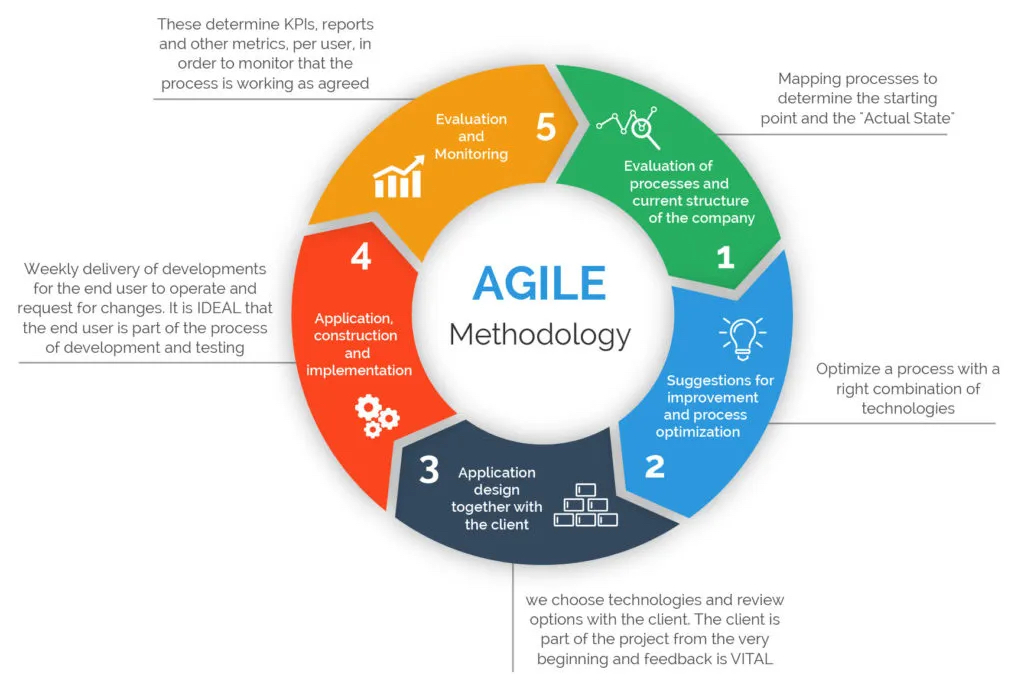
Introduction: Development
This workshop will provide leaders with time and space to think and ask important questions. Leaders will develop their own playbook to move you forward based on the principles and practices established in this course.
In order to achieve MVV alignment, we have found these principles to be true. First, structured and focused conversation around the organizational, team, and personal MVV creates significant alignment. Next, there is an increase in clarity of understanding and appreciation of the MVV. Often this can be taken for granted, or there are assumptions that everyone understands the MVV. Alignment must be achieved, rather than assumptions. When there is proactive dialogue about the MVV it becomes more real and relatable (not just a plaque on the wall). This results in an increase in “ownership” of the MVV. What does it mean for us during this time, with this group of people working towards these goals? With greater clarity of understanding, the leadership team can communicate with one voice to the teams in the organization.
The Optimized Leader understands they are responsible for ensuring there’s clarity and alignment on why the organization or team exists (mission), where it’s going (vision), and how it’s going to get there in terms of behaviors (values). Change is constant. MVV alignment is a required skill that can be learned. MVV needs to be centered in leadership conversations regularly during change. There can be many opportunities to re-align on MVV at key decision points. How does it help us further our mission? Is there a way it increases our values? Does it align with our vision? MVV doesn’t have to change, but our understanding of it and how we apply it evolves. It may look and feel different than 20 years ago. Constantly taking opportunities to apply with agility the MVV during change over time.
Introduction: Implementation
This workshop is a foundational part of the Optimizing Leadership process. Participants will focus on obtaining clarity and commitment around the MVV for themselves personally and from their team members. In order to achieve clarity and commitment, there are several layers to consider. Identifying certain myths, barriers, or blindspots during the implementation process is critical to creating guardrails from falling into pitfalls. Some examples may be: “I don’t have time for this.” “It doesn’t matter.” “It’s not as important as my top priorities right now.” “I am feeling overwhelmed or stuck.” “What if we don’t agree? If that happens, it can create more frustration.” “It’s easier to focus on the daily fires instead of taking a step back and looking at the big picture.” “It feels more productive and valuable use of time to focus on the day-to-day, whereas this feels unproductive.”
How can leaders respond to these questions or obstacles? Participants will learn how to ask questions so “myths” will not continue. Using the method of question and response, participants will learn the necessary skills of how to navigate these crucial moments. Participants will roleplay—one leader makes the statement, and another models how to move forward through the conversation with credible challenge. For instance, when a leader is given a moment to pause and consider which of the priorities most directly identifies with MVV, this honors their need to focus on their priorities, allows them to align their actions with “the why,” and provides an opportunity to pause and think differently about it. They also may consider which values can be applied to the priorities as a team.
This leadership skill of credible challenge displays an assertiveness that prevents stagnation and creates momentum, innovation, and alignment. During the implementation process, acknowledgment is important. Stating this is a critical thinking opportunity and creating space for brainstorming provides an opportunity for the team to apply MVV and teaches organizational intelligence. Organizational intelligence is a learned skill. There can be a risk of an assumption that leaders know this, but they may not have this knowledge or skill. At this point of implementation, humility and pause are required. When there is pressure or inflated ego, it does not facilitate organizational intelligence. It is the organizational leader’s priority to align the organization on MVV. Participants will create a “cheat sheet” on how to do this, daily, weekly, and organizationally.

Introduction: Case Study
Leadership Alignment energizes a multinational organization and increases the stock price by 170%
A multinational biopharmaceutical company hired a new CEO to improve operational efficiencies and accelerate the company’s growth. Recently, the company went through a crisis concerning the safety of a released drug. The newly hired CEO saw an opportunity to improve the culture and align the leadership of the organization. To accomplish this, the CEO worked with the executive leadership team on alignment and enterprise strategy. Then the CEO completed a similar process with the other business divisions.

Photo by Cedrik Wesche on Unsplash
This resulted in Leadership Alignment by clarifying strategy, setting the stage for strategy implementation by engaging and aligning the organization, and driving the senior team to optimized performance. Leadership Alignment also increased trust and unified the group around a single strategic view of the business and its MVV.
The executive leadership team engaged with the rest of the layers of the organization in this leadership alignment process and incorporated their feedback into the strategy, which increased buy-in and efficiency. The impact of this program was significant. The majority of program participants have either risen to more senior-level positions in the organization or have gone on to C-Suite positions in other organizations.
The organization’s engagement rates increased significantly following the Leadership Alignment process. This resulted in improvements in culture change and increased the organization’s stock price by 170%, along with the rollout of two breakthrough drugs and associated treatments.
Introduction: Management
When managing the process of alignment for MVV there will be many things to consider and many opportunities to do so. The alignment process is not “once and done” or “check it off the list.” It will be an ongoing process with many opportunities for improvement. Participants will have the opportunity to reflect on why healthy change is happening or not happening. There will be tools utilized and created for leadership alignment. Learning and development often happen in real time in the field of play. If there’s conflict in the team, it often comes down to values misalignment. What one holds dear as really important to them can be different than what others hold dear. There are several layers worth considering: organizational/company values, team/department values, individual values, and varying opinions. If teams aren’t aligned about values as a team, it will often get in the way and create unnecessary tension. Certainly, there won’t be 100% alignment, but “anchor” values are necessary to create alignment. These are 2-4 values that are strongly agreed upon. During change or conflict, these anchor values can serve as a reminder of what everyone collectively feels is important. Values alignment creates more shared meaning. “When we feel stuck, reflecting on our values can provide a helpful pause, allowing us to find solutions through the lens of our values.” This creates alignment to govern how we behave so anyone can be called into the values. This management of the alignment process also creates emotional safety and trust.

Photo by Alvaro Reyes on Unsplash
There are many benefits to creating and practicing group norms. More efficiency in decision-making. High level of buy-in and employee engagement. This looks like higher motivation to be all in, go above and beyond, etc. Managing this process well will result in greater levels of consistency and stability. Core values offer a strong foundation, ensuring consistency in actions and decisions even during difficulty, change, or uncertainty. This stability increases trust and confidence among employees, stakeholders, and customers. Also, this results in greater emotional safety and trust. The brain feels a sense of safety to function better as the environment is more predictive. Customer relations improve. When a leader is dealing with customers and there’s a value misalignment, this can cause many problems. However, managing value alignment with clients results in more cohesion, longer relationships, and an increase in the quality of customer relationships.
Managing a strong process of MVV alignment not only attracts talent, it results in increased retention and reduces costs. A strong values-driven culture attracts and retains talent, as individuals are attracted to join organizations that reflect their own beliefs and principles. As an example of reducing cost, COOs with low-value alignment needed a 40% salary increase to stay as long as those with high-value alignment. When values are aligned, numbers improve. Customer satisfaction, employee engagement, reduced turnover, and lower employment costs—all are data points to show it. So when values are aligned, organizations don’t need to pour extra money into keeping people.
According to a report by Gallup, employees who strongly agree with the statement “I feel connected to my organization’s culture” are 3.7 times more likely to be highly engaged at work.
A decade-long survey by McKinsey of over 5,000 executives found that alignment is crucial for great teamwork. With direction, teams that share beliefs about company goals and their roles in achieving them perform at higher levels.
Introduction: Review

Photo by Jason Goodman on Unsplash
Participants will have the opportunity to gauge results and receive input from other participants and team members. This information will enhance the review process and create insight into what adjustments would be most helpful. Using a critical review process will enable the leader to create momentum for continual improvement. This momentum is an essential part of producing critical mass. This critical mass is a significant measurement for success when leading change and improvement.
An additional component of the review process is “gap naming” and assumption identifying. There can be many assumptions that create a risk of misalignment during the MVV process. Left unidentified creates a risk for an inadequate change process. An example of an assumption can be that this process is motivating for others just as it is for you or that others have the same perspective of the value of this process and it goes unsaid. When discussed, it creates an opportunity to clarify the common values and what is meant by them. This process also identifies if there are gaps or misalignments.
For gap naming, a simple review process can be utilized. First, define the gap. Ask, What does that gap produce? What’s the impact? What emotions are a result—anxiety, negative attitudes?
Are we okay with the impact? Do we want to make a change? If so, name the change and give it a priority level. Then create 3 specific actions that can be accomplished in the next 10 days to close the gap. Evaluate. How do you know if the gap has been closed? Are there new results? The review process is critical to creating optimized success.
Executive Summary
Chapter 1: Mission Critical
This program is ideal for the leader who is looking to optimize their leadership, their team, and their organization and take things to the next level. The leadership journey is filled with peaks and valleys. There are many challenges and opportunities for change and going to the “next level.” What are some current challenges you are facing or have faced recently? Could you optimize and scale your leadership impact to create positive momentum and navigate change? Specifically, the program focuses on leaders ready to take their leadership to the next level and seeking to gain additional insights and skills to optimize their leadership impact.
There are 12 courses in workshop 1 “Leadership Alignment”. Each course or section will have specific outcomes and exercises, along with a process to produce the outcomes. The first course is “Mission Critical.”
Mission Critical

Photo by David Iskander on Unsplash
Living, breathing, and leading with the “why” is at the heart of effective leadership. Knowing, communicating, and living your company’s values, vision, and mission will keep you and your leadership team aligned and anchored during seasons of change or transition. Why is the marketplace better for having your company in it? KPO: During this workshop, you will gain greater clarity on your MVV, why it matters, what the impact is, how/who/when to communicate it, and how it aligns with your personal MVV. Insight into how it aligns with your senior leaders’ personal MVV can increase alignment and top talent retention.
The core foundation of any organization (or any leader) is its mission, vision, and values. Having clarity on your “why” as a leader is at the core of optimizing leadership. If a “mission statement” is simply a plaque on a wall and not embodied, embraced, and breathed, then this will limit optimizing leadership impact. You will gain the simple tools and effective processes for optimizing mission, vision, and values with clarity.
During this workshop, we will use the UAE process method to ensure optimized leadership alignment for MVV. UAE stands for Understanding, Analysis, and Efficiency. First, we must establish a clear and common understanding of terminology and its importance to leadership alignment and organizational or team outcomes. Without this clear understanding, many assumptions can be made, and the leadership journey can be at risk of many pitfalls and derailers. Next, we will establish sound analysis methods for you to use. This not only strengthens critical thinking skills for you and your team, but it also eliminates any leftover assumptions from the understanding part of the process. Lastly, we will focus on efficiency to identify what’s working, what’s not working, what are the gaps, and what improvements need to be made to achieve desired outcomes most efficiently.

Chapter 2: Common Understanding
When we create understanding with others, this increases our alignment and optimizes our outcomes. The role of every leader is to display behaviors that increase alignment. Alignment does not need to mean full agreement. Every person’s input has value, although there certainly will be differing ideas. To create a common understanding, it will be a process of word definition and meaning clarification. For instance, the word “good” may have many different meanings, and understanding those meanings will be essential.

Photo by Zuzana Ruttkay on Unsplash
Once a common understanding is established, it creates a simple and smooth process to repeat this practice in other areas of the business or objectives for the team. Active Listening is an important skill to practice at this stage of the Leadership Alignment process. The chart below illustrates the Active Listening process.
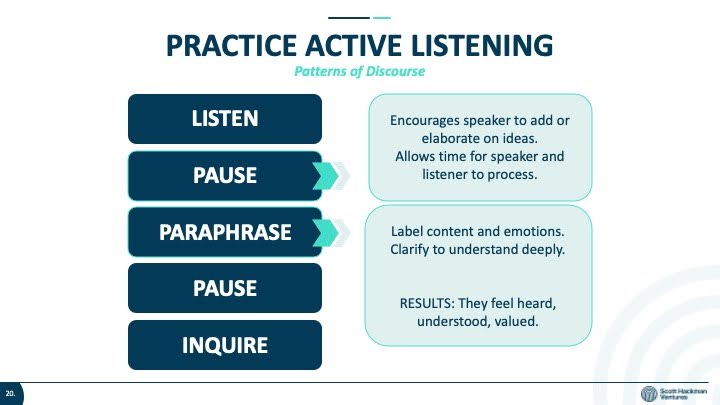
When others experience the impact of being actively listened to, they feel heard, understood, and valued. This will establish a baseline for common understanding. Another result of the active listening process is appreciation. It can be easy during a conversation of idea sharing for people to compete for air time or compete for their idea or perspective to win out. This often does not result in common understanding. In order to achieve common understanding, there will need to be a commitment on the part of the leader to establish this understanding as much as possible and within reasonable time constraints. If this common understanding phase in the process is overlooked, skipped, or stymied, it can create adverse effects later in the process.
One final consideration when seeking to create common understanding is feedback checks and balances. Often people may simply “nod their head” to indicate understanding. This can be a very limited way to display understanding. A better practice would be for participants to formulate critical thinking questions, share them with a partner, and reflect back to the group what they discussed. This will deepen the common understanding and also increase participation.

Chapter 3: Phrase Alignment
Keyword phrases are essential to clear communication. An essential leadership skill is knowing how to create powerful and memorable words and phrases that inspire and illicit action. Words matter. How leaders use words to inspire, illicit action or change, find common understanding, and create meaning can have a significant impact on productivity, understanding, engagement, trust, and collaboration. The chart below illustrates the significant impact that clear and compelling communication can have.

Photo by Arno Senoner on Unsplash

When crafting your mission, vision, and value statements, you should seek to ensure that the words and phrases used are easily understood. This will help increase understanding and efficiency. If people are able to understand easily, this will create inspiration, which will result in actions or behaviors that align with your mission, vision, and value statements. If there is confusion, lack of clarity, or it feels cumbersome or complicated, this can have a demotivating impact and result in little to no action, or even worse yet, the opposite action you are seeking. How will you know if your chosen words are easily understood? Ask. Ask your team members; ask your friends or family. Ask if there may be a more clear and easily understood way to say what you mean. Often, when people are in the midst of creating mission, vision, and value statements, they may be too close to the ideas and lose sight of a simpler, more clear way to say something.
Consider how many action-oriented words you use in your mission, vision, and value statements. Are there verbs? Which words are action-oriented verbs? Are they past tense, present tense, or future tense? Are there words that end in “ing” to communicate process-oriented action? When mission, vision, and value statements have multiple action-oriented words, they have life and movement. When there is life and movement, people are motivated toward action. It also creates a sense of energy, enthusiasm, and inclusion. In other words, it won’t feel like it’s already been accomplished, completed, or decided. It will create curiosity, wonder, and a desire to get involved in the energy and action.
There are several other considerations when crafting keywords and key phrases for your mission, vision, and value statements. How meaningful is it? People are seeking meaning and want to be involved in something that gives their lives meaning. How do your mission, vision, and value statements offer meaning to others? When you are evaluating your statements, also consider simplicity. What is the simplest way to say this? Test your simplicity factor by getting feedback from others who are not on your team or in your organization. After gaging simplicity, consider how memorable your phrases are. Are the words that have natural emphasis? To measure memorableness, try the “30 test.” Could someone memorize your statements in thirty seconds and recall them in thirty minutes or thirty days?

Chapter 4: Impact Awareness
An essential skill of optimized leaders is having an awareness of their leadership and communication with others. When executed with excellence, MVV has a high potential for optimizing impact. How we communicate, the words we use, and their meaning have a direct impact on others. In fact, when leaders communicate (verbally, nonverbally, written, video, visual, and not communicating), they have the power to create culture. This culture will be interpreted and reinforced by responses, behaviors, feedback, attitudes, and actions.

Photo by Mimi Thian on Unsplash
There are many factors to consider when measuring impact on others and your awareness of this. The chart below illustrates what creates an impact on others. The greatest impact one can have on others is how you make them feel. Emotional Sensitivity + Empathy + Active Listening = 70% of your impact on others. What does this have to do with mission, vision, and value statements? Considering how your MVV statements make others feel will give you great insight into their impact. The reason impact is important is because without impact, very little will grow, change, improve, or increase in your team or organization.
The following key categories contribute to “impact awareness” and their importance.

Emotional Sensitivity: Being aware of how your actions affect others’ emotions (35%). This aspect makes up the highest percentage of impact awareness, and rightly so. But how do you know how your actions affect others’ emotions? There are several ways: ask them, read the room, discern body language and facial expressions, ask others how you came across, reflect and adapt, utilize 360 feedback, etc.
Empathy: Understanding and sharing others’ feelings (25%). For some, this comes naturally. For others, it is a learned skill. For leaders, it is essential and non-negotiable.
Communication Skills: Ensuring clarity and understanding in communication (20%). This is not only true and essential in MVV work but in all aspects of communication. A case could be made that the measure of a leader is how you make others feel and how well you communicate.
Social Responsibility: Considering the broader consequences of one’s actions (10%). This will be essential when crafting and evaluating both your impact awareness score and your MVV.
Active Listening: Paying attention and responding to feedback (10%). See the prior chapter for more on active listening and how to practice it.
When combining understanding with skill development in these essential impact awareness categories, optimizing leaders will continue to learn, strengthen their skills, and have a keen insight into how they are optimizing. This insight will also provide a clear resource when training and equipping other leaders to optimize their leadership skills, mindsets, and behaviors. When leaders teach others how to be leaders, this actually increases their own leadership skills and capacity.

Chapter 5: Adaptive Analysis
Identifying what is working and what is not working with your MVV, communication, and alignment is a crucial next step in the Leadership Alignment course of the Optimizing Leadership process. Although the essence of your mission may not change, how you communicate it and how aligned others are with it will need constant adaptive analysis.
The value of adaptive analysis is that it allows very little, if any, room for assumption and glazing over core essentials for leadership. Utilizing an adaptive analysis process for your MVV will result in greater clarity, confidence, collaboration, and leadership team alignment.
This illustration shows a sample of an adaptive analysis process.
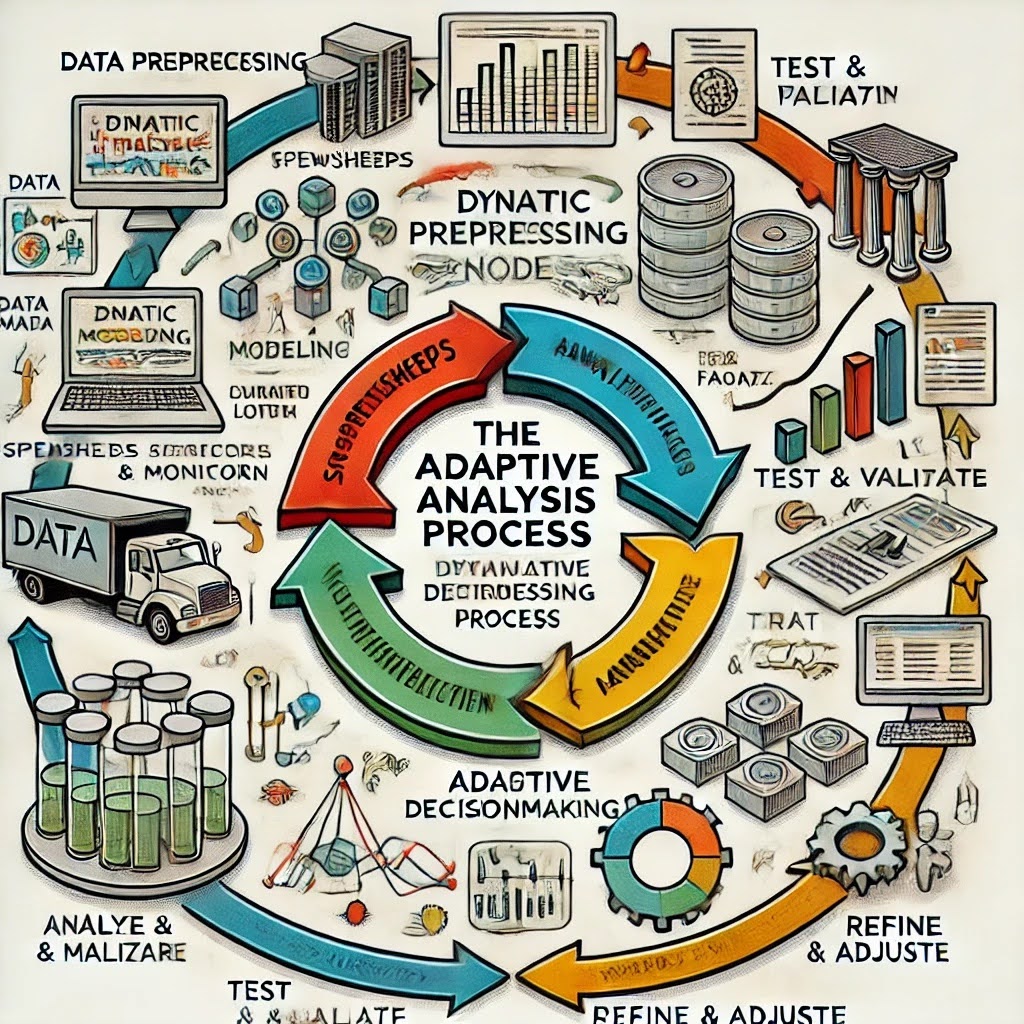
The adaptive analysis process components are:
Input Data: This can represent multiple sources of raw data (e.g., numbers for spreadsheets, databases, user feedback, etc.).
Data Preprocessing: This step is important for cleaning and organizing data. This can include filtering, transformation, and standardization.
Dynamic Modeling: A central circle illustrates adaptation to incoming changes, with arrows showing feedback loops and iterative analysis. This process may have sub-elements like predictive models, machine learning algorithms, and simulations.
Decision-making Loop: This can be a continuous cycle from analysis to insights, depicted as a circular loop with arrows. Each step in this loop could include:
● Analyze & Monitor
● Test & Validate
● Refine & Adjust
Feedback: This will be essential for adaptation. The arrows go back to the dynamic modeling node from insights, showing that insights lead to further analysis in a loop.
Adaptation: This is the final component showing adaptation. An arrow leads back to the input data phase. This indicates that the process is cyclical and there will be adjustments to new inputs and evolving data.
During the Leadership Alignment course, the MVV will be the focus of the adaptive analysis. Participants will analyze each component of their MVV and make adjustments. This process will include self-analysis, peer analysis, department head analysis, and adaptation based on this feedback. Not only will this create greater understanding, buy-in, and passion for the MVV, but it will also strengthen optimizing leadership skills around core essential concepts pertaining to the MVV. The reason this provides high optimizing value is that it results in a concept called extreme ownership. In other words, this is not someone else’s MVV; this is my MVV. With the personal ownership of the importance and value of one’s own MVV comes a greater understanding, appreciation of, and passion for their MVV. When this is the result, others follow and are drawn to an optimized leader with this clarity, skill, and passion. It is very powerful.

Chapter 6: Increasing Alignment
Knowing how aligned you, your team, and your people are to your MVV and how to increase alignment is a significant skill for optimizing leadership. There can be a risk of, “ah, we’ve arrived and we are fully aligned.” Don’t fall into this pitfall! (more to come about alignment pitfalls in the next chapter.) Maintaining and increasing alignment takes dedication, focus, and steady work. At times, leaders may feel “alignment fatigue.” They may say, “I already have a full-time job, producing xyz results, products, or revenue.” “I can’t worry about leadership team alignment!” “It’s too much!”. If you have said this, felt this, or thought this, take care; you are not alone. This is common on the optimizing leadership journey and simply means you may need a break to catch your breath or that you and your team are on the verge of a breakthrough.
So what is alignment, and how does an optimizing leader know how aligned they and their team are to their MVV? And why does it matter?
This chart illustrates what alignment looks like and when teams are misaligned.

When there is a healthy dose of team alignment, there are many positive results. There is an increase in efficiency, both in communication and project/product outcomes. Goal achievement and celebration are a common occurrence for aligned teams. There is often a feeling of “ease” when executing on work. This may not necessarily mean the work is easier, but there will be a feeling of ease due to alignment. It just feels better or feels right. Focus and clarity will be the norm for aligned teams when it comes to tasks and communication. There often are clear paths or channels of workflow for aligned teams as well. All of this will naturally produce optimized levels of team engagement and high retention rates for employees. This all sounds wonderful, certainly. Is it attainable? And if so, how does an optimized leader retain or increase this level of alignment on a regular basis?
First, let’s be clear about how it looks and feels when a leadership team is not aligned. You may have had this experience in the past or could be experiencing it currently. It usually doesn’t feel very good, nor is it fun. It also creates great difficulty to get “in the zone” of workflow and may possibly impede health and a good nights sleep! Misalignment on teams often causes frustration, confusion, inefficiencies, missed opportunities, or waste of time and effort. I’m not sure how many people would like to stay in a regular cycle of those experiences. I believe most people want to experience the affects of team alignment but may not be sure how to create it or may think it’s another person’s responsibility to do so. Not so for the optimizing leader. The optimizing leader can quickly recognize misalignment and knows the “optimizing leadership moves” that will swiftly initiate alignment and increase the level of alignment to an optimized level.
When mistakes happen or deadlines are missed, the optimizing leader recognizes this as a sign or opportunity for increasing alignment. Rather than shame, guilt or punishment, the optimizing leader will rally the team around the MVV and analyze how the team behaviors are aligned or misaligned with the MVV. Then they will open a conversation about what is needed to be successful in fulfilling their MVV and what might be getting in the way. This critical thinking inclusive conversation allows for full team engagement and positive actions to provide solutions.
If goals are missed or their is confusion about how to measure and achieve goals, the optimizing leader will incorporate key words or phrases from their MVV that inspire clear action, and it creates the desire to accomplish goals together as a team. There is a spirit of celebration rather than criticism that results. This becomes positively contagious and begets further goal-setting, accomplishment, and celebration. It creates a winning culture.

Chapter 7: Alignment Pitfalls
When optimizing leaders are seeking to increase and maintain leadership team alignment it will be critical for them to identify common mistakes, pitfalls, and derailers for MVV alignment and how to avoid them or overcome them. In this chapter, we will explore some of the most common alignment pitfalls, how to identify them, how to avoid them, and what to do if you find you or your team stuck in one or more of them.

Photo by Beth Macdonald on Unsplash
Another alignment pitfall can be cynical criticism. This is very different than a critical thinking open conversation. In fact, inviting team members to engage in a critical thinking open conversation is one way to avoid or work beyond the cynical criticism pitfall. So what is cynical criticism, and how does it create a pitfall impact? Cynical criticism comes from someone who believes people are only motivated by self-interest and that they only do things that benefit themselves. The term “cynic” comes from the ancient Greek Cynics. The Cynics rejected conventional goals of wealth, power, and honor. They believed that virtue was the only good and that self-control and independence were its essence. This creates a mindset or behaviors of being deeply distrustful. To be cynical implies that one has a strong disbelief in sincerity or integrity. To move beyond this pitfall, optimizing leaders will challenge that disbelief by engaging in critical thinking conversations and not allow one or two individuals to sour the team’s alignment.
While working to understand, avoid, and move past alignment pitfalls, the optimizing leader will be aware of several other pitfalls. These can include, but are not limited to, inattention to details and group or individual derailer behaviors (for more on derailer behaviors, visit https://www.hoganassessments.com/). Another pitfall or mistake that often is made is the lack of regular reconnection or meaningful conversation about the MVV. The MVV is a central part of the optimizing leadership journey and should be given the highest priority of attention and alignment work.

Chapter 8: Realignment
At times, organizations, teams, or individuals may get “off course” or need a refresh. MVV realignment is crucial in these moments. Identifying realignment actions and outcomes will be an important initial step. When optimizing leaders notice this opportunity, often this will come in the form of a strategic pause. A strategic pause is an important habit of optimizing leaders. These are critical moments of noticing or reflection when one realizes there is a need for clarity, motivation, or realignment. When this pause happens, a reflection question can enter. “What is needed right now for my team to realign with our MVV?” “What habit, practice, behavior, or action can I do today/this week to create an MVV realignment moment for momentum?” This strategic pause and reflection question will provide the optimizing leader with an opportunity to clarify their intention.

Photo by Illiya Vjestica on Unsplash
There are several activities that can be implemented to create realignment. One habit or action can be to have a simple 15-minute conversation with your team about your MVV. This could be a stand-alone or stand-up meeting, or it could be at the beginning or end of another meeting. If you want it to stand out and feel significant, then I recommend having it as a stand-alone “stand-up” meeting. The optimizing leader can call the meeting with a simple agenda of a 15-minute conversation about the teams MVV. Start by saying that during your strategic pause this week you have noticed an opportunity and need to realign with the MVV. Clarify that the purpose of this meeting is not to solve problems or create action plans. It is simply to reconnect with and realign with your MVV. Then ask if others have sensed a need or opportunity for this. If yes, ask about what. If no, simply pick one of the statements (mission, vision or values) to look at together, read all or a portion out loud, and then ask, What are some specific examples of how you saw this in action this week? Conclude the meeting on time. If there is a clear need for further conversation, let the team know you will be scheduling a deeper dive conversation about ____ (where you see the most need for more conversation). Identify that the purpose of this meeting will be a MVV critical thinking open conversation. Invite all to attend. Clarify if this meeting will be opt-in or mandatory.
When you have an MVV critical thinking open conversation, there will be a need to identify the purpose/outcome of the meeting and establish some ground rules. Typically, this meeting is not intended to “rewrite” a document (that can have a different process at a different time if necessary). An opening question can be, “If you could change 1 thing about the MVV, what would it be?” Facilitate a flowing conversation with all participants practicing active listening and write down key words, thoughts, or phrases. Limiting this meeting to one hour will be best, unless this is part of a team retreat. A second question could be, “What word or phrase in the MVV do you feel most energized by? Most confused by?” These questions can also initiate a lively conversation for sure, which will increase enthusiasm from the team for the MVV and increase realignment as well.

Chapter 9: Gaining Traction
In this section, we will be exploring learning the optimizing leadership skills, leadership moves, and actions to take in order to gain traction once you have created MVV alignment. So what is traction? It is the action of drawing or pulling something or the grip of something on another surface. In this case, the surface is alignment culture. Once you gain momentum, it will be critical to keep clearly identifying and acting on alignment behaviors. Often these behaviors will be displayed by alignment champions on your team. An alignment champion is simply a team member who “gets it” and sees how the alignment and cohesion are working and producing the desired results. These individuals will quickly create momentum to keep and protect the alignment that has already been created. This positive movement forward will spread to others as well.

Photo by Slidebean on Unsplash
Another traction factor to consider when working on your team alignment is creating what is called critical mass. One aspect of critical mass is defined as a point at which the rate of change of alignment or the gradient of the alignment curve changes upward in volume and direction, which leads to an exponential increase in the adoption of a change or greater alignment by team members.
This rudimentary chart visually illustrates the basic principles of critical mass. The X-axis (horizontal) represents time or effort/input. The Y-axis (vertical) represents the percentage of adoption, reaction/impact, or output (e.g., number of people involved in a movement, energy released, etc.). The left portion of the curve (subcritical) is slow growth, a flat line with minimal change, representing little reaction or influence. The middle portion (critical mass) is where the curve starts to steepen as the input begins to create significant reactions. This is the point of critical mass, where the system’s reaction becomes self-sustaining. The right portion (supercritical) is where the curve levels off again, showing a plateau as the reaction reaches its maximum potential or stabilizes after a large chain reaction. Typically in organizations “Critical mass” is considered to be reached when around 20–30% of a group actively supports or participates in a change or initiative. This is the point where momentum builds and wider adoption becomes more likely.

In order to accomplish critical mass for leadership and team alignment, it will be important to establish “traction habits.” These are daily or weekly actions or tasks that a leader can take to increase critical mass traction and decrease the amount of time it takes to get there. What are your traction habits? A few to consider are: recruiting alignment champions; sending daily or weekly emails to the group with updates on alignment; having intentional alignment conversations; and setting alignment goals or deadlines. An additional traction consideration is creating alignment feedback loops. These are checkpoints that you can create to ensure your alignment message is being communicated through proper channels. These can also be clear opportunities for team members to ask questions and engage in alignment conversations.

Chapter 10: MVV Stamping
Stamping is one of my favorite leadership skills to illustrate. Stamping is a necessary leadership skill for optimizing leaders. So what exactly is stamping? When actions, words, or situations illustrate MVV, optimizing leaders “stamp” those moments to increase clarity, momentum, and motivation. The leaders will say, “Yes, that’s exactly it” or, “I’d like to stamp what you just said or did—it is a great example of MVV alignment, here’s why.” The reason this is important and highly valuable is because it accomplishes several things at once. First, the leader notices the stamping moment as a valuable moment for team alignment. Second, the leader decides to act in a positive manner, which highlights the MVV alignment. Third, the person who says or displays the MVV alignment behavior receives affirmation and recognition. Fourth, the team can easily take note of specific examples of words or behaviors that they too can emulate. Also, if there are individuals on the team who are not yet aligned, this stamping moment is another opportunity to draw them in and create alignment traction and alignment critical mass.

Photo by melanfolia меланфолія on Unsplash
Once the optimizing leadership habit catches on within your team, it will be hard to stop. Don’t worry, you don’t want it to stop; its a great habit. An additional optimizing leadership habit can be to begin documenting “stamping” moments. It’s one thing to say it and acknowledge it; its an added layer of “stickiness” to write it down in meeting notes or even record it if you are able to. These stamping moments can be highly valuable when you evaluate your MVV alignment culture, are training or onboarding new team members, or are reporting up in the organization.

Chapter 11: Positive Reinforcement
It’s been said that what gets talked about and rewarded gets done in organizations. What do you and your team talk about? How much percentage of time per day or per week do you spend on MVV alignment? What alignment results are you seeing? Do they match what you want? Your team and organizational system are perfectly designed to get the results you are getting. If you want different MVV alignment results, then you will need to understand, analyze, and adapt your system to increase your MVV alignment efficiencies.
An effective MVV efficiency strategy can start with identifying a “reward system” when actions and words are shown by others (and yourself) that optimize MVV alignment. For instance, you are in a team meeting about a new product line. One of your team members asks, “Why are we spending so much time on this new product line? How is it helping us fulfill our purpose to make the world better by improving our industry? This is a fabulous MVV alignment moment to capitalize on. Although the team member may be irritated by the amount of time spent, they are trying to understand how the amount of time is equal to fulfillment of the established purpose. There can be many ways to respond in this moment. An effective strategy would be to offer praise and thanks first by saying, “Yes! Thank you so much for aligning what we are doing in this moment with our overall purpose and mission as a team and organization. That is exactly the kind of optimizing leadership behavior we value that keeps building MVV alignment. That’s awesome!” This can be followed up by saying, “I’m curious; do you have an expectation on the amount of time that would be ideal to collaborate on this new product line? Do you see opportunity for greater MVV alignment here and perhaps an increase in efficiency? Tell me what you see…”
A response like this does a number of things. First, for the optimizing leader, you increase your optimizing leadership skill and strength. Second, for the team, you align and focus their attention in a positive way on MVV alignment and the value of it when making daily decisions (for instance, how much time is spent in a meeting on an item). Third, for the individual who asked the question, you make them feel heard, valued, and understood in a very positive way. You are actually naming the MVV alignment strength they just displayed and inviting them to think critically to build strength on strength. These can be very powerful MVV alignment moments to optimize.
There are many positive reinforcement habits you can cultivate. For instance, try identifying three key MVV behaviors for thirty days that you will highlight, name, expect, and celebrate. These could be a simple poster on your team meeting wall, a daily reminder on your team calendar, at the top of each team meeting agenda, or notes. Perhaps give a fun and simple reward to the person you saw display each of these MVV alignment behaviors the most this month. This can create a fun and positive success pattern that you can repeat with three new MVV alignment behaviors for the next thirty days. Try it; it could be fun!

Chapter 12: Strength Building
One of the best ways to increase your team and organization’s MVV alignment is to build strength on strength. It can be tempting to focus on the negative, the gaps, and where there might not be enough alignment. Don’t start there or fall into that trap early in the process. There will come a time to close those gaps and reduce the negative impact of those MVV alignment weaknesses. Start by focusing on strengths and building on those strengths of MVV alignment. This will create easy and early MVV alignment wins and create positive outcomes. Once this happens (usually within the first two weeks), it will be much easier to recruit MVV alignment champions and start to see when you can expect the 20-30% momentum of critical mass.

Photo by Markus Spiske on Unsplash
Next, you can consider and have some team conversation around what positive impact your leadership alignment and MVV alignment have had on your customers, market share, stock increase, and revenue increase. Are there numbers or testimonials you can gather? How can you share those stories and this information well? This will become a “mini-campaign” as you seek to increase your optimizing leadership alignment through your MVV work.
Once you have established your starting strengths, you can create a quarterly reflection habit—what struggles did we go through as a team or organization in the past quarter or six months? What have been some MVV alignment strengths that resulted? What are we learning through this MVV alignment process? What are our next steps to build strength on strength?
Now that you will have worked through a strong process of building and increasing leadership alignment through MVV alignment, what value have you gained? Looking back, what do you now know that you didn’t know at the start of this process? What would you like to learn in the next phase of this optimizing leadership journey? Who else can you invite into this process of learning with you? Anything else?
Curriculum
Optimizing Leadership – WDP1 – Leadership Alignment
- Mission Critical
- Common Understanding
- Phrase Alignment
- Impact Awareness
- Adaptive Analysis
- Increasing Alignment
- Alignment Pitfalls
- Realignment
- Gaining Traction
- MVV Stamping
- Positive Reinforcement
- Strength Building
Distance Learning
Introduction
Welcome to Appleton Greene and thank you for enrolling on the Optimizing Leadership corporate training program. You will be learning through our unique facilitation via distance-learning method, which will enable you to practically implement everything that you learn academically. The methods and materials used in your program have been designed and developed to ensure that you derive the maximum benefits and enjoyment possible. We hope that you find the program challenging and fun to do. However, if you have never been a distance-learner before, you may be experiencing some trepidation at the task before you. So we will get you started by giving you some basic information and guidance on how you can make the best use of the modules, how you should manage the materials and what you should be doing as you work through them. This guide is designed to point you in the right direction and help you to become an effective distance-learner. Take a few hours or so to study this guide and your guide to tutorial support for students, while making notes, before you start to study in earnest.
Study environment
You will need to locate a quiet and private place to study, preferably a room where you can easily be isolated from external disturbances or distractions. Make sure the room is well-lit and incorporates a relaxed, pleasant feel. If you can spoil yourself within your study environment, you will have much more of a chance to ensure that you are always in the right frame of mind when you do devote time to study. For example, a nice fire, the ability to play soft soothing background music, soft but effective lighting, perhaps a nice view if possible and a good size desk with a comfortable chair. Make sure that your family know when you are studying and understand your study rules. Your study environment is very important. The ideal situation, if at all possible, is to have a separate study, which can be devoted to you. If this is not possible then you will need to pay a lot more attention to developing and managing your study schedule, because it will affect other people as well as yourself. The better your study environment, the more productive you will be.
Study tools & rules
Try and make sure that your study tools are sufficient and in good working order. You will need to have access to a computer, scanner and printer, with access to the internet. You will need a very comfortable chair, which supports your lower back, and you will need a good filing system. It can be very frustrating if you are spending valuable study time trying to fix study tools that are unreliable, or unsuitable for the task. Make sure that your study tools are up to date. You will also need to consider some study rules. Some of these rules will apply to you and will be intended to help you to be more disciplined about when and how you study. This distance-learning guide will help you and after you have read it you can put some thought into what your study rules should be. You will also need to negotiate some study rules for your family, friends or anyone who lives with you. They too will need to be disciplined in order to ensure that they can support you while you study. It is important to ensure that your family and friends are an integral part of your study team. Having their support and encouragement can prove to be a crucial contribution to your successful completion of the program. Involve them in as much as you can.
Successful distance-learning
Distance-learners are freed from the necessity of attending regular classes or workshops, since they can study in their own way, at their own pace and for their own purposes. But unlike traditional internal training courses, it is the student’s responsibility, with a distance-learning program, to ensure that they manage their own study contribution. This requires strong self-discipline and self-motivation skills and there must be a clear will to succeed. Those students who are used to managing themselves, are good at managing others and who enjoy working in isolation, are more likely to be good distance-learners. It is also important to be aware of the main reasons why you are studying and of the main objectives that you are hoping to achieve as a result. You will need to remind yourself of these objectives at times when you need to motivate yourself. Never lose sight of your long-term goals and your short-term objectives. There is nobody available here to pamper you, or to look after you, or to spoon-feed you with information, so you will need to find ways to encourage and appreciate yourself while you are studying. Make sure that you chart your study progress, so that you can be sure of your achievements and re-evaluate your goals and objectives regularly.
Self-assessment
Appleton Greene training programs are in all cases post-graduate programs. Consequently, you should already have obtained a business-related degree and be an experienced learner. You should therefore already be aware of your study strengths and weaknesses. For example, which time of the day are you at your most productive? Are you a lark or an owl? What study methods do you respond to the most? Are you a consistent learner? How do you discipline yourself? How do you ensure that you enjoy yourself while studying? It is important to understand yourself as a learner and so some self-assessment early on will be necessary if you are to apply yourself correctly. Perform a SWOT analysis on yourself as a student. List your internal strengths and weaknesses as a student and your external opportunities and threats. This will help you later on when you are creating a study plan. You can then incorporate features within your study plan that can ensure that you are playing to your strengths, while compensating for your weaknesses. You can also ensure that you make the most of your opportunities, while avoiding the potential threats to your success.
Accepting responsibility as a student
Training programs invariably require a significant investment, both in terms of what they cost and in the time that you need to contribute to study and the responsibility for successful completion of training programs rests entirely with the student. This is never more apparent than when a student is learning via distance-learning. Accepting responsibility as a student is an important step towards ensuring that you can successfully complete your training program. It is easy to instantly blame other people or factors when things go wrong. But the fact of the matter is that if a failure is your failure, then you have the power to do something about it, it is entirely in your own hands. If it is always someone else’s failure, then you are powerless to do anything about it. All students study in entirely different ways, this is because we are all individuals and what is right for one student, is not necessarily right for another. In order to succeed, you will have to accept personal responsibility for finding a way to plan, implement and manage a personal study plan that works for you. If you do not succeed, you only have yourself to blame.
Planning
By far the most critical contribution to stress, is the feeling of not being in control. In the absence of planning we tend to be reactive and can stumble from pillar to post in the hope that things will turn out fine in the end. Invariably they don’t! In order to be in control, we need to have firm ideas about how and when we want to do things. We also need to consider as many possible eventualities as we can, so that we are prepared for them when they happen. Prescriptive Change, is far easier to manage and control, than Emergent Change. The same is true with distance-learning. It is much easier and much more enjoyable, if you feel that you are in control and that things are going to plan. Even when things do go wrong, you are prepared for them and can act accordingly without any unnecessary stress. It is important therefore that you do take time to plan your studies properly.
Management
Once you have developed a clear study plan, it is of equal importance to ensure that you manage the implementation of it. Most of us usually enjoy planning, but it is usually during implementation when things go wrong. Targets are not met and we do not understand why. Sometimes we do not even know if targets are being met. It is not enough for us to conclude that the study plan just failed. If it is failing, you will need to understand what you can do about it. Similarly if your study plan is succeeding, it is still important to understand why, so that you can improve upon your success. You therefore need to have guidelines for self-assessment so that you can be consistent with performance improvement throughout the program. If you manage things correctly, then your performance should constantly improve throughout the program.
Study objectives & tasks
The first place to start is developing your program objectives. These should feature your reasons for undertaking the training program in order of priority. Keep them succinct and to the point in order to avoid confusion. Do not just write the first things that come into your head because they are likely to be too similar to each other. Make a list of possible departmental headings, such as: Customer Service; E-business; Finance; Globalization; Human Resources; Technology; Legal; Management; Marketing and Production. Then brainstorm for ideas by listing as many things that you want to achieve under each heading and later re-arrange these things in order of priority. Finally, select the top item from each department heading and choose these as your program objectives. Try and restrict yourself to five because it will enable you to focus clearly. It is likely that the other things that you listed will be achieved if each of the top objectives are achieved. If this does not prove to be the case, then simply work through the process again.
Study forecast
As a guide, the Appleton Greene Optimizing Leadership corporate training program should take 12-18 months to complete, depending upon your availability and current commitments. The reason why there is such a variance in time estimates is because every student is an individual, with differing productivity levels and different commitments. These differentiations are then exaggerated by the fact that this is a distance-learning program, which incorporates the practical integration of academic theory as an as a part of the training program. Consequently all of the project studies are real, which means that important decisions and compromises need to be made. You will want to get things right and will need to be patient with your expectations in order to ensure that they are. We would always recommend that you are prudent with your own task and time forecasts, but you still need to develop them and have a clear indication of what are realistic expectations in your case. With reference to your time planning: consider the time that you can realistically dedicate towards study with the program every week; calculate how long it should take you to complete the program, using the guidelines featured here; then break the program down into logical modules and allocate a suitable proportion of time to each of them, these will be your milestones; you can create a time plan by using a spreadsheet on your computer, or a personal organizer such as MS Outlook, you could also use a financial forecasting software; break your time forecasts down into manageable chunks of time, the more specific you can be, the more productive and accurate your time management will be; finally, use formulas where possible to do your time calculations for you, because this will help later on when your forecasts need to change in line with actual performance. With reference to your task planning: refer to your list of tasks that need to be undertaken in order to achieve your program objectives; with reference to your time plan, calculate when each task should be implemented; remember that you are not estimating when your objectives will be achieved, but when you will need to focus upon implementing the corresponding tasks; you also need to ensure that each task is implemented in conjunction with the associated training modules which are relevant; then break each single task down into a list of specific to do’s, say approximately ten to do’s for each task and enter these into your study plan; once again you could use MS Outlook to incorporate both your time and task planning and this could constitute your study plan; you could also use a project management software like MS Project. You should now have a clear and realistic forecast detailing when you can expect to be able to do something about undertaking the tasks to achieve your program objectives.
Performance management
It is one thing to develop your study forecast, it is quite another to monitor your progress. Ultimately it is less important whether you achieve your original study forecast and more important that you update it so that it constantly remains realistic in line with your performance. As you begin to work through the program, you will begin to have more of an idea about your own personal performance and productivity levels as a distance-learner. Once you have completed your first study module, you should re-evaluate your study forecast for both time and tasks, so that they reflect your actual performance level achieved. In order to achieve this you must first time yourself while training by using an alarm clock. Set the alarm for hourly intervals and make a note of how far you have come within that time. You can then make a note of your actual performance on your study plan and then compare your performance against your forecast. Then consider the reasons that have contributed towards your performance level, whether they are positive or negative and make a considered adjustment to your future forecasts as a result. Given time, you should start achieving your forecasts regularly.
With reference to time management: time yourself while you are studying and make a note of the actual time taken in your study plan; consider your successes with time-efficiency and the reasons for the success in each case and take this into consideration when reviewing future time planning; consider your failures with time-efficiency and the reasons for the failures in each case and take this into consideration when reviewing future time planning; re-evaluate your study forecast in relation to time planning for the remainder of your training program to ensure that you continue to be realistic about your time expectations. You need to be consistent with your time management, otherwise you will never complete your studies. This will either be because you are not contributing enough time to your studies, or you will become less efficient with the time that you do allocate to your studies. Remember, if you are not in control of your studies, they can just become yet another cause of stress for you.
With reference to your task management: time yourself while you are studying and make a note of the actual tasks that you have undertaken in your study plan; consider your successes with task-efficiency and the reasons for the success in each case; take this into consideration when reviewing future task planning; consider your failures with task-efficiency and the reasons for the failures in each case and take this into consideration when reviewing future task planning; re-evaluate your study forecast in relation to task planning for the remainder of your training program to ensure that you continue to be realistic about your task expectations. You need to be consistent with your task management, otherwise you will never know whether you are achieving your program objectives or not.
Keeping in touch
You will have access to qualified and experienced professors and tutors who are responsible for providing tutorial support for your particular training program. So don’t be shy about letting them know how you are getting on. We keep electronic records of all tutorial support emails so that professors and tutors can review previous correspondence before considering an individual response. It also means that there is a record of all communications between you and your professors and tutors and this helps to avoid any unnecessary duplication, misunderstanding, or misinterpretation. If you have a problem relating to the program, share it with them via email. It is likely that they have come across the same problem before and are usually able to make helpful suggestions and steer you in the right direction. To learn more about when and how to use tutorial support, please refer to the Tutorial Support section of this student information guide. This will help you to ensure that you are making the most of tutorial support that is available to you and will ultimately contribute towards your success and enjoyment with your training program.
Work colleagues and family
You should certainly discuss your program study progress with your colleagues, friends and your family. Appleton Greene training programs are very practical. They require you to seek information from other people, to plan, develop and implement processes with other people and to achieve feedback from other people in relation to viability and productivity. You will therefore have plenty of opportunities to test your ideas and enlist the views of others. People tend to be sympathetic towards distance-learners, so don’t bottle it all up in yourself. Get out there and share it! It is also likely that your family and colleagues are going to benefit from your labors with the program, so they are likely to be much more interested in being involved than you might think. Be bold about delegating work to those who might benefit themselves. This is a great way to achieve understanding and commitment from people who you may later rely upon for process implementation. Share your experiences with your friends and family.
Making it relevant
The key to successful learning is to make it relevant to your own individual circumstances. At all times you should be trying to make bridges between the content of the program and your own situation. Whether you achieve this through quiet reflection or through interactive discussion with your colleagues, client partners or your family, remember that it is the most important and rewarding aspect of translating your studies into real self-improvement. You should be clear about how you want the program to benefit you. This involves setting clear study objectives in relation to the content of the course in terms of understanding, concepts, completing research or reviewing activities and relating the content of the modules to your own situation. Your objectives may understandably change as you work through the program, in which case you should enter the revised objectives on your study plan so that you have a permanent reminder of what you are trying to achieve, when and why.
Distance-learning check-list
Prepare your study environment, your study tools and rules.
Undertake detailed self-assessment in terms of your ability as a learner.
Create a format for your study plan.
Consider your study objectives and tasks.
Create a study forecast.
Assess your study performance.
Re-evaluate your study forecast.
Be consistent when managing your study plan.
Use your Appleton Greene Certified Learning Provider (CLP) for tutorial support.
Make sure you keep in touch with those around you.

Tutorial Support
Programs
Appleton Greene uses standard and bespoke corporate training programs as vessels to transfer business process improvement knowledge into the heart of our clients’ organizations. Each individual program focuses upon the implementation of a specific business process, which enables clients to easily quantify their return on investment. There are hundreds of established Appleton Greene corporate training products now available to clients within customer services, e-business, finance, globalization, human resources, information technology, legal, management, marketing and production. It does not matter whether a client’s employees are located within one office, or an unlimited number of international offices, we can still bring them together to learn and implement specific business processes collectively. Our approach to global localization enables us to provide clients with a truly international service with that all important personal touch. Appleton Greene corporate training programs can be provided virtually or locally and they are all unique in that they individually focus upon a specific business function. They are implemented over a sustainable period of time and professional support is consistently provided by qualified learning providers and specialist consultants.
Support available
You will have a designated Certified Learning Provider (CLP) and an Accredited Consultant and we encourage you to communicate with them as much as possible. In all cases tutorial support is provided online because we can then keep a record of all communications to ensure that tutorial support remains consistent. You would also be forwarding your work to the tutorial support unit for evaluation and assessment. You will receive individual feedback on all of the work that you undertake on a one-to-one basis, together with specific recommendations for anything that may need to be changed in order to achieve a pass with merit or a pass with distinction and you then have as many opportunities as you may need to re-submit project studies until they meet with the required standard. Consequently the only reason that you should really fail (CLP) is if you do not do the work. It makes no difference to us whether a student takes 12 months or 18 months to complete the program, what matters is that in all cases the same quality standard will have been achieved.
Support Process
Please forward all of your future emails to the designated (CLP) Tutorial Support Unit email address that has been provided and please do not duplicate or copy your emails to other AGC email accounts as this will just cause unnecessary administration. Please note that emails are always answered as quickly as possible but you will need to allow a period of up to 20 business days for responses to general tutorial support emails during busy periods, because emails are answered strictly within the order in which they are received. You will also need to allow a period of up to 30 business days for the evaluation and assessment of project studies. This does not include weekends or public holidays. Please therefore kindly allow for this within your time planning. All communications are managed online via email because it enables tutorial service support managers to review other communications which have been received before responding and it ensures that there is a copy of all communications retained on file for future reference. All communications will be stored within your personal (CLP) study file here at Appleton Greene throughout your designated study period. If you need any assistance or clarification at any time, please do not hesitate to contact us by forwarding an email and remember that we are here to help. If you have any questions, please list and number your questions succinctly and you can then be sure of receiving specific answers to each and every query.
Time Management
It takes approximately 1 Year to complete the Optimizing Leadership corporate training program, incorporating 12 x 6-hour monthly workshops. Each student will also need to contribute approximately 4 hours per week over 1 Year of their personal time. Students can study from home or work at their own pace and are responsible for managing their own study plan. There are no formal examinations and students are evaluated and assessed based upon their project study submissions, together with the quality of their internal analysis and supporting documents. They can contribute more time towards study when they have the time to do so and can contribute less time when they are busy. All students tend to be in full time employment while studying and the Optimizing Leadership program is purposely designed to accommodate this, so there is plenty of flexibility in terms of time management. It makes no difference to us at Appleton Greene, whether individuals take 12-18 months to complete this program. What matters is that in all cases the same standard of quality will have been achieved with the standard and bespoke programs that have been developed.
Distance Learning Guide
The distance learning guide should be your first port of call when starting your training program. It will help you when you are planning how and when to study, how to create the right environment and how to establish the right frame of mind. If you can lay the foundations properly during the planning stage, then it will contribute to your enjoyment and productivity while training later. The guide helps to change your lifestyle in order to accommodate time for study and to cultivate good study habits. It helps you to chart your progress so that you can measure your performance and achieve your goals. It explains the tools that you will need for study and how to make them work. It also explains how to translate academic theory into practical reality. Spend some time now working through your distance learning guide and make sure that you have firm foundations in place so that you can make the most of your distance learning program. There is no requirement for you to attend training workshops or classes at Appleton Greene offices. The entire program is undertaken online, program course manuals and project studies are administered via the Appleton Greene web site and via email, so you are able to study at your own pace and in the comfort of your own home or office as long as you have a computer and access to the internet.
How To Study
The how to study guide provides students with a clear understanding of the Appleton Greene facilitation via distance learning training methods and enables students to obtain a clear overview of the training program content. It enables students to understand the step-by-step training methods used by Appleton Greene and how course manuals are integrated with project studies. It explains the research and development that is required and the need to provide evidence and references to support your statements. It also enables students to understand precisely what will be required of them in order to achieve a pass with merit and a pass with distinction for individual project studies and provides useful guidance on how to be innovative and creative when developing your Unique Program Proposition (UPP).
Tutorial Support
Tutorial support for the Appleton Greene Optimizing Leadership corporate training program is provided online either through the Appleton Greene Client Support Portal (CSP), or via email. All tutorial support requests are facilitated by a designated Program Administration Manager (PAM). They are responsible for deciding which professor or tutor is the most appropriate option relating to the support required and then the tutorial support request is forwarded onto them. Once the professor or tutor has completed the tutorial support request and answered any questions that have been asked, this communication is then returned to the student via email by the designated Program Administration Manager (PAM). This enables all tutorial support, between students, professors and tutors, to be facilitated by the designated Program Administration Manager (PAM) efficiently and securely through the email account. You will therefore need to allow a period of up to 20 business days for responses to general support queries and up to 30 business days for the evaluation and assessment of project studies, because all tutorial support requests are answered strictly within the order in which they are received. This does not include weekends or public holidays. Consequently you need to put some thought into the management of your tutorial support procedure in order to ensure that your study plan is feasible and to obtain the maximum possible benefit from tutorial support during your period of study. Please retain copies of your tutorial support emails for future reference. Please ensure that ALL of your tutorial support emails are set out using the format as suggested within your guide to tutorial support. Your tutorial support emails need to be referenced clearly to the specific part of the course manual or project study which you are working on at any given time. You also need to list and number any questions that you would like to ask, up to a maximum of five questions within each tutorial support email. Remember the more specific you can be with your questions the more specific your answers will be too and this will help you to avoid any unnecessary misunderstanding, misinterpretation, or duplication. The guide to tutorial support is intended to help you to understand how and when to use support in order to ensure that you get the most out of your training program. Appleton Greene training programs are designed to enable you to do things for yourself. They provide you with a structure or a framework and we use tutorial support to facilitate students while they practically implement what they learn. In other words, we are enabling students to do things for themselves. The benefits of distance learning via facilitation are considerable and are much more sustainable in the long-term than traditional short-term knowledge sharing programs. Consequently you should learn how and when to use tutorial support so that you can maximize the benefits from your learning experience with Appleton Greene. This guide describes the purpose of each training function and how to use them and how to use tutorial support in relation to each aspect of the training program. It also provides useful tips and guidance with regard to best practice.
Tutorial Support Tips
Students are often unsure about how and when to use tutorial support with Appleton Greene. This Tip List will help you to understand more about how to achieve the most from using tutorial support. Refer to it regularly to ensure that you are continuing to use the service properly. Tutorial support is critical to the success of your training experience, but it is important to understand when and how to use it in order to maximize the benefit that you receive. It is no coincidence that those students who succeed are those that learn how to be positive, proactive and productive when using tutorial support.
Be positive and friendly with your tutorial support emails
Remember that if you forward an email to the tutorial support unit, you are dealing with real people. “Do unto others as you would expect others to do unto you”. If you are positive, complimentary and generally friendly in your emails, you will generate a similar response in return. This will be more enjoyable, productive and rewarding for you in the long-term.
Think about the impression that you want to create
Every time that you communicate, you create an impression, which can be either positive or negative, so put some thought into the impression that you want to create. Remember that copies of all tutorial support emails are stored electronically and tutors will always refer to prior correspondence before responding to any current emails. Over a period of time, a general opinion will be arrived at in relation to your character, attitude and ability. Try to manage your own frustrations, mood swings and temperament professionally, without involving the tutorial support team. Demonstrating frustration or a lack of patience is a weakness and will be interpreted as such. The good thing about communicating in writing, is that you will have the time to consider your content carefully, you can review it and proof-read it before sending your email to Appleton Greene and this should help you to communicate more professionally, consistently and to avoid any unnecessary knee-jerk reactions to individual situations as and when they may arise. Please also remember that the CLP Tutorial Support Unit will not just be responsible for evaluating and assessing the quality of your work, they will also be responsible for providing recommendations to other learning providers and to client contacts within the Appleton Greene global client network, so do be in control of your own emotions and try to create a good impression.
Remember that quality is preferred to quantity
Please remember that when you send an email to the tutorial support team, you are not using Twitter or Text Messaging. Try not to forward an email every time that you have a thought. This will not prove to be productive either for you or for the tutorial support team. Take time to prepare your communications properly, as if you were writing a professional letter to a business colleague and make a list of queries that you are likely to have and then incorporate them within one email, say once every month, so that the tutorial support team can understand more about context, application and your methodology for study. Get yourself into a consistent routine with your tutorial support requests and use the tutorial support template provided with ALL of your emails. The (CLP) Tutorial Support Unit will not spoon-feed you with information. They need to be able to evaluate and assess your tutorial support requests carefully and professionally.
Be specific about your questions in order to receive specific answers
Try not to write essays by thinking as you are writing tutorial support emails. The tutorial support unit can be unclear about what in fact you are asking, or what you are looking to achieve. Be specific about asking questions that you want answers to. Number your questions. You will then receive specific answers to each and every question. This is the main purpose of tutorial support via email.
Keep a record of your tutorial support emails
It is important that you keep a record of all tutorial support emails that are forwarded to you. You can then refer to them when necessary and it avoids any unnecessary duplication, misunderstanding, or misinterpretation.
Individual training workshops or telephone support
Please be advised that Appleton Greene does not provide separate or individual tutorial support meetings, workshops, or provide telephone support for individual students. Appleton Greene is an equal opportunities learning and service provider and we are therefore understandably bound to treat all students equally. We cannot therefore broker special financial or study arrangements with individual students regardless of the circumstances. All tutorial support is provided online and this enables Appleton Greene to keep a record of all communications between students, professors and tutors on file for future reference, in accordance with our quality management procedure and your terms and conditions of enrolment. All tutorial support is provided online via email because it enables us to have time to consider support content carefully, it ensures that you receive a considered and detailed response to your queries. You can number questions that you would like to ask, which relate to things that you do not understand or where clarification may be required. You can then be sure of receiving specific answers to each individual query. You will also then have a record of these communications and of all tutorial support, which has been provided to you. This makes tutorial support administration more productive by avoiding any unnecessary duplication, misunderstanding, or misinterpretation.
Tutorial Support Email Format
You should use this tutorial support format if you need to request clarification or assistance while studying with your training program. Please note that ALL of your tutorial support request emails should use the same format. You should therefore set up a standard email template, which you can then use as and when you need to. Emails that are forwarded to Appleton Greene, which do not use the following format, may be rejected and returned to you by the (CLP) Program Administration Manager. A detailed response will then be forwarded to you via email usually within 20 business days of receipt for general support queries and 30 business days for the evaluation and assessment of project studies. This does not include weekends or public holidays. Your tutorial support request, together with the corresponding TSU reply, will then be saved and stored within your electronic TSU file at Appleton Greene for future reference.
Subject line of your email
Please insert: Appleton Greene (CLP) Tutorial Support Request: (Your Full Name) (Date), within the subject line of your email.
Main body of your email
Please insert:
1. Appleton Greene Certified Learning Provider (CLP) Tutorial Support Request
2. Your Full Name
3. Date of TS request
4. Preferred email address
5. Backup email address
6. Course manual page name or number (reference)
7. Project study page name or number (reference)
Subject of enquiry
Please insert a maximum of 50 words (please be succinct)
Briefly outline the subject matter of your inquiry, or what your questions relate to.
Question 1
Maximum of 50 words (please be succinct)
Maximum of 50 words (please be succinct)
Question 3
Maximum of 50 words (please be succinct)
Question 4
Maximum of 50 words (please be succinct)
Question 5
Maximum of 50 words (please be succinct)
Please note that a maximum of 5 questions is permitted with each individual tutorial support request email.
Procedure
* List the questions that you want to ask first, then re-arrange them in order of priority. Make sure that you reference them, where necessary, to the course manuals or project studies.
* Make sure that you are specific about your questions and number them. Try to plan the content within your emails to make sure that it is relevant.
* Make sure that your tutorial support emails are set out correctly, using the Tutorial Support Email Format provided here.
* Save a copy of your email and incorporate the date sent after the subject title. Keep your tutorial support emails within the same file and in date order for easy reference.
* Allow up to 20 business days for a response to general tutorial support emails and up to 30 business days for the evaluation and assessment of project studies, because detailed individual responses will be made in all cases and tutorial support emails are answered strictly within the order in which they are received.
* Emails can and do get lost. So if you have not received a reply within the appropriate time, forward another copy or a reminder to the tutorial support unit to be sure that it has been received but do not forward reminders unless the appropriate time has elapsed.
* When you receive a reply, save it immediately featuring the date of receipt after the subject heading for easy reference. In most cases the tutorial support unit replies to your questions individually, so you will have a record of the questions that you asked as well as the answers offered. With project studies however, separate emails are usually forwarded by the tutorial support unit, so do keep a record of your own original emails as well.
* Remember to be positive and friendly in your emails. You are dealing with real people who will respond to the same things that you respond to.
* Try not to repeat questions that have already been asked in previous emails. If this happens the tutorial support unit will probably just refer you to the appropriate answers that have already been provided within previous emails.
* If you lose your tutorial support email records you can write to Appleton Greene to receive a copy of your tutorial support file, but a separate administration charge may be levied for this service.

How To Study
Your Certified Learning Provider (CLP) and Accredited Consultant can help you to plan a task list for getting started so that you can be clear about your direction and your priorities in relation to your training program. It is also a good way to introduce yourself to the tutorial support team.
Planning your study environment
Your study conditions are of great importance and will have a direct effect on how much you enjoy your training program. Consider how much space you will have, whether it is comfortable and private and whether you are likely to be disturbed. The study tools and facilities at your disposal are also important to the success of your distance-learning experience. Your tutorial support unit can help with useful tips and guidance, regardless of your starting position. It is important to get this right before you start working on your training program.
Planning your program objectives
It is important that you have a clear list of study objectives, in order of priority, before you start working on your training program. Your tutorial support unit can offer assistance here to ensure that your study objectives have been afforded due consideration and priority.
Planning how and when to study
Distance-learners are freed from the necessity of attending regular classes, since they can study in their own way, at their own pace and for their own purposes. This approach is designed to let you study efficiently away from the traditional classroom environment. It is important however, that you plan how and when to study, so that you are making the most of your natural attributes, strengths and opportunities. Your tutorial support unit can offer assistance and useful tips to ensure that you are playing to your strengths.
Planning your study tasks
You should have a clear understanding of the study tasks that you should be undertaking and the priority associated with each task. These tasks should also be integrated with your program objectives. The distance learning guide and the guide to tutorial support for students should help you here, but if you need any clarification or assistance, please contact your tutorial support unit.
Planning your time
You will need to allocate specific times during your calendar when you intend to study if you are to have a realistic chance of completing your program on time. You are responsible for planning and managing your own study time, so it is important that you are successful with this. Your tutorial support unit can help you with this if your time plan is not working.
Keeping in touch
Consistency is the key here. If you communicate too frequently in short bursts, or too infrequently with no pattern, then your management ability with your studies will be questioned, both by you and by your tutorial support unit. It is obvious when a student is in control and when one is not and this will depend how able you are at sticking with your study plan. Inconsistency invariably leads to in-completion.
Charting your progress
Your tutorial support team can help you to chart your own study progress. Refer to your distance learning guide for further details.
Making it work
To succeed, all that you will need to do is apply yourself to undertaking your training program and interpreting it correctly. Success or failure lies in your hands and your hands alone, so be sure that you have a strategy for making it work. Your Certified Learning Provider (CLP) and Accredited Consultant can guide you through the process of program planning, development and implementation.
Reading methods
Interpretation is often unique to the individual but it can be improved and even quantified by implementing consistent interpretation methods. Interpretation can be affected by outside interference such as family members, TV, or the Internet, or simply by other thoughts which are demanding priority in our minds. One thing that can improve our productivity is using recognized reading methods. This helps us to focus and to be more structured when reading information for reasons of importance, rather than relaxation.
Speed reading
When reading through course manuals for the first time, subconsciously set your reading speed to be just fast enough that you cannot dwell on individual words or tables. With practice, you should be able to read an A4 sheet of paper in one minute. You will not achieve much in the way of a detailed understanding, but your brain will retain a useful overview. This overview will be important later on and will enable you to keep individual issues in perspective with a more generic picture because speed reading appeals to the memory part of the brain. Do not worry about what you do or do not remember at this stage.
Content reading
Once you have speed read everything, you can then start work in earnest. You now need to read a particular section of your course manual thoroughly, by making detailed notes while you read. This process is called Content Reading and it will help to consolidate your understanding and interpretation of the information that has been provided.
Making structured notes on the course manuals
When you are content reading, you should be making detailed notes, which are both structured and informative. Make these notes in a MS Word document on your computer, because you can then amend and update these as and when you deem it to be necessary. List your notes under three headings: 1. Interpretation – 2. Questions – 3. Tasks. The purpose of the 1st section is to clarify your interpretation by writing it down. The purpose of the 2nd section is to list any questions that the issue raises for you. The purpose of the 3rd section is to list any tasks that you should undertake as a result. Anyone who has graduated with a business-related degree should already be familiar with this process.
Organizing structured notes separately
You should then transfer your notes to a separate study notebook, preferably one that enables easy referencing, such as a MS Word Document, a MS Excel Spreadsheet, a MS Access Database, or a personal organizer on your cell phone. Transferring your notes allows you to have the opportunity of cross-checking and verifying them, which assists considerably with understanding and interpretation. You will also find that the better you are at doing this, the more chance you will have of ensuring that you achieve your study objectives.
Question your understanding
Do challenge your understanding. Explain things to yourself in your own words by writing things down.
Clarifying your understanding
If you are at all unsure, forward an email to your tutorial support unit and they will help to clarify your understanding.
Question your interpretation
Do challenge your interpretation. Qualify your interpretation by writing it down.
Clarifying your interpretation
If you are at all unsure, forward an email to your tutorial support unit and they will help to clarify your interpretation.
Qualification Requirements
The student will need to successfully complete the project study and all of the exercises relating to the Optimizing Leadership corporate training program, achieving a pass with merit or distinction in each case, in order to qualify as an Accredited Optimizing Leadership Specialist (AOLS). All monthly workshops need to be tried and tested within your company. These project studies can be completed in your own time and at your own pace and in the comfort of your own home or office. There are no formal examinations, assessment is based upon the successful completion of the project studies. They are called project studies because, unlike case studies, these projects are not theoretical, they incorporate real program processes that need to be properly researched and developed. The project studies assist us in measuring your understanding and interpretation of the training program and enable us to assess qualification merits. All of the project studies are based entirely upon the content within the training program and they enable you to integrate what you have learnt into your corporate training practice.
Optimizing Leadership – Grading Contribution
Project Study – Grading Contribution
Customer Service – 10%
E-business – 05%
Finance – 10%
Globalization – 10%
Human Resources – 10%
Information Technology – 10%
Legal – 05%
Management – 10%
Marketing – 10%
Production – 10%
Education – 05%
Logistics – 05%
TOTAL GRADING – 100%
Qualification grades
A mark of 90% = Pass with Distinction.
A mark of 75% = Pass with Merit.
A mark of less than 75% = Fail.
If you fail to achieve a mark of 75% with a project study, you will receive detailed feedback from the Certified Learning Provider (CLP) and/or Accredited Consultant, together with a list of tasks which you will need to complete, in order to ensure that your project study meets with the minimum quality standard that is required by Appleton Greene. You can then re-submit your project study for further evaluation and assessment. Indeed you can re-submit as many drafts of your project studies as you need to, until such a time as they eventually meet with the required standard by Appleton Greene, so you need not worry about this, it is all part of the learning process.
When marking project studies, Appleton Greene is looking for sufficient evidence of the following:
Pass with merit
A satisfactory level of program understanding
A satisfactory level of program interpretation
A satisfactory level of project study content presentation
A satisfactory level of Unique Program Proposition (UPP) quality
A satisfactory level of the practical integration of academic theory
Pass with distinction
An exceptional level of program understanding
An exceptional level of program interpretation
An exceptional level of project study content presentation
An exceptional level of Unique Program Proposition (UPP) quality
An exceptional level of the practical integration of academic theory
Preliminary Analysis
The leadership landscape has changed significantly
Here are a few examples of significant change that has impacted your business and your leadership journey in the last 5 years. I’m sure you can identify a few other changes that have significantly impacted you in your role as a leader.
● Emotional Intelligence
● AI
● Economic uncertainty
● Pandemic impact
● Emerging workforce (60% Millennial and Gen Z)
● Hybrid workplace
How have you responded? What have you learned? How has your organization grown or struggled? How have your leadership skills evolved? How has your leadership team changed?
An Optimized Leader model is now required for success
As a student enrolled in the Optimizing Leadership program, you are encouraged to spend some time reflecting on how your leadership journey has unfolded since making the decision to venture into leadership. Have you grown? How have you adapted? What did you expect in relation to what you have learned and experienced during your personal and leadership journey up to this point?
Your Certified Learning Provider (CLP) and Accredited Consultant have focused the workshops, exercises, and project studies to specifically focus on leaders like you who are ready to optimize their leadership and optimize their leadership team. Certainly, you are already successful and have invested in yourself and your business to strengthen your leadership skills and build on that success. Throughout the program, your Certified Learning Provider (CLP) and Accredited Consultant will be there for guidance and will emphasize implementing strategies to optimize your leadership learning and leverage strengths while navigating weaknesses.
The Foundation
So often, leaders express frustration with other leaders, their team, or the organization because of a lack of clarity. What is causing this? One might think it has to do with the current situation in which they find themselves. In fact, the root cause is a lack of clarity around their mission, vision, and values. Certainly, your organization has a mission statement somewhere, on a wall or website, right? Leadership Alignment around mission, vision, and values (MVV) is the foundation for Optimizing Leadership. The purpose of the first workshop, “Leadership Alignment” is to secure a strong foundation of MVV alignment.
Why alignment is so important
I have spoken with and witnessed countless leaders who find themselves in MVV “misalignment” and yet lack understanding of the impact of this on them, their health, their team, their success, their outcomes, etc. During the first workshop, we will prioritize the power of alignment and create alignment metrics for you to implement.
UAE Process: Understanding, Analysis, Efficiency
During the initial workshop, you will learn and practice the UAE process in regards to your MVV. This is significant because as you implement this UAE process in the project study, you will quickly identify MVV misalignment and establish MVV realignment priorities. The power of this practice cannot be overstated. Leaders who experience optimized MVV alignment realize a direct positive impact on their leadership, their health, their team, their success, their outcomes, etc.
The Leadership Alignment workshop is the initial step towards achieving optimized leadership and developing a process-driven and effective leadership impact toward your goals and outcomes. This customized process will strengthen your leadership skills according to your unique leadership journey.
Optimizing Leadership Self-Assessment Tool: Mission Alignment
Rating scale

1. Do you have a mission statement?
● 10: Yes
● 0: No
2. How well does your mission statement reflect your company’s vision and values?
● 0: It’s misaligned
● 5: Mostly aligned, with minor gaps
● 10: It’s fully aligned
3. How involved was your team in creating or refining the mission statement?
● 0: The mission statement was a top-down creation
● 5: Some input from the team was sought
● 10: It was a collaborative process with significant input
4. How confident are you that most employees can accurately state your mission?
● 0: Few employees could state it
● 5: More than half of our employees are familiar with it
● 10: Most employees can state it accurately
5. How confident are you that your mission statement provides clear guidance for individual roles and responsibilities?
● 0: My team’s roles and responsibilities seem disconnected from the mission
● 5: My team’s roles and responsibilities are somewhat aligned with the mission
● 10: I am confident that my team’s roles and responsibilities are clearly defined and closely aligned with the mission
6. Does your team show a personal connection to the mission?
● 0: Most team feel distant from the mission
● 5: There’s a general sense of connection
● 10: My team resonate deeply with our mission
7. How often do you review your mission statement with your team during meetings?
● 0: Almost never
● 5: Sometimes
● 10: Almost all the meetings
8. How often do you use your mission statement in company decisions?
● 0: We barely include it for our decisions
● 5: It’s considered for major decisions
● 10: It’s a core part of our decision-making process
9. How clearly does your mission statement guide your leadership team in setting priorities and periodic goals?
● 0: We don’t use our mission statement to guide priority setting or goal development)
● 5: It provides some guidance for setting priorities and goals)
● 10: It is a central factor in setting and aligning priorities and goals)
10. How often do you revisit the mission statement due to company changes or challenges?
● 0: We barely revisit the mission
● 5: We reviewed our mission statement during major shifts
● 10: We reviewed it whenever there are changes
Course Manuals 1-12
Course Manual 1: Mission Critical
Optimizing Leadership: Course Manuals 1-12
Introduction
This program is ideal for the leader who is looking to optimize their leadership, their team, and their organization and take things to the next level. The leadership journey is filled with peaks and valleys. There are many challenges and opportunities for change and going to the “next level.” What are some current challenges you are facing or have faced recently? Could you optimize and scale your leadership impact to create positive momentum and navigate change? Specifically, the program focuses on leaders ready to take their leadership to the next level and seeking to gain additional insights and skills to optimize their leadership impact.
The core foundation of any organization (or any leader) is its mission, vision, and values. Having clarity on your “why” as a leader is at the core of optimizing leadership. If a “mission statement” is simply a plaque on a wall and not embodied, embraced, and breathed, then this will limit optimizing leadership impact. You will gain the simple tools and effective processes for optimizing mission, vision, and values with clarity.
COURSE MANUAL 1: MISSION CRITICAL
The first step in the MVV process is the mission. What is a mission? Simply put, mission is the reason your organization exists. It’s the why. Why does the why matter? Understanding your mission and your why is absolutely essential. What is your why? What is your team’s why? What is your organization’s why? You will gain clarity and write your why (mission), where/future (vision), and how/how come (values). It is the focal point of all you do; it’s your north star, and it keeps you on course during seasons of change and transition. Perhaps your organization or team already has a mission statement. Do you know what it is? Can you articulate it? What does it mean to you and your team? When was the last time you had a meaningful conversation about your mission?

Photo by David Iskander on Unsplash
During this workshop, we will use the UAE process method to ensure optimized leadership alignment for MVV. UAE stands for Understanding, Analysis, and Efficiency. First, we must establish a clear and common understanding of terminology and its importance to leadership alignment and organizational or team outcomes. Without this clear understanding, many assumptions can be made, and the leadership journey can be at risk of many pitfalls and derailers. Next, we will establish sound analysis methods for you to use. This not only strengthens critical thinking skills for you and your team, but it also eliminates any leftover assumptions from the understanding part of the process. Lastly, we will focus on efficiency to identify what’s working, what’s not working, what the gaps are, and what improvements need to be made to achieve desired outcomes most efficiently.

Case Study: BMW
BMW’s mission statement and vision statement reflect the business purpose of providing products that satisfy people’s mobility needs. The full name of BMW is Bayerische Motoren Werke (Bavarian Motor Works). Certainly the mission and vision of this company go beyond just providing vehicles. If that were their goal, they might simply say we provide high-quality vehicles. However, their purpose goes beyond basic transportation needs. They are looking for an emotional response that is included in BMW’s mission. This mission statement states the goal of developing products that move people. BMW’s mission is “to move people with products that evoke emotions.” This mission statement emphasizes goals for customers’ mobility and a positive emotional response to products and experiences.

For BMW’s vision, they have a focus on sustainability. This describes a clear direction the company is headed in. This vision statement broadens the company’s goals to include sustainable business practices for achieving success and leadership in the automotive industry. The combination of BMW’s mission and vision points to the significance of goals that include specifications for transportation and mobility products based on market demand. BMW’s vision is “to be the most successful, most sustainable premium manufacturer for individual mobility.” This vision statement establishes the goal of leadership in the automotive industry.
Before we jump into your company, organization, or team’s mission, vision, and values, we will start with your personal mission. Why do you do what you do? What drives you? Do you have a clear idea of this? Is it written down? How often do you state your personal mission to others? At this point you may be wondering, What is a personal mission statement, and why do I need one? Also, you may be considering, How do I know what my personal mission is, or my “why”? Simon Sinek (renowned author and speaker) gives a simple “test” to learn your “why.” You can ask your close friends (not family members) a simple question. “Why are we friends?” What is it about me that you personally gain or feel from our friendship? Their responses will give you insight into the value you bring to other people and what’s at the core of your passion—what motivates you and drives you.
Take a few minutes now to reflect on your why and write down a sentence or two. It doesn’t have to be perfect or polished. It simply needs to be written. A few words or phrases that, when you read them, you sense joy, passion, drive, motivation, and clarity. It will create in you a big “YES!” feeling. Now take a moment to cross out unnecessary words and highlight, circle, or underline the power words. This time rewrite it as simply as you can, using only the power words and connecting words that give the power words meaning. What do you feel? What thoughts come up for you? Now, one more step. Share this phrase with someone next to you. Simply start by saying, “My why is…” or “My passion is…” or “What drives me is…” and read your phrase or phrases. Take a moment to listen to yourself saying it. How does it feel? Again, the purpose of this process is not to create perfection but to engage in the experience of crafting and communicating your personal why. This core idea typically will not change because it is rooted in who you are and the unique value that you bring into the world. Having clarity about your personal mission or “why” will increase alignment for you as an optimizing leader as you engage with the MVV Leadership Alignment process.
Now we will consider the personal vision you have for your life. Where do you want to be in the next five to ten years? What will improve about your quality of life, your character or personality, your relationships, or your hobbies? What will have changed about your career? Where will you work? Where will you live? What do you want? A vision statement is simply a clear declaration or statement of intent about where you are going. If you don’t know where you are going, how will you get there? If you aim at nothing, that is exactly what you will hit. A personal vision is meant to inspire you (and others) about what you want, where you are headed, and what you aspire to. A vision implies that you are not there yet but are moving in that direction. A vision states a desire for change and describes the future desired state. A vision paints a clear picture of what lies ahead on the journey for you (and others) and serves as a GPS to keep you on course. Take a moment now to reflect on the questions at the start of this paragraph. Write down what comes to mind. It does not have to be perfect. It can change. It often does over time because we gain new experiences and new insights. Another vantage point for vision is to reflect back on the past five or ten years and consider, Am I where I thought I would be five or ten years ago? What has come to fruition from my previous vision? What hasn’t? What do I now know that I did not know five or ten years ago? What message would I share with my “former self” about what I have learned or experienced in these past five or ten years? This “look back” perspective can be very powerful to consider as you are crafting your “look ahead” vision statement.
And certainly, we will take a moment to reflect on your personal values. Each individual has values. Some remain the same over time, and some may adjust or grow as we adjust and grow as people and as professionals. Consider: Do I have the same values today as I did when I was fifteen? What was important to me then? Is it as important to me now? What has remained and what has changed? Values are simply closely held personal beliefs about certain topics or categories. These will vary quite a bit from individual to individual. We often form our root values at an early age, commonly due to our lived experiences as children and our primary people who influenced us, how we think, and what we hold dear or value. Take a moment to reflect on some of your personal values. What is important to you? Values are ideals that guide your decisions and behaviors. A person’s actions or decisions will often reflect one’s values. You can learn a lot about your values and what’s important to you simply by reflecting on recent decisions you’ve made and analysing specific actions or behaviors you displayed. Take a moment to reflect and write down one recent decision, action, or behavior you did. It can be big or small. It just needs to be specific. What did that decision or action show you about what you value? Why is that one of your values? How does that value impact other big or small decisions you make or actions you take? How does that show up for you in daily or regular behaviors? Would others know you hold that value based on observable actions or behaviors? Reflecting on and gaining clarity about your values is an important part of the MVV leadership alignment process. Some personal values you have will be in alignment with others’ values, and some will not. This is ok and quite typical. We cannot all agree on everything all the time! To have differing opinions about values is to be expected. Alignment does not mean homogenous. Alignment will come when values are understood and appreciated and when there are anchor values and value variances are managed appropriately.
MISSION
Mission Understanding: What is a mission statement? It is a simple statement defining what you do, why you do it, how you do it, and what value you bring into the world or marketplace. What purpose does a mission statement meet? It provides a clear definition of why a company or an organization exists. Without the why or clear understanding of purpose, there will be a high risk of waywardness, loss of direction, and ultimate nonexistence as an organization. In fact, mission is critical and always exists, whether one realizes it or not. To have a clear understanding of one’s mission is to have power, strength, and purpose to move forward. Mission is critical and is the central work of leadership alignment and optimizing leadership.
Analysis
In this segment, you will understand why your mission energizes you, why it’s important, and how it aligns with your own aspirations.
Reviewing your written mission statement
If you have a mission statement, take a moment to think about what energizes you about it.
Break it apart to increase understanding and appreciation of it more deeply. As you consider and review your mission statement, you will want to reflect on and clearly identify these items. Why do you do what you do? What purpose does it accomplish? What do you do? How do you do it? Who do you do it for? Where do you do it? What ultimate benefit/value do you achieve?
If you notice any gaps or misalignments, define them clearly. Spot confusing words. Are there any words or phrases that feel unclear or confusing when you say them? Understand the impact these gaps may have—it could be creating a lack of clarity for you or your team. This can lead to unnecessary tensions of anxiety, negative attitudes, or something else. Ask yourself if you’re okay with this impact and if you want to make a change. Identify three specific actions you can take in the next ten days to start closing these gaps.
When there’s mission alignment, it results in security and ease. A committed leadership team will inspire others to buy into the mission. Without this clarity, people tend to focus on their own interests or priorities. This can lead to misalignment. If you already have a written mission statement, adapt your mission statement for five different audiences. This helps you focus on the core elements of your mission. How would you explain it to a five-year-old, a customer or client, someone in a completely different industry, a friend, or a neighbor? Which parts of your mission statement excite and energize you? Rearrange your mission statement. Print your mission statement, cut it into pieces, and try rearranging the words. See if this brings new insights or clarity.
Revising, creating or rewriting your mission statement
There will be several areas to consider here. This process will help you get started. First, think broadly. Sit down with your team (or yourself) and take an inventory of the following. What is your core business? What are tangible deliverables? What makes your deliverables stand out as differentiators? What problems do you solve better than others? What benefits do your deliverables provide to your customers? What is your value proposition? What is your brand? What is your secret sauce? What advantages do you have over competitors? What are your team members’ strengths and superpowers? Who are your target customers or clients?
Efficiency
Consider the example below of Good vs. Bad mission statement guidelines. How does your mission statement compare?
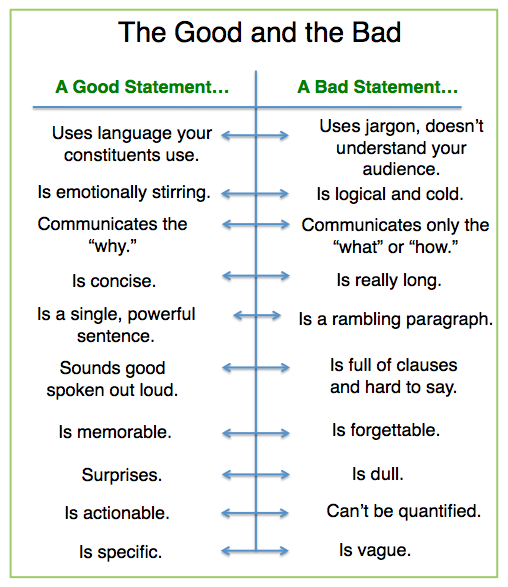
VISION
Vision Understanding: Vision generates energy and motivation for your team. A well-crafted vision statement produces significant ROI. What is a vision statement? Your vision statement is what you hope to be and where you are headed by doing your mission. To begin: Describe where you are going and what your desired state is. In three years, our company will accomplish ___ and grow in ___.
Why is creating energy and motivation so important? In today’s work environment, employers are struggling to attract and retain the next generation of talent. The reality is that 60% of the workforce has a newer mindset, desiring to contribute to vision because it provides meaning and belonging—not just sitting idly to “do the work.” They want to contribute to the overall vision of the organization. When an organizational vision doesn’t support meaning for an individual, it may not be a good or long-term fit. Vision is a vital ingredient for organizational success. Aligning leaders with the vision is crucial to that success. It also creates a magnet to attract and retain important talent.
In this workshop, we will discuss how to leverage your team to create a motivating vision. When your team is motivated by a shared vision, this will increase alignment and produce optimized results. It will be important to name and celebrate “vision moments” often. These vision moments will reenergize your team. A vision moment is simple, and action, attitude, behavior, or result that is in line with your vision. It is an example of the desired future state. Naming it, celebrating it, and saying, “Yes! That’s a perfect example of our vision and where we’re headed as a team or organization.” This habit will add fuel and motivational energy to your team.
Vision Analysis
For optimizing leaders, one of the highest priorities to achieve optimization is creating alignment around your vision. The first step is crafting a compelling vision of the future. A vision statement is a simple and powerful statement that energizes people around us and provides clarity about the direction we’re headed.
How compelling is your vision statement? Then, evaluate it using the provided reflection questions. Make necessary edits to create a final version. Write your compelling vision of the future. It is a description of your desired state for your team or company.
Consider these questions:
Brevity: Is it short and clear? Have no more than three sentences and avoid complex language or internal jargon.
Purpose: Does it explain the “why” behind the required effort? People want to understand the why. This is often what motivates them to champion and implement the change to the desired state.
Inspiration: Does it energize and excite people? Is it memorable? People want to be highly motivated by their work.
Meaning: Does it name positive benefits beyond the organization? People want to do meaningful work.
Direction: Does it clarify where you’re headed? Does it help people make decisions and commitments in light of the bigger picture?
Vision Efficiency
Now you can take these steps to bring your vision to life. Communicate: Get your vision statement in front of everyone who can benefit from knowing it. How many people is this? What is your communication plan for the next 5, 15, and 30 days? Connect: Tie as many actions, decisions, and development plans to it as you can. Keep asking, “How does this tie to our vision?” “Is this a vision obstacle or vision enhancement?” Celebrate: Highlight efforts and outcomes that move you closer to your vision with praise and affirmation. Who are your vision champions? Ask them to be and thank them when they do. Course Correct: Kindly provide constructive feedback regarding misaligned efforts or missed opportunities. Be open and vulnerable about this every day, every meeting for 30 days, and document what you learn. Commit and commit again. Constantly reinforce and restate the full team’s investment in making the vision a reality.
VALUES
Values Understanding
Your core values unite your team to ignite your mission and vision. Because your business achieves your goals through the lens of your core values, as you fulfill your mission, this will ignite and fuel your vision.
Core values are a strong foundation, ensuring consistency in actions and decisions. Values play a crucial role in aligning teams during growth, challenge, change, or uncertainty. This stability leads to increased trust and confidence among employees, stakeholders, and customers. Also, this results in greater emotional safety and trust. The human brain feels a sense of safety to function better in a more predictive environment. When there is chaos, uncertainty, and volatile change, values can create a calming and centering effect. This also increases clarity for decision-making. Customer relations improve. When a leader is dealing with customers and there’s a value misalignment, this can cause many problems. However, managing value alignment with clients results in more cohesion, longer relationships, and an increase in the quality of customer relationships.
If there’s conflict in the team, it often comes down to values misalignment. What one holds dear as really important to them can be different than what others hold dear. There are several layers worth considering: organizational/company values, team/department values, individual values, and varying opinions. If teams aren’t aligned about values as a team, it will often get in the way and create unnecessary tension. Certainly, there won’t be 100% alignment, but “anchor” values are necessary to create alignment. These are 2-4 values that are strongly agreed upon. During change or conflict, these anchor values can serve as a reminder of what everyone collectively feels is important. Values alignment creates more shared meaning. “When we feel stuck, reflecting on our values can provide a helpful pause, allowing us to find solutions through the lens of our values.” This creates alignment to govern how we behave so anyone can be called into the values. This management of the alignment process also creates emotional safety and trust.
Values Analysis
When analyzing your team’s values for alignment, here are some questions to consider. Can your team name your company values? What are your company values? How clearly do you understand the organization’s vision and values? To what extent do you believe the organization’s values are reflected in its daily operations? What makes you proud to work at this company? What role do company values play in hiring and performance reviews? How would you describe “organizational politics” at the company? What are some of the ways the company celebrates success? How do you, as a manager—or, if more appropriate, how does your manager support and motivate your team? How effective are leaders in communicating the organization’s goals and objectives? Having a conversation with your team using these questions will provide you with excellent alignment insights.
When this is high-value alignment, there will be higher motivation to be all in, go above and beyond, etc. Consider where there is alignment on personal values as a team. Explore where there is alignment of personal values with your company values. When you create clarity on value alignment, leadership alignment increases, and you are now in an optimized leadership space! Consider using the list below to force rank your top 10 values. Repeat for the team, and repeat for the organization.

Values Efficiency
If you don’t have an established list of defined values, this is a great opportunity to consider creating one. When values are clear, brief, and listed, it creates ease of alignment clarity for you and your team. To get started, reflect on your personal and organizational values. Identify and examine your personal values and how they influence your leadership style. Reflect on how these values impact your organization. You can then align the values across the organization. Organize a meeting with your team to ensure alignment of values across all levels, from executives to front-line staff, to foster a strong sense of belonging and shared purpose. You will have the opportunity to do this work and have these conversations as part of your project study.
If your organization has established values but they don’t seem to work. Start by evaluating understanding and implementation of values. Consider the following questions to assess your current situation. What are your company’s values? How well do you understand the organization’s vision and values? To what extent are the organization’s values reflected in its daily operations? What aspects of your company make you proud to work there? What role do company values play in hiring and performance reviews? How would you describe the nature of “organizational politics” at the company? How does your company celebrate success? How do you, or your manager, support and motivate your team? How effective are leaders in communicating the organization’s goals and objectives?
Redefine and reinforce your values. Based on the insights from the questions, redefine values if necessary. Develop a plan to reinforce these values within the organization. Keep in mind that not all values need to align. You will need to establish anchor values and manage value variances with skill, respect, grace, and ease.
Bringing it all together. Now that you have worked through your mission, vision, and value statements and considered the alignment level you have among your team or organization, you are ready to “take this show on the road” throughout your organization. The project study for this course manual will allow you to gain further input and insight about the MVV and leadership alignment level each department has with your mission, vision, and values.
In closing, consider the sample mission statement, vision statement, and values listed below (along with the sample visual). What inspires you?
● Example mission statement: We empower individuals to save money while saving the planet by intersecting creative, sustainable packaging with wearable technology that educates, inspires, and drives Earth-friendly action.
● Example vision statement: To change the way we think about saving the planet.
● Example values: Tomorrow-minded, knowledge is power, assuming best intentions, sustainability.
Example Visual
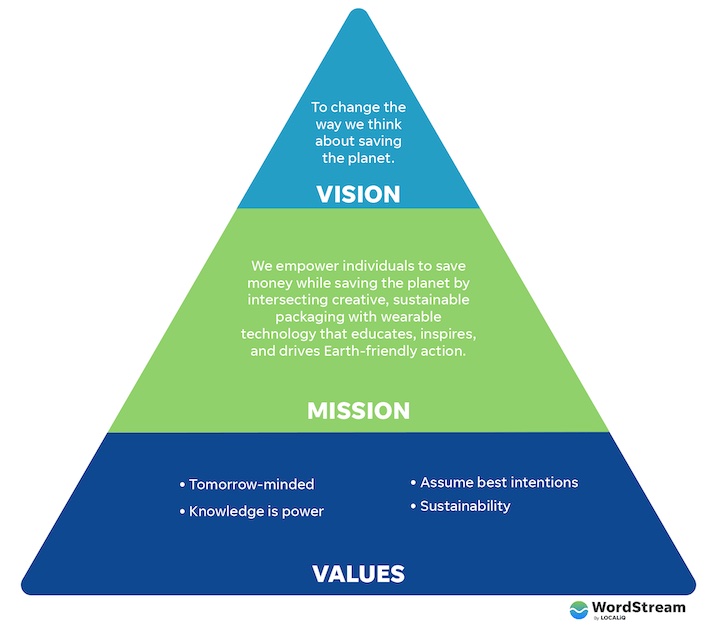

Case Study: Promotion: Perfect Opportunity to Revisit Mission, Vision and Values
A senior vice president was promoted to CEO when his boss retired. He assumed the position of leading a national 2000-strong operation, and he decided to update their mission statement. His goal was to set the tone for his leadership and organizational culture. He set out by establishing an ad hoc team of five individuals at the director level from different parts of the organization. He personally provided the team his vision for the organization and how he intended to lead. He also described the culture he was after. He also told them the statements needed to be brief and to represent the entire organization.
After a few cycles of back-and-forth drafts, he took what the team produced and reflected on it for a bit. To test the new version, he brought together a team of a dozen directors for critical thinking and feedback. He took the feedback, made some minor changes, and published it.
The result was a revised mission statement that also defined terms and concepts. He has since rolled it out across the entire enterprise. As he often speaks and travels for many meetings, he uses the revised mission statement to start every meeting or speaking engagement. It has become integral in the company’s onboarding process for new employees and is used to help guide decision-making processes.

Exercise: personal reflection—Choose one aspect of your MVV, either your mission, vision, or value statement, to measure your efficiency.
1. Do you have a [mission, vision, or values] MVV statement? Rating score: _____
● 10: Yes
● 0: No
2. How well does your MVV statement reflect your company’s vision and values? Rating score: _____
● 0: It’s misaligned
● 5: Mostly aligned, with minor gaps
● 10: It’s fully aligned
3. How involved was your team in creating or refining the MVV statement? Rating score: _____
● 0: The mission statement was a top-down creation
● 5: Some input from the team was sought
● 10: It was a collaborative process with significant input
4. How confident are you that most employees can accurately state your MVV? Rating score: _____
● 0: Few employees could state it
● 5: More than half of our employees are familiar with it
● 10: Most employees can state it accurately
5. How confident are you that your MVV statement provides clear guidance for individual roles and responsibilities? Rating score: _____
● 0: My team’s roles and responsibilities seem disconnected from the mission
● 5: My team’s roles and responsibilities are somewhat aligned with the mission
● 10: I am confident that my team’s roles and responsibilities are clearly defined and closely aligned with the mission
6. Does your team show a personal connection to the MVV? Rating score: _____
● 0: Most team feel distant from the mission
● 5: There’s a general sense of connection
● 10: My team resonate deeply with our mission
7. How often do you review your MVV statement with your team during meetings? Rating score: _____
● 0: Almost never
● 5: Sometimes
● 10: Almost all the meetings
8. How often do you use your MVV statement in company decisions? Rating score: _____
● 0: We barely include it for our decisions
● 5: It’s considered for major decisions
● 10: It’s a core part of our decision-making process
9. How clearly does your MVV statement guide your leadership team in setting priorities and periodic goals? Rating score: _____
● 0: We don’t use our mission statement to guide priority setting or goal development)
● 5: It provides some guidance for setting priorities and goals)
● 10: It is a central factor in setting and aligning priorities and goals)
10. How often do you revisit the MVV statement due to company changes or challenges? Rating score: _____
● 0: We barely revisit the mission
● 5: We reviewed our mission statement during major shifts
● 10: We reviewed it whenever there were changes
75-90 – Making excellent alignment progress
50-75 – Need more alignment work
30-50 – We have not prioritized MVV or Leadership Alignment
15-30- High risk of misalignment
0-15 – We are not aligned

Course Manual 2: Common Understanding
Define common understanding
When there is a shared comprehension of information, goals, objectives, or processes among a group, team, or organization, that is common understanding. Another aspect of common understanding refers to aligning on vision and direction, expectations, and concepts.
In business, common understanding is important in a smoothly integrated, aligned manner. Common understanding also opens up space for discovery and discernment.
When there is a lack or limitation of common understanding, this can cause confusion, frustration, misunderstandings, and communication breakdowns. This often happens when there are differing interpretations of words, phrases, or even gestures. Common understanding refers to any general knowledge or belief that is widely accepted by a group of people. This can include the shared perception of or interpretation of a concept, term, or event.

Photo by Zuzana Ruttkay on Unsplash
Achieving common understanding
In order to achieve common understanding, there are several items to consider at the beginning. Desire is an important component. Naming common understanding as a goal you would like to achieve with your team. You can simply ask yourself, Is this what I want? Commitment is another important aspect of achieving common understanding. Without commitment, how will you and your team achieve results? As you learn to strengthen these skills, commitment will be highly valuable. This commitment to and desire for common understanding will help you to develop a consistent, common understanding mindset. This mindset will often present itself when actively listening and asking good, positive questions. You will be seeking to understand rather than be understood. Your listening will have a tone of understanding rather than responding to win, be right, or correct others. Time, patience, and repeating also play an important role. It will take some time to achieve common understanding. Being patient and displaying patience will only help you and your team achieve success. At times, you may need to repeat or go back to something you thought you had achieved a common understanding on, only to find it may be necessary to deepen understanding or commitment for that matter. A relentless pursuit of assumption elimination is a key component necessary to achieve common understanding. This will mean you will need to regularly reflect on and ask yourself and your team to identify assumptions that may be present that are hindering the objective of common understanding. In order to achieve common understanding, it will also be important for you to have a process.
Importance of common understanding
The graph below illustrates the increase in team performance that can happen over time when common understanding is achieved. Without this common understanding, there is a high risk of misunderstanding, which can lead to low performance and underperformance. When high performance and high skill are achieved, a deeper sense of community is reached. This experience of community is one of the top reasons employees decide to stay with a company or team.
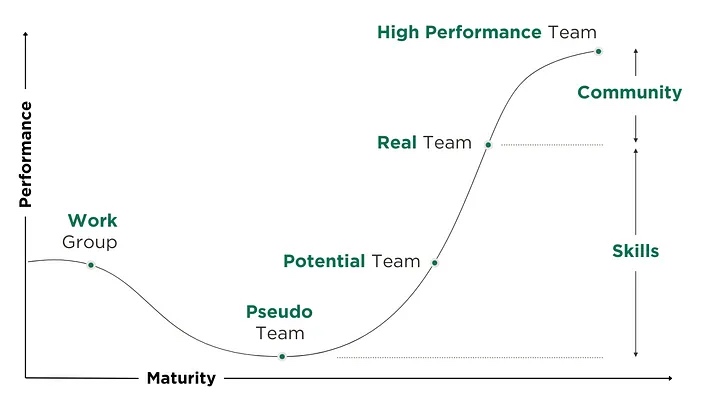
So how does one go about creating a common understanding, and why does it matter? First starters, many leaders may make the mistake of assuming their team is “all on the same page.” And what does that phrase even mean? It may mean different things to different people. How do you know everyone is on the same page? Why is that necessary at this moment for this work or project? Often teams can jump into doing the work without a clear or common understanding of why they are doing it or what purpose it serves. In this section, we will uncover common understanding gaps and establish a clear process of how to close those gaps in order to gain a common understanding.
Understanding gaps
What are understanding gaps, and how can one close them? It will be important to identify any understanding gaps on your team. Certainly, words can have very different meanings to different people based on many factors. When there are understanding gaps, this can cause assumptions, which can result in very low understanding and even misunderstanding. In fact, if understanding gaps are not identified and closed, the results can be less than desirable. For instance, if a boss says, “Ok, it will take care of itself,” when referring to a struggling employee. The other manager could infer that action needs to be taken and fire the employee (even though this is not what the boss meant in any way). This is a real-life scenario that illustrates the importance of closing understanding gaps.
There are several ways this can be accomplished with ease. One practice can be to say, “To clarify…” and then share what you think the other person is saying or meaning. Another habit can be to ask the question, “What are our understanding gaps, and what can we do to close those gaps and increase clarity?” When speaking, one can also share their commitment to achieving common understanding and ask for help or input from the other(s) to achieve that common understanding.
Understanding process

Photo by Akson on Unsplash
Understanding
Analysis
Efficiencies
Understanding is the first step in the process. Name what you are trying to create a common understanding for. Why is this common understanding important to you, your team, or the outcomes you are trying to achieve? Ask others to commit to a common understanding process and outcome.
Analysis will be necessary to decide if you are on track to achieving common understanding. As part of this analysis, it will be necessary to test assumptions. Ask, What assumptions are we making that are barriers to achieving common understanding? What does ____ (a specific word or phrase) mean to you? Are there other meanings or understandings about this specific word or phrase that are held by the group? What are other potential meanings for this word or phrase that could be held by others not in the group? By customers? By shareholders? By competitors? By others in our organization?
Efficiencies are increases in clarity, improvements in the process, or ease of common understanding accomplished. At first, it will take more time and more commitment to produce the common understanding results you are seeking. Over time, with improvements and adjustments due to analysis, greater understanding outcomes will be achieved by you and your team.
Understanding mindset
As you continue to develop and increase your understanding process, practices, and habits, you will significantly increase your understanding mindset. An understanding mindset is simply one that is focused on the whole and the other rather than only the self. An understanding mindset seeks to understand others rather than to be understood (although that is necessary as well). An understanding mindset will find joy and satisfaction with the common understanding process and outcomes. When an optimizing leader adopts an understanding mindset, they will hold a learning stance of curiosity and will experience vigilance for closing understanding gaps and increasing understanding results and outcomes. This optimizing leader mindset becomes “contagious” to other optimizing leaders on your team and in your organization. It will also be very attractive to customers and new talent you may be seeking to hire.
Active Listening

Photo by Anastasiya Badun on Unsplash
Once a common understanding is established, it creates a simple and smooth process to repeat this practice in other areas of the business or objectives for the team. Active Listening is an important skill to practice at this stage of the Leadership Alignment process. The chart below illustrates the Active Listening process.
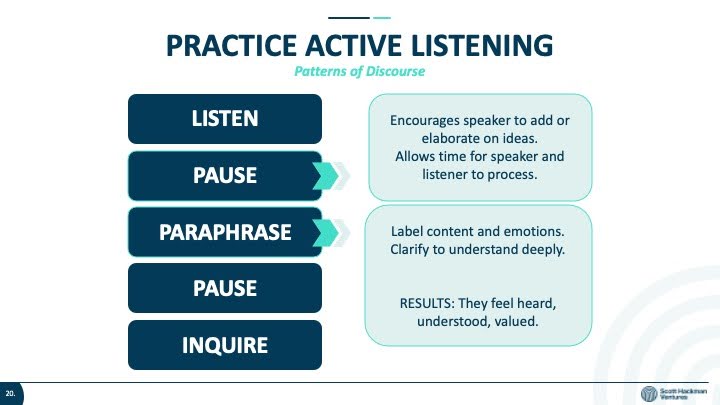
Barriers to Active Listening
When seeking to increase the skill of active listening, optimizing leaders who are seeking common understanding and leadership alignment on their teams will need to identify some of the common barriers to active listening that they experience. This practice will not only increase their active listening skills and improve common understanding; it will also result in greater awareness when others may be displaying behaviors that are reflective of their barriers to active listening.
This list represents many of the common barriers to active listening but is not an exhaustive list. There certainly may be other barriers you experience. Let’s consider each barrier for awareness and consider a potential action to overcome said barrier.
Comparing. This is trying to assess who is smarter in the conversation. Also, one might be thinking, Who is more competent or emotionally healthy, me or you? One way to overcome this barrier is to ask yourself, Why does comparing matter to you? Are you overcoming a weakness or potential insecurity? When one takes on a servant leadership role, one will hold the other in high regard and not allow the comparing barrier to impede active listening.
Mind reading. This is the habit of guessing what the other person is really thinking and feeling. There may be an assumption here that you don’t trust them or think they are telling you the truth. Perhaps there is a hidden meaning or alternative agenda. One way to break through this barrier is to simply remind yourself that you are not a mind reader and that to understand, you will need to stop guessing or anticipating meaning and simply ask clarifying questions.
Rehearsing. (One of my personal favorites.) This is preparing what you are going to say next or how you are going to respond. You may be carefully crafting your next comment. Rehearsing can be commonly misunderstood as a good habit in active listening. Aren’t I simply responding ahead of time in my mind to what the other person is saying? Yes, in fact you are; however, when doing so, you are not listening but preparing your oratory. This means you will miss some or all of what they are saying and meaning. Rehearsing puts you at the center of your attention rather than the other person. Next time you find yourself rehearsing, pause and ask, What are they saying right now? Then keep actively listening.
Filtering. Paying attention only long enough to see if you want to or need to listen or feel like you’re emotionally in danger. If you don’t recognize the want, need, or danger, you simply check out and no longer listen or engage in the conversation. This barrier can create an experience for the other person. They may feel that they are not important enough to you for you to give them your undivided attention. Is that the experience you wish to create for the other? When you notice yourself filtering, name it in your mind. Say, I am filtering right now. What is causing this? Do I want to give this person my attention? If so, I do. If not, I will ask them to pause, and let’s create a time for us to continue this important conversation.
Judging. When you write off or dismiss others as unintelligent or unqualified and not being worthy of you listening to them. This sounds harsh, right? Yes, because it is. When you may find yourself judging instead of actively listening, consider the source of your judgment. Is it about you or about them? What is a positive aspect of the other person that you can appreciate? What common understanding can you seek?
Dreaming. What the other person says triggers a thought, memory, or idea for you, and then you drift off into a daydream. All of a sudden you realize the other person is still talking, and you have no idea what they are saying. When this happens, simply return to active listening. You may ask the other person to pause and summarize what they just shared. This will help increase your understanding, and this is important to you.
Identifying. The habit of referring everything the other person is saying back to your own personal experience. This completely focuses on you and not the person speaking. When you are seeking to make a relational connection with someone, an assumption can be made that common experiences are what ties you together. This is not necessarily the case. Increased understanding will have a greater connection impact. Let understanding rather than identifying be your motivation.
Advising. Having to constantly search for the correct answer or to display a form of wisdom or help for the other person. You are trying to fix the other person’s problem, even when they are not asking for it. Scientific research has found that unsolicited advice creates a “shut off” valve in the other’s brain. Typically, no one wants unsolicited advice.
Sparring. Arguing or disagreeing with the other person before hearing them out. This often comes from a strong need to win or dominate. This need often is about you rather than understanding the other person. If you want to spar, simply ask if the other person is interested. That way there is agreement and common understanding with agreeable sparring terms can be accomplished.
Be Right. Needing to be ‘right’ at any cost. Going to any length to be ‘right’. A way to create common understanding here is to consider if there are multiple ways to be right. If so, perhaps the other person is shedding light on another right option, and this will provide value for you both.
Derailing. Suddenly changing the subject because what the other person is sharing is uninteresting or unimportant to you. You may find what they are talking about boring or uncomfortable. To overcome this barrier, one can find a way to an aspect of the conversation they may find more interesting or comfortable. Saying something like, I hear you and want to continue our conversation. Could we talk about…?
Placating. Agreeing with what the other person is saying in order to get them to like you or to win their approval. This can happen when you find yourself saying “yes” or “okay” a lot as you listen. Consider if your motivation is to win their approval. Try other listening indicators besides head nods, yes and ok. Perhaps asking a clarifying question here will be useful.

When others experience the impact of being actively listened to, they feel heard, understood, and valued. This will establish a baseline for common understanding. Another result of the active listening process is appreciation. It can be easy during a conversation of idea sharing for people to compete for air time or compete for their idea or perspective to win out. This often does not result in common understanding. In order to achieve common understanding, there will need to be a commitment on the part of the leader to establish this understanding as much as possible and within reasonable time constraints. If this common understanding phase in the process is overlooked, skipped, or stymied, it can create adverse effects later in the process.
Feedback checks and balances

Photo by krakenimages on Unsplash
Increasing alignment

Photo by Walls.io on Unsplash
Optimizing outcomes
With a solid foundation of common understanding, there is an exponential increase in optimizing outcomes. No longer will you or your team need to be frustrated or limited in confusion or overwhelm. Now you will have developed an essential team skill of optimizing leaders: common understanding. This will result in many improvements, efficiencies, and even a sense of ease for the outcomes, goals, and results your team is seeking to accomplish.

Case Study
A global entertainment company uses a focused mission statement and an expansive vision statement to influence strategic decisions.

The business purpose and mission of global entertainment industry leader Netflix are reflected in its mission and vision statements. Netflix seeks to sustain a market presence as a leading firm in the streaming entertainment era. This clear priority allows the company’s decision-makers to have optimized leadership alignment when it comes to strategic planning for business growth, development, and competitiveness.
The mission statement of Netflix is “to entertain the world.” With this clear focus, the company exists for entertainment and global market presence. A clear and concise mission statement greatly aids in optimizing the leadership alignment process. The vision statement of Netflix is “to continue being one of the leading firms of the streaming entertainment era.”
The mission and vision statements of Netflix certainly influence decisions for Netflix’s competitive and growth strategies. The purpose is to maximize market reach and presence and continue providing entertainment. There is an aspect of market leadership in Netflix’s vision statement and a recognition that streaming entertainment is in fact an era.
One aspect of how Netflix uses there mission and vision statement to increase leadership alignment is through their human resource strategy and management goals. These objectives involve increasing knowledge, skills, and abilities for producing entertainment content that is of highly valued by it’s customers.

Exercise
1. The greatest strength I bring to our organization or team is…
2. One thing I would like to improve about our organization or team is…

Course Manual 3: Phrase Alignment
Keyword phrases are essential to clear communication. An essential leadership skill is knowing how to create powerful and memorable words and phrases that inspire and elicit action. Words matter. How leaders use words to inspire, elicit action or change, find common understanding, and create meaning can have a significant impact on productivity, understanding, engagement, trust, and collaboration.
The chart below illustrates the significant impact that clear and compelling communication can have.
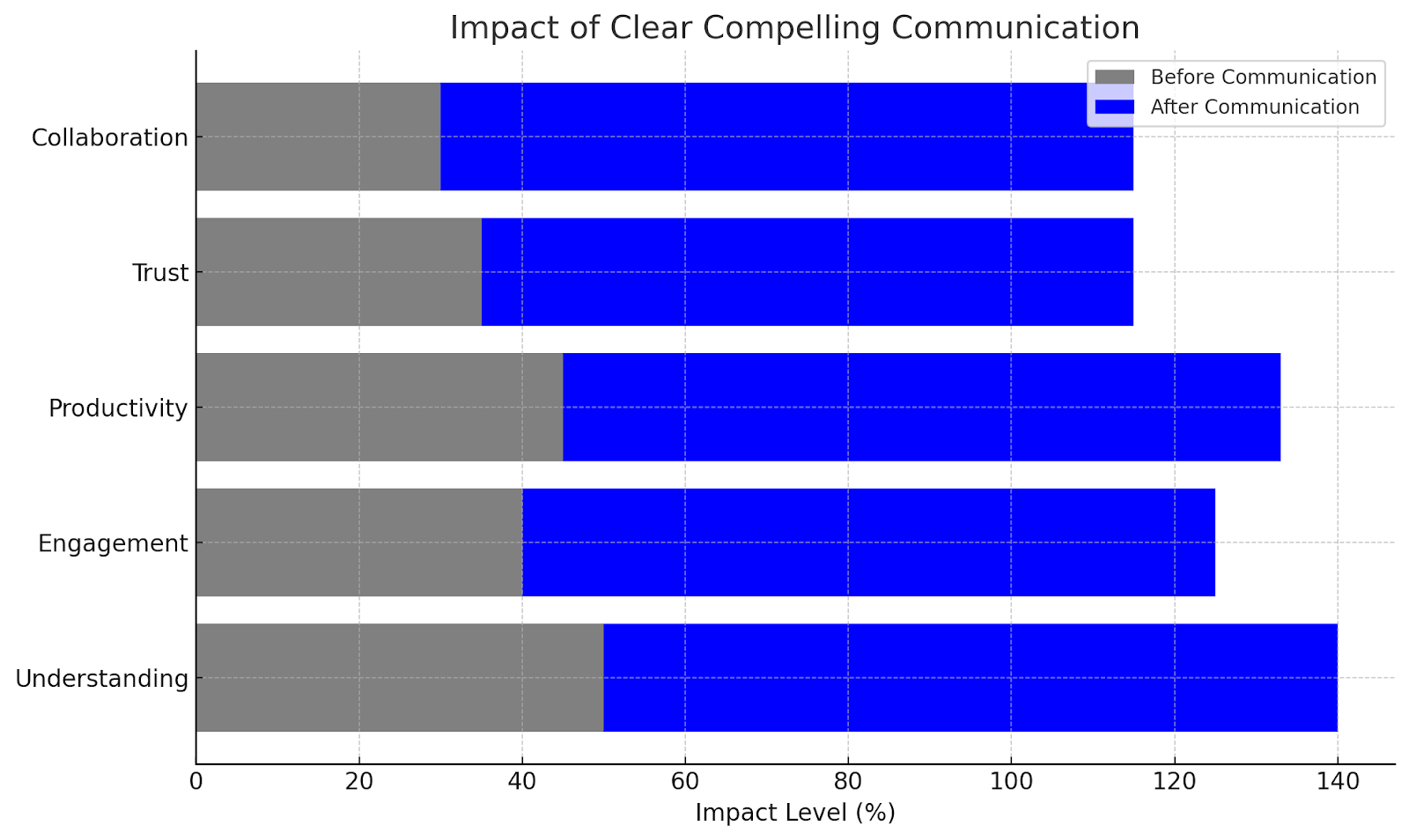
If you were to measure what you say and how you communicate (verbally, nonverbally, written, etc.), what would be the impact metric of your communication? If you were to ask a colleague to also measure your communication impact, what would your score graph look like?
This visualization gives a clear sample of the effectiveness of communication across these key metrics.

Considering your communication impact is an essential leadership alignment skill for optimizing leaders. During this course manual, we will consider several factors to help you create effective phrase alignment and increase your skills on stacking phrases together that will increase understanding, clarity, motivation, and action for others. When this skill is practiced on a regular basis, communication effectiveness and leadership alignment will continue to grow.
What Leaders Say Matters
Far too often, leaders can be careless with their words, their facial expressions, and how they communicate verbally, nonverbally, in writing, and in other ways. This carelessness can be common, especially during times of stress, fatigue, or overwhelm. Most leaders certainly experience stress and many challenges, so careless and poor communication habits can easily creep into daily habits. A way to change any careless communication habit is to consider your communication impact. Measure it. Ask for feedback and input. Receive coaching and accountability. Make small changes by setting a daily intention. If there is an area you may be struggling with, say perhaps inspiration. Spend time being inspired. Consider what or who inspires you. Observe other leaders who have high-inspiration communication skills. What can you learn from them? Consider asking them how they learned to use inspiring words in their communication.
Why does what leaders say matter? When leaders speak and communicate, they are creating culture. Whether a leader realizes it or not, there words and the feeling or emotional experience that is created for others have a direct impact on culture in a team or organization. Consider a time when a leader’s words inspired you. What impact did that have on you? Were there certain emotions and actions it created for you? When you felt something, you were inspired, and then you acted. What impact did your action or emotional energy have on others? Were others inspired as well? This words-culture-impact can be contagious in a positive or negative way. Perhaps there was a time as a leader your words or communication didn’t land well with others. You may have noticed certain emotion-based behaviors that created a negative impact on the team and perhaps even effected outcomes in a less-than-desirable way. Having a high understanding and appreciation of what leaders say matters will create increased awareness for the optimizing leader, higher potential for leadership alignment, and the opportunity to be very intentional and strategic with the use of phrases that create inspiration, clarity, and understanding along with actions that produce desired outcomes.
What Leaders Don’t Say Matters
As an optimizing leader, it will be necessary to weigh your words on a daily basis. Not all words are necessary, and not all words carry the same weight or value. As you speak, communicate, and seek to increase leadership alignment, take time to do a word inventory. How many words did you use today? What was the value and weight of those words? A simple way to find out how many words you spoke in a day is to try this. Record yourself speaking for a set period of time, then use a transcription tool to count the words in your recording. Simply divide the total word count by the minutes you spoke to get an approximate words-per-minute rate. Then you can multiply by the total time you spent talking throughout the day. This simple practice will help you be more mindful of the volume of words you use and create greater awareness for word efficiency. Another perspective here is to consider the type of words you say and the alignment quality of those words.
On average, people speak around 16,000 words per day. A large portion of those words will be spoken in the workplace. The optimizing leader acknowledges that words are a powerful tool and can be used to inspire, encourage, or damage. Here are a few things to consider when wanting to use words more effectively. Focus on quality: The best communicators use fewer words that carry more weight and have greater value. Consider the impact of your words and how your words are received. Take a moment to pause and reflect on how your words were received. Make adjustments for the next conversation. Challenge others to be mindful of their words (both quantity and quality). Challenge others to not use self-limiting words and to call you out when you do. Reflect on the things you left unsaid and consider if there may have been a missed opportunity to encourage, course-correct, clarify, or inspire.
How Leaders Say It Matters

Photo by ahmad gunnaivi on Unsplash
Nonverbal communication will have a significant impact on how others perceive you and how they receive the message you’re trying to communicate. How you say something can help build trust, put people at ease, and draw others to you. However, it can also offend, confuse, or undermine your message. A way to gauge your communication impact can be to ask for feedback. Was how I communicated helpful to create clarity, action, inspiration, etc.? Was there something specific I could have changed about how I communicated that would have been more helpful for you and to create common understanding and alignment? These are some examples of clarifying feedback questions that you may find helpful to use.
Why Leaders Say It Matters
What was your intention when you said, _____? The why behind the words is often just as if not more important than the words themselves. Are you trying to motivate? Is clarity the outcome you are seeking? Producing increased alignment by having a clear intention or why behind your words will be a necessary discipline for optimizing leaders. Taking a moment to pause and consider your why for the words you are choosing to use and about to communicate will help you gain increased clarity for your intention and for the outcomes and culture you are seeking to produce with your words. I’m sure we have all had the experience of not being sure why we said something. Perhaps it was a reaction. Perhaps we didn’t think before we spoke. It happens. We may also have had the thought, “I’m not sure why they said that or why they would say that.” This “missing why” can result in confusion, frustration, a lack of clarity, and a demotivating outcome. Are you aware that communication lacking a clear why has a high risk to create this impact? Is this the impact you are seeking to create? Optimizing leaders grow in skill and understanding of why they communicate, what they communicate, and how they communicate.
Powerful Phrases
What are powerful phrases, and why do they matter?
Simply put, a powerful phrase is a short, impactful combination of words that creates a significant emotional, motivational, or persuasive impact. There is a weightiness to them. When people say, The way you said that, or can you say that again, or wait, I need to write that down,” you will know you are optimizing your powerful phrases. This matters because, when used well, a powerful phrase can create the impact of inspiring, encouraging, or persuading people. These are all necessary outcomes for optimizing leaders. A powerful phrase captures attention and illicits emotion in a way that resonates deeply and sticks with the recipient. Think of phrases like “I have a dream,” “Carpe diem,” or “Be the change you wish to see in the world.” Each powerful phrase is concise, memorable, and motivating for people to move toward action or reflection.
Powerful phrases matter for several reasons: emotional impact, clarity, action, and value alignment. For emotional impact, it will be necessary to create a strong phrase that often connects with and puts words to universal emotions and values This will result in creating a feeling of connection. For example, “You are not alone” speaks to a common human experience. It invokes feelings of comfort or hope. For clarity, use short phrases that are easy to remember and can be repeated often without redundancy. This makes them ideal for spreading ideas or values. Consider advertising slogans or historical speeches — these are often distilled to clear and memorable phrases. When wanting to illicit action use phrases with strong verbs or challenges that can inspire change, action, or self-reflection. Starting with a strong action verb is helpful. For values alignment, keep it personal and reflective of cultural settings. These powerful phrases help reinforce core beliefs and ideas. As an example, “Injustice anywhere is a threat to justice everywhere” is memorable, values aligned and challenges people to consider the broader impact of their actions. A powerful phrase is a combination of impactful words. It’s a tool that can influence thought, culture, and action. Its effectiveness comes from its simplicity, clarity, and emotional impact.
Inspire

Photo by Eduardo Dutra on Unsplash
Inspirational phrases and words can lift us up. They often motivate us or help us see challenges more clearly, even as opportunities. They tap into human emotions, values, and goals, and they connect with universal themes of resilience, growth, and purpose. What are powerful words that are inspiring to you? Here are some samples to consider.
Passion is full of energy and enthusiasm. It reminds us of what truly matters and brings joy and commitment. It helped us through challenges.
Purpose motivates because what we do has significance. It provides clarity and drive to reach our goals.
Courage is the ability to move forward despite challenges or even fear. It means we act even when we feel fear. It’s a call to face our fears and grow.
Hope reminds us that things can get better. It gives us a reason to persevere even when things are hard. It acknowledges that there’s potential for change.
Resilience is the power to recover from setbacks. It’s been said that it doesn’t matter how many times you’ve failed or been knocked down. What matters is that you get back up.
Belief encourages faith in oneself, one’s goals, or the support of others. It is confidence in what we’re doing and commitment to making it a reality.
Perseverance is persistence in pursuing goals despite challenges or obstacles. It’s about grit and determination; character and not giving up.
Gratitude changes the point of attention from what’s lacking to what’s present. Recognizing the good and current increases a positivity mindset to motivate.
Empowerment emphasizes gaining strength, control, and confidence. it conveys growth, choice, and self-determination.
Transformation focuses change into opportunity for growth, progress, and improvement. It reminds me there are options for a fresh start.
Each of these sample inspiring words resonates with our need to find meaning, overcome obstacles, and connect with others. They remind us of what’s possible and speak to our strength, potential, and purpose. How often do you use each of these words on a daily basis? What is their impact on you when you say them? What is the impact on others when they receive them? What can you do to incorporate more inspiring words in your day-to-day and measure their impact?
Easily Understood
When crafting your mission, vision, and value statements, you should seek to ensure that the words and phrases used are easily understood. This will help increase understanding and efficiency. If people are able to understand easily, this will create inspiration, which will result in actions or behaviors that align with your mission, vision, and value statements. If there is confusion, lack of clarity, or it feels cumbersome or complicated, this can have a demotivating impact and result in little to no action, or even worse yet, the opposite action you are seeking. How will you know if your chosen words are easily understood? Ask. Ask your team members; ask your friends or family. Ask if there may be a more clear and easily understood way to say what you mean. Often, when people are in the midst of creating mission, vision, and value statements, they may be too close to the ideas and lose sight of a simpler, more clear way to say something.
Action Oriented
Consider how many action-oriented words you use in your mission, vision, and value statements. Are there verbs? Which words are action-oriented verbs? Are they past tense, present tense, or future tense? Are there words that end in “ing” to communicate process-oriented action? When mission, vision, and value statements have multiple action-oriented words, they have life and movement. When there is life and movement, people are motivated toward action. It also creates a sense of energy, enthusiasm, and inclusion. In other words, it won’t feel like it’s already been accomplished, completed, or decided. It will create curiosity, wonder, and a desire to get involved in the energy and action.
What are action words that make you feel inspired and provide clear direction for you? How often do you use action-oriented words when communicating with your team? How has this increased leadership alignment for you?
Action words are verbs that convey energy, urgency, and direction. They are powerful motivators because they inspire others to take action and create a sense of momentum. There are several ways they can be effective when creating leadership alignment and especially with your MVV. Action words can be used to create a clear vision. They can create a vivid picture of the steps someone can take. For example, saying, “Let’s build something amazing,” creates a sense of active involvement and progress. Amazing illicits creativity, innovation, and imagination. Action words create a sense of ownership. When you use words like “drive,” “lead,” and “initiate,” this encourages people to take responsibility for their roles, which results in them feeling more empowered and in control. They naturally become more invested in the outcomes.
Action words also create more confidence. These are words that convey strength and positivity. “Achieve,” “overcome,” and “succeed” are some great examples. Leaders are more motivated when they believe their efforts will produce desired outcomes and yield positive results. Action words also increase focus. This focus can direct attention to specific tasks or objectives, reducing distraction. Words such as “prioritize,” “target,” and “laser” tell people exactly where to place their energy, creating higher clarity for the priorities of accomplishing specific goals. Action words can also evoke positive emotions. Words like “celebrate,” “appreciate,” and “enjoy.” will have this impact. Using action words intentionally and strategically in communication helps leaders clarify direction, impact others, and initiate steps needed to achieve goals.
Meaningful
What does it mean to use meaningful words when communicating and creating greater leadership alignment around your mission, vision, and values? Using meaningful words in sentences can add clarity, depth, and impact to your writing or speech. Consider words or phrases that will be most meaningful to your recipients. This is often described as “know your audience.”
It will be important for you to tailor your words and language to the audience. Take time to choose words carefully and intentionally. These will need to match the tone and formality level appropriate for your audience. This will result in your communication being much more relatable and effective. For example, in a formal report, you would use more professional language like “The data indicates…” rather than “The numbers show…”
A few other concepts will be helpful when seeking to craft your message and communication to make it most meaningful for others. Consider how meaningful it is for you. Use precise vocabulary. Use specific words rather than vague words. For instance, instead of saying “bad,” you could say disastrous or disappointing. It can also be helpful to utilize emotional literacy as well. The Feelings Wheel is a great resource to increase your use of meaningful words (see below). Be sure to use an active voice rather than a passive voice, and focus on using strong verbs. Try to avoid using figurative language, as this may have many different meanings to your recipients and could create confusion. It can be a positive and powerful practice to review, revise, and edit your message for clarity and impact. By choosing precise, active, and powerful words, you can make each sentence more meaningful and engaging for your listener.
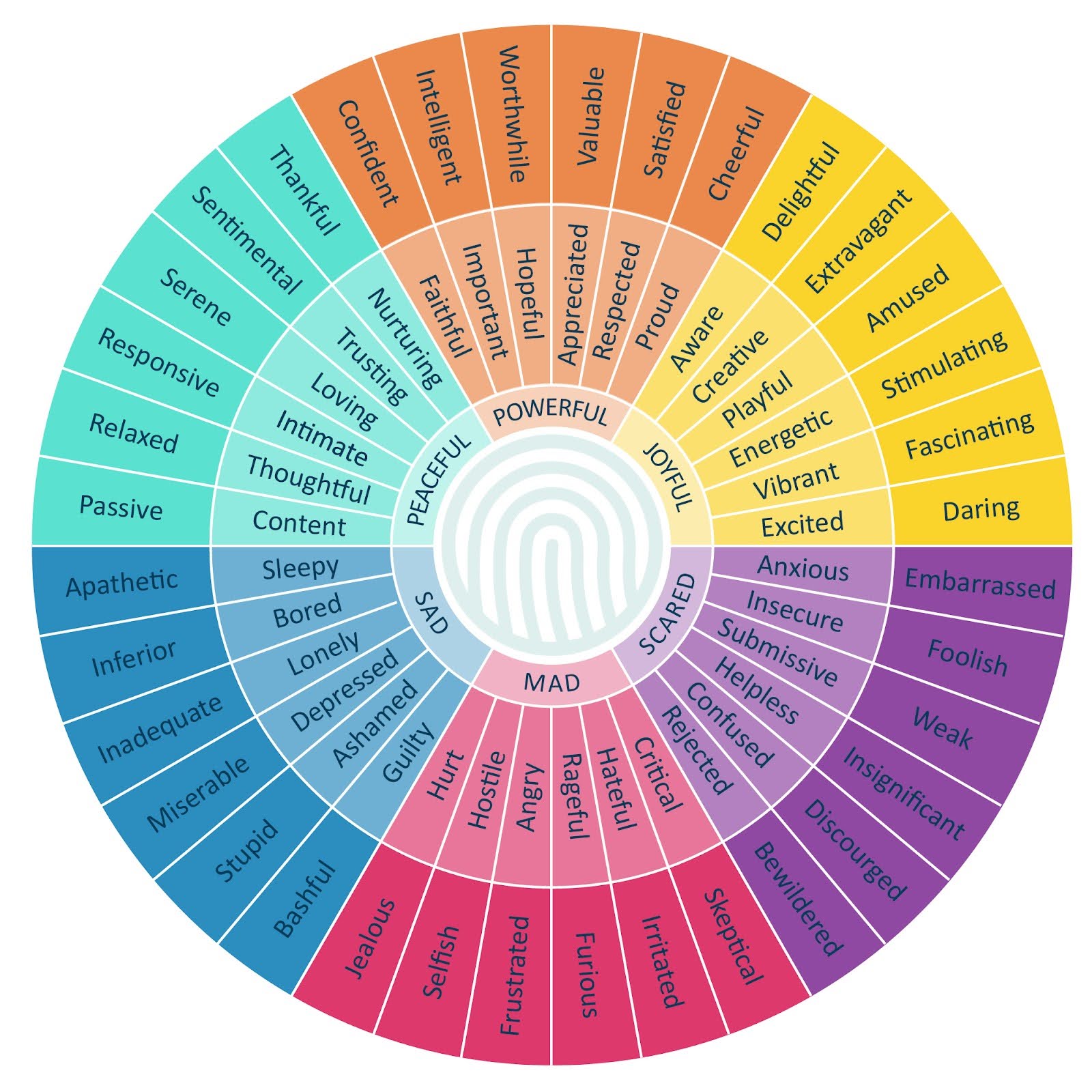
Simplicity

Photo by 베아 밀러 on Unsplash
Memorable
After gauging simplicity, consider how memorable your phrases are. Are the words that have natural emphasis? To measure memorableness, try the “30 test.” Could someone memorize your statements in thirty seconds and recall them in thirty minutes or thirty days? Perhaps offer your ideas to a friend or colleague and ask them in three or four days—are you able to recall what I shared with you?

Case Study
Samsung’s purpose is to “help people achieve the impossible.” This purpose provides the basis for the company’s mission statement and vision statement. This business purpose directs the company’s corporate mission and vision statements to focus on tools and solutions that people can use to “achieve the impossible.”

Samsung’s Mission Statement
Samsung’s mission is “to devote its talent and technology to creating superior products and services that contribute to a better global society.” This mission was published when the company was undergoing rapid global expansion in various semiconductors, electronics, and related technology markets. Based on its business operations and current international industry positioning, Samsung focuses on the following components in its mission statement: human and technological resources, superiority of Samsung products and services, and the focus on improvement of the global society In its mission statement, Samsung identifies human resources and technology as the two main assets that it uses to pursue its purpose and strategic objectives in its global industries.
Samsung’s vision is to “inspire the world with our innovative technologies, products, and design that enrich people’s lives and contribute to social prosperity by creating a new future.” The company follows this vision statement to maintain profitable technology business operations that contribute to the improvement of people’s lives. Samsung frequently refers to a shortened version of this corporate vision, as follows: “Inspire the World, Create the Future.”
Based on its vision statement, Samsung’s strategic objectives include the development of products that inspire. This inspirational aspect requires the company to consider local and regional market conditions to ensure that its technological products inspire people despite differences in their societal situations. Samsung’s corporate vision also pushes for a high degree of innovation.

Exercise
1. Why it matters
2. Powerful phrases
3. Inspiring
4. Easily understood
5. Action-oriented
6. Meaningful
7. Simplicity
8. Memorable

Course Manual 4: Impact Awareness
Impact awareness: An essential skill of optimized leaders is having an awareness of their leadership and communication with others. When executed with excellence, MVV has a high potential for optimizing impact.

Photo by Florin Palamarciuc on Unsplash
Understanding Impact Awareness
Impact awareness in leadership refers to a leader’s understanding of how their actions, decisions, and behaviors influence and impact others and the organization as a whole. Leaders who practice impact awareness are mindful of the ripple effects their words and actions have on their team members, organizational culture, customers, and stakeholders. This type of awareness helps leaders make mindful choices that align with the well-being of their teams and the larger goals of the organization.
There are several key aspects of impact awareness for leaders to consider. First, it starts with self-awareness. Self-awareness is the ability of leaders to understand their own strengths, weaknesses, biases, and motivations. This self-knowledge allows them to be authentic in their leadership role as their personality and leadership approach will be integrated. This also will align their actions with their values. This results in increasing credibility and trust among team members. Another aspect of impact awareness is empathy and emotional intelligence. Leaders with impact awareness will consider the emotional and psychological safety experienced by others. They will understand that their actions can directly impact morale, motivation, and productivity. With this knowledge, they will prioritize clear, compassionate, and open communication.
With greater impact awareness comes greater MVV-aligned decision-making. Leaders with impact awareness consider the long-term effects of their decisions on both people and the organization. They stay away from making impulsive decisions. This allows them to focus on those decisions that are ethically sound, MVV-aligned, and beneficial for the organization long term. As an optimizing leader increases their impact awareness, they will experience an increase in cultural sensitivity. This strength will help them to recognize the diverse perspectives within an organization. Optimizing and aligned leaders ensure that their actions do not unintentionally alienate or disadvantage any group. They strive to be inclusive and equitable, understanding how their influence shapes the company culture.
Understanding impact awareness will create a feedback-oriented approach for the leader and for the whole team. Leaders who are impact-aware actively seek and act on feedback. This has become a daily success pattern habit. They are open to learning from how their actions affect others. They will strategically use this feedback to continuously improve their leadership style.
This strategic improvement will result in an increased proactive and positive mindset around responsibility and accountability. Optimizing leaders welcome it, encourage it, and foster it for others. There is not a fear of accountability. In fact, optimizing leaders often view accountability as a necessary fuel for success. These leaders accept responsibility for their actions and are accountable for the outcomes of their decisions. They understand that leadership impact extends beyond immediate results to include the legacy they create.
Impact-aware leaders foster a culture of trust, respect, and collaboration. The impact-aware leader will influence a healthy work environment where employees feel valued and empowered. This will lead to higher engagement, productivity, and overall organizational success. By consistently considering their impact, optimizing and aligned leaders can inspire positive change, support resilience, and create increasing value for the organization.
Analyzing Impact Awareness

Photo by National Cancer Institute on Unsplash
To analyze your impact awareness, consider the following areas and write down a reflection or action steps for each. Accountability. How accountable was I today? How did I help hold others accountable today? Who did I notice accept accountability or rescind? How can I increase the mindset that accountability is a success metric for optimizing leaders and increases leadership alignment? Who can I follow up with to ensure they have what they need to be successful in fulfilling their accountability? These are several considerations when analyzing your impact awareness as it pertains to accountability.
Another key factor to consider when analyzing your impact awareness or the impact awareness of your team is sensitivity. Each leader, in fact, each human, will have a different sensitive metric on just about any sensitivity scale. What is yours? Keep in mind you may have sensitivities to things that others do not, and vice versa. How do you know? Which ones are more important? It may not be feasible to gain information or answers to all these factors; however, increasing sensitivity awareness and skill is essential when strengthening impact awareness. You may have heard the phrase “read the room.” What does this mean, and how does one do this? It means having a social sensitivity awareness about several factors. How engaged are people? What words would you use to describe the “feel,” “temperature,” or “dynamic” in the room? Is it tense? Is it playful? Do people seem quiet, anxious, or passionate? How does your “feel for the room” compare or contrast with other optimizing leaders in the same room? To increase sensitivity awareness, the leader can make a note before and after each meeting or conversation and then ask for input from one or two other team members. This success habit will aid in increasing sensitivity awareness.
Decision-making is very significant when analyzing impact awareness. Decision-making often has a direct impact on the felt experience of psychological safety of team members. There are typically four approaches or levels to decision-making. The impact on psychological safety comes in when there is not clear communication about which approach is being taken and why. The first level of decision-making is when the leader makes the decision by themselves. The second is that the leader will make the decision with input from key stakeholders. The third is that the leader will gather opinions from all members and then make the decision towards consensus. The fourth is that the group will decide by vote.
Lastly, it will be necessary to analyze your self-awareness and social awareness and also what level of EQ you are utilizing. This can be done in several ways. Leaders can take personality or EQ assessments to gauge where they are currently and where they would like to be in six to twelve months. Optimizing leaders can also ask for direct feedback using an informal 360 approach. Some questions can be: When we are together, what words would you use to describe how I make you feel? Is there something specific I could start doing or stop doing that would increase psychological safety for you? When we are having conversation, do you feel heard and understood? What recommendations do you have for me to increase my self-awareness or social awareness? What tools or processes have you used that have helped you?
Efficiencies for Impact Awareness

Photo by Bernd 📷 Dittrich on Unsplash
Let’s explore several. First, start with understanding. A simple understanding habit can be to write it clearly, speak, or let others read what you have written. Ask for their understanding, interpretation, or what would make it more clear. Then revise what you have written and read it out loud for 5 days. How did this practice increase or decrease your understanding? In what ways has your understanding become more clear and efficient? You can use this method for MVV, impact awareness, and other messaging that you are currently crafting.
Having a thorough analysis process will continue to increase your efficiency for impact awareness. At first, establishing a new success pattern, habit, or thought process can feel overwhelming or daunting. It may feel “forced” or “robotic” at first. Do not despair. In a short time, it will become more natural and will flow with ease. All you will need is intention and perhaps a reminder. Adaptation, tweaks, adjustments, and altercations can start to feel fun. This will increase mindfulness through practice and will be ways you can provide small challenges or goals for yourself on a daily basis as you seek to increase your knowledge, awareness, and skill.
Remember to have fun. Feedback, Understanding, and Next Steps. This is the F.U.N. formula. Ask for feedback, increase your understanding, and write clear next steps that you can take action on. Keep these steps specific, clear, measurable, and attainable in small increments. This will increase joy, momentum, and growth in your leadership development process by increasing your optimizing leadership skills.
How we communicate matters
The power to create culture is often in the action, words, and attitude of the leader. What culture are you creating? This culture will be interpreted and reinforced by responses, behaviors, feedback, attitudes, and actions. Each day, a leader has 2 primary focuses. How do we get the job done most effectively and efficiently? And how to lead their team toward constant engagement, improvement, and increased enjoyment. Both are essential. One is not more important than the other; however, certain moments may lend themselves to increased focus on one or the other.
When communicating, consider your body language, tone, inflection, eye contact, hand gestures, pause, breath, shouting, etc. These and many other factors will play a very important role in creating or reducing leadership and team alignment. How did you say it? How did it come across? What impact did your words, tone, nonverbals, etc. have on others? What was the impact you wanted to create? Why? Did how you say it increase team alignment or decrease it? How do you know?
There are many factors to consider when measuring impact on others and your awareness of this. The chart below illustrates what creates an impact on others. The greatest impact one can have on others is how you make them feel. Emotional Sensitivity + Empathy + Active Listening = 70% of your impact on others. What does this have to do with mission, vision, and value statements? Considering how your MVV statements make others feel will give you great insight into their impact. The reason impact is important is because without impact, very little will grow, change, improve, or increase in your team or organization.
5 areas of Impact Awareness
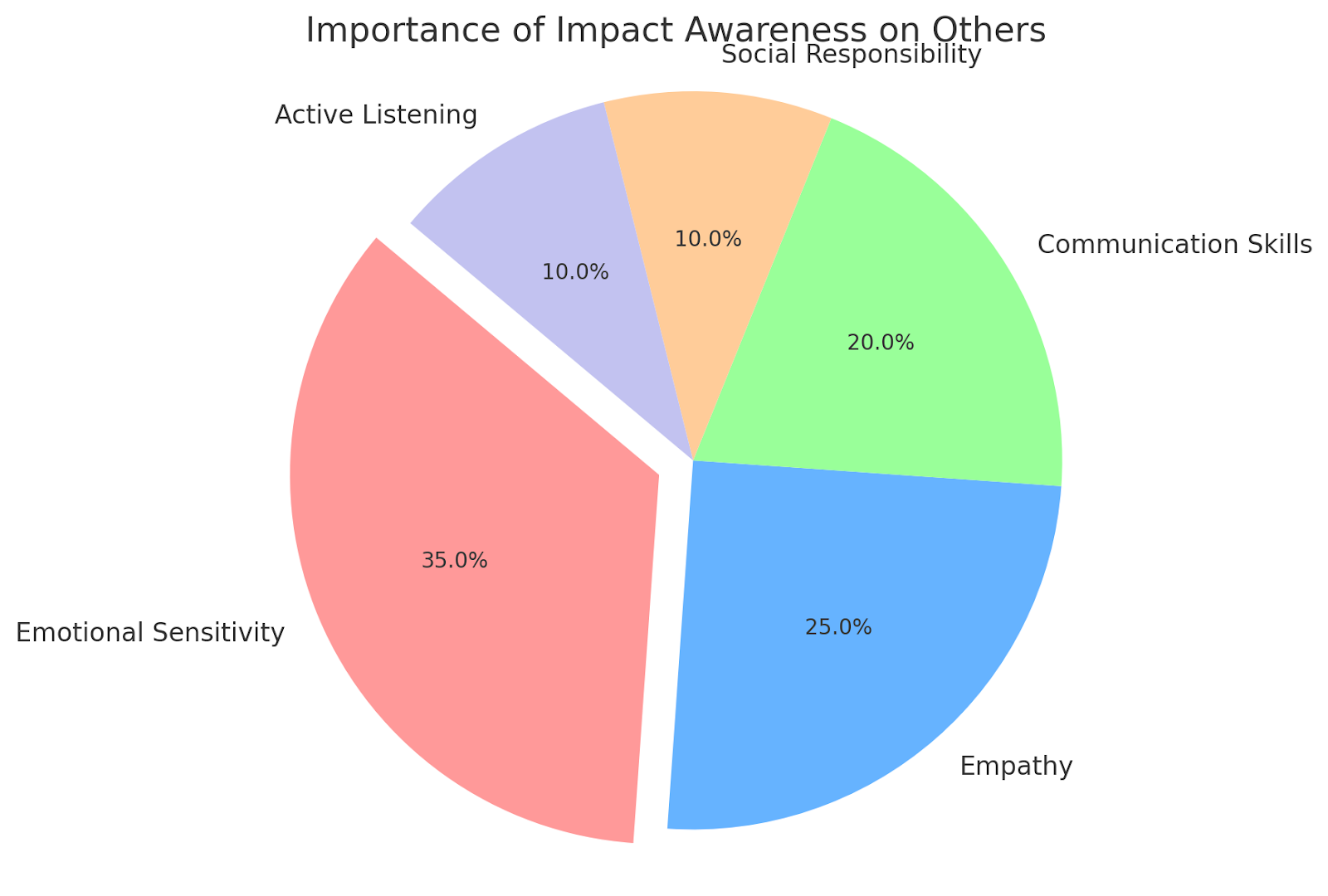
The following key categories contribute to “impact awareness” and their importance.
Emotional Sensitivity: Being aware of how your actions affect others’ emotions (35%). This aspect makes up the highest percentage of impact awareness, and rightly so. But how do you know how your actions affect others’ emotions? There are several ways: ask them, read the room, discern body language and facial expressions, ask others how you came across, reflect and adapt, utilize 360 feedback, etc.
Empathy: Understanding and sharing others’ feelings (25%). For some, this comes naturally. For others, it is a learned skill. For leaders, it is essential and non-negotiable.
Communication Skills: Ensuring clarity and understanding in communication (20%). This is not only true and essential in MVV work but in all aspects of communication. A case could be made that the measure of a leader is how you make others feel and how well you communicate.
Social Responsibility: Considering the broader consequences of one’s actions (10%). This will be essential when crafting and evaluating both your impact awareness score and your MVV.
Active Listening: paying attention and responding to feedback (10%). See the prior chapter for more on active listening and how to practice it.
When combining understanding with skill development in these essential impact awareness categories, optimizing leaders will continue to learn, strengthen their skills, and have a keen insight into how they are optimizing. This insight will also provide a clear resource when training and equipping other leaders to optimize their leadership skills, mindsets, and behaviors. When leaders teach others how to be leaders, this actually increases their own leadership skills and capacity.
Resources to train others

Photo by Jason Goodman on Unsplash
There are multiple ways, resources, and approaches for your consideration. Books: “Leaders Eat Last” by Simon Sinek; The Leadership Challenge” by James Kouzes and Barry Posner; Emotional Intelligence 2.0″ by Travis Bradberry and Jean Greaves. Assessment Tools: HOGAN 360-Degree Feedback**: This collects anonymous feedback from peers, subordinates, and supervisors, giving leaders strategic insight into their perceived strengths, impact on others, and areas for improvement. Emotional intelligence (EQ assessments). Tools like the EQ-i 2.0 assessment help leaders become more aware of how emotions impact their decisions and relationships. Also, the commonly known DiSC Profile. This is a personality assessment that helps leaders understand their behavior style and how it affects team dynamics and communication.
It would be wise to consider using other practices, such as reflective journaling. This encourages leaders to use it to assess the impact of their decisions and interactions on others. Some example Prompts are: How did my actions or communication impact my team today? What could I have done differently to create a more positive and proactive environment that aligns with our MVV or current goals? Optimizing leaders can also use weekly impact reviews. This is where leaders assess the week’s decisions and interactions to reinforce self-awareness.
Investing in coaching and mentorship or peer group programs often provides very high ROI. When an optimizing leader partners with more experienced mentors, this can provide insight, feedback, and perspective on their leadership style and impact. The use of experiential exercises and role-play can be very powerful to strengthen impact awareness. When using role-play scenarios, simply have leaders role-play challenging situations and receive feedback on their approach and impact. Optimizing leaders can also use impact walkthroughs after a decision or project. The leader can map out the impact effects on team morale, productivity, and other outcomes. Using case studies and group discussions (such as this course experience is providing for you) can have a significant impact on leadership development. Reviewing real-life scenarios or case studies on leadership impact can be quite powerful. Leaders can discuss what the leader did well or could have improved and explore alternative approaches. Feedback mechanisms or regular feedback loops are essential. This is where teams are encouraged to provide honest, constructive feedback to their leaders. Another common practice is the use of employee engagement surveys. This gives leaders insight into the impact they have on team morale and productivity. Combining these resources and approaches can help create a holistic program for leadership impact awareness, emphasizing practical, reflective, and actionable learning.

Case Study – Leadership Impact Awareness
A tech company with a strong reputation in the industry found itself wrestling with a host of issues that threatened its position in the market. They were experiencing declining sales, a high attrition rate of employees, and morale was very low across the organization. The leadership style at the firm was predominantly hierarchical, with a top-down dominant approach. This negatively limited communication and innovation. This resulted in ambiguity, which led to a disengaged workforce and overall poor performance.
Through an initiative that focused on impact awareness, empathy, communication, and accountability (of leaders first and foremost), things began to change. There was an increase in priority placed on quality of communication. More awareness and skills were developed for the emotional impact of leadership. They also increased the priority on employee experience and customer experience.
The results? The employee engagement results improved dramatically by over 40%. Employee turnover rate significantly reduced by 30%. This created an increase in cost savings for recruitment and retention of company knowledge. Sales increase 20% in the first year due to the focus on customer and employee quality of experience. Overall, the company’s financial vitals improved, and there was increased financial health and increased growth and profitability.

Exercise
1. Write down 3 areas that are critical to your role (think communication).
2. Consider: What feedback do you want? What changes are you open to?
3. Share with your partner. Get input.
4. Write 1 action step.

Course Manual 5: Adaptive Analysis
In this section, we will explore how adaptive anaylsis will be a necessary and ongoing practice. Rather than relying on static data (for instance, how we’ve done it for years), optimizing leaders will rely heavily on an adaptive analysis process. Identifying what is working and what is not working with your MVV, communication, and alignment. Although your mission may not change, how you communicate it and how aligned others are will need constant adaptive analysis.
The reason adaptive analysis can be so effective during a leadership alignment process and MVV work is that it is highly collaborative. Because new data will constantly be needed, it begs for a curious mind and helps optimizing leaders stay open, fresh, and asking good questions. The adaptive analysis process is powerful not only during MVV alignment but in many other aspects of leadership work. Adaptive analysis can be used during change management, leadership development and transition, new product launches, and many other situations that face leadership teams on a regular basis in most every industry.
During this section, we will use the UAE process (Understand, Analyze, Efficiency) to deepen skills and create alignment in both the leadership team and the MVV work. The outcome of this chapter is to create appreciation for, practice of, and efficiency results when utilizing an adaptive analysis process.
Understanding Adaptive Analysis

Photo by charlesdeluvio on Unsplash
Simply put, adaptive analysis is a dynamic approach to assessing and understanding data by regularly refining analytical methods and models. This process is based on real-time feedback and changing circumstances. Instead of relying on static models, adaptive analysis adjusts its approach as new data and insights come forth. This makes it highly responsive to shifting conditions. This technique is particularly useful in fields where conditions are volatile and subject to swift or steady change. When real-time decision-making is crucial, such as in finance, cybersecurity, and predictive maintenance, there will be a need for adaptive analysis. Adaptive analysis improves the accuracy and relevance of its predictions by updating algorithms, supporting stronger decision-making, and uncovering more meaningful insights.
The diagram below provides a simple illustration of how an adaptive analysis process functions.
This process uses the steps of input data, preprocessing, model training, evaluation with feedback, adjustments, decisions, and action, and final output results. Each step connects in a loop. The reason for this is continuous improvement based on new data and insights.
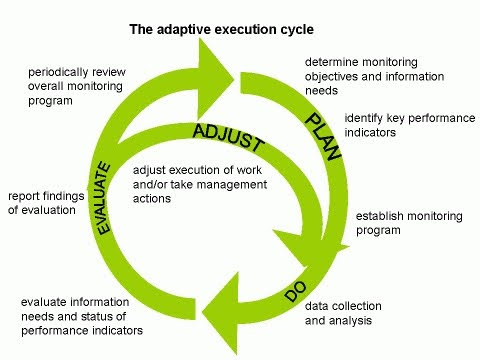
When initiating an adaptive analysis process, it will be critical to identify what the focus or parameter of your analysis is and what type of data you will need to collect. This focus will result in better results, accuracy, and efficiency. What is it that you are seeking to evaluate and adjust? Why? What will the new data provide for you when making critical decisions? Consider these questions and others as you set out to use an adaptive analysis process. When completing an adaptive analysis process for your MVV or for an outcome of leadership alignment, be sure to have a specific focus point for your data. Don’t think to broadly or the data you may be vague and not as helpful. An example of this could be, rather than asking, “Do people like our mission statement?” You may seek to identify which people’s input or feedback would be most valuable and why. Is there a select group of your client or customer base you are seeking data from? Is this based on market expansion in that area? And rather than only asking for a yes or no, or a thumbs up or thumbs down, you might ask, “Which word or phrase did you find most meaningful?” This data will give you much greater insight into the wants, needs, and priorities of your buyer.
Once you’ve collected your initial data or feedback, you can use it to evaluate the quality of the data and how it will align with performance indicators. Using the example above, if people responded to your mission statement question with “I didn’t find any words meaningful,” this will give you a strong indicator that your mission statement is certainly underperforming! Once you have collected your data and aligned it with key performance indicators, you will then need to report your findings and results. Who are you reporting to? How many people? What departments or levels in the organization or outside the organization? What numbers, words, and visuals will make the reported data more clear and powerful? Be mindful of your biases here, in case you may be trying to prove something according to your own agenda. Let the data speak for itself.
Once you have reported the data, this will be an opportunity for an adaptive analysis process decision. Is there an adjustment needed? Is there an opportunity to try it a different way? What exactly needs to be adjusted and why? What benefits or outcomes are you seeking from this new adjustment? Is there an opportunity for greater leadership alignment as we make this adjustment? There will also be a need for management actions if an adjustment is chosen. If there is a new process to implement, tool to use, or change, it often will require clear communication and perhaps some training. Otherwise, there could be a risk of confusion and misalignment, which is not the desired result or outcome.
Once an action is taken or an adjustment is made, this creates a new opportunity to execute the adaptive analysis process once again. You would simply follow the same steps in the process, starting with your focus and data collection, then evaluation, reporting, and adjustment decision or action.
There is an additional layer or “ring” around the adaptive analysis process. There will be a need and opportunity for periodic review of the adaptive analysis process, what adjustments or adaptations have been made, what learning has occurred, and what data collection process is most useful. This “outer ring” can happen periodically (monthly at first, then quarterly or as needed). The primary objective of this monitoring process is to take a step back and review the bigger picture, plan your objectives, focus your information and data needs, and identify your key performance indicators.
ANALYSIS: What’s working, and how do we know?

Photo by Razvan Chisu on Unsplash
When initiating your adaptive analysis process, you can use these questions, among others. This can be done as a self-reflection exercise or a team conversation. Either way, the results of the conversation or reflection can be shared with others to increase awareness and strengthen alignment. Consider the top two or three successes of the team in the last ten days. What wins did we experience? How did that happen? What factors supported our success? How did it feel to be successful? What ways did that success inform our processes? What decisions had we made previously that led to that success? Are there commitments we made or considered making that created success in that moment for us? What feedback did we receive from team members or customers that let us know we were successful? What feeling or experience did it create for others when we were successful?
As you consider and answer these questions, be sure to write down your responses. This will be even more effective if this is done visually where others can see. The reason for this is now you have created a success recipe. Success recipes are very powerful, and they make for a very empowering “alignment meal.” Once you have your list, or success recipe, take a moment to step back and analyze the list. Are there certain patterns forming? Do key themes stick out to you or team members? What numbers, names, details, or words rise to the surface for you? Try this. Lift key words, phrases or details and quickly write a mission or vision statement using only those words. Do this quickly and as if you were launching a brand new business, and the success recipe is the only data you have to craft a mission or vision statement.
When you have a clear picture of your success recipe or success pattern, you will see what is working. Now take a moment to consider what other success formulas have stuck out to you or your team members recently. This will provide you with a broader scope of what’s working. The point here is not to create an exhaustive list. Sure, you could keep going, identifying all the big and small successes you and your team have had over the last weeks, months, and even years. This is simply a success sample size. When you have a clear picture of what is working, pause for a moment to appreciate what led you to create such success. Who supported you? How did you get here? Are there those whom you wish to thank and express gratitude? Often, our successes are not accomplished in isolation. There are many who have crossed our paths and that have lifted us up. And we have done that for many others. In fact, success often begets success. This too is a success pattern for optimizing leaders that creates very significant leadership alignment.
At times, successful leaders may have a “next” mindset. On to the next opportunity, challenge, problem to solve, or situation to handle. This is quite natural for many successful leaders. However, practicing pause, reflection, pattern recognition, and gratitude is a very healthy and necessary part of the optimizing leadership mindset and habit. We will take a deeper look at those later, in another workshop and chapter. For now, let’s consider that this habit of naming successes and understanding how we know we are successful will continue to accelerate our leadership optimization and team alignment.
How do we know when we are successful and when something is “working”? Is it a feeling, an outcome, feedback, or result? Often it is all of these and usually begins with a desired outcome and a process or system to produce said outcome. It’s been said that your process or system is perfectly designed to produce the outcome or result you’re getting. And if you want a different result or outcome, then you will need to change your system or process. To know if something is “working,” consider the results you are getting. Are they the results that you wanted or expected? When did you identify the desired outcomes? Have they changed along the way? To know if something is working, identify your desired outcomes or results you want to achieve. Then design a process or system that is likely to produce said results. Next, test the results along the way and make adjustments based on the data or feedback you receive. Analyze your process and outcomes to see if there is opportunity for more efficiency in your process or greater outcomes than initially desired.
ANALYSIS: What’s not working? How do we know?

Photo by Francisco De Legarreta C. on Unsplash
A word of caution here. There can be a risk of “blame” when failures or mistakes happen. Do not fall into this trap. When there is finger pointing and a “who-dunnit” approach, this often creates an atmosphere of fear and fear of failure. When people experience this on a regular basis, there are not many opportunities for growth, improvement, success, learning, or adaptation. In fact, this will often produce the opposite impact that an optimizing leader seeks to produce. And certainly there will often be a significant decrease in team alignment. People may take sides or hide from the issue.
When analyzing what went wrong or what isn’t working, it will be important to “frame the conversation.” This can be accomplished by sharing that it is vital for the success of the project and the success of team alignment that we consider mistakes as valuable for adaptive analysis. These mistakes and what we learn and how we adjust will help us grow and succeed. With this approach, when something goes wrong, people are more apt to share it quickly (rather than delay for fear of retribution), because the sooner the data is shared, the sooner the adaptation decisions or actions can be made and the sooner the desired outcomes can be achieved.
In order to have a clear picture about how to know when something is wrong or not working, it will be vital to have regular checks and balances or feedback loops. Consider each person, each part or step in the process, and each desired outcome as a data point. Each data point will have several other data points that impact it or go into it. It will be necessary to design feedback loops for each data point. This will prevent something going on for far too long that is not working or producing the opposite of the desired outcome.
ANALYSIS: What needs to change?
Not all adaptation is created equal. In an adaptive analysis process, it will be important to make strategic decisions using critical thinking and collaborative input to align on the changes that will be necessary to ensure success. Take, for example, a new housing project. Perhaps new information was made available that the storm water management retention basin and system was not going to cost $90 million rather than $45 million. This is a significant financial difference. With further review, maybe it’s possible to reduce that increase by 30% if certain materials are used instead of other materials, or simply where the basin is placed on the footprint of the project. While these adaptive analysis data points are being considered, additional information comes along that indicates blue hats are better to wear on even days. The second bit of data about the blue hats may be relevant and worth consideration; however, the implications of that change would be much less significant than the storm water management system retention basin.
When embarking on an adaptive analysis process, one will certainly identify the focus, the data, the outcomes, the evaluation, the reporting, and the adaptations. All of these are necessary elements to the adaptive analysis process. It will also be important to consider what may need to change. What is our commitment level to making changes? What is our change decision-making process? Who needs to be involved? Who needs to be informed? Are there budget or financial limitations that need consideration? What values and priorities will we use when making our decision? Will we limit the number of decisions we will make? These and many other questions may be used to determine what needs to change.
ANALYSIS: What have we learned?

Photo by Adomas Aleno on Unsplash
Documenting learning will be a highly valuable element of your adaptive analysis process. When you are in the midst of your process, you may be faced with many challenges or problems that will require your time and attention. You will make decisions. You will adapt. You will make changes and solve problems. And then, over time, you may forget what you learned through the adaptation process due to new challenges, problems, and processes. Writing down and immortalizing what you have learned will serve you and others after you with significant institutional knowledge. Many lessons that you learn, you and your team will not have to re-learn. You may simply recall you had faced something similar before. What was that case? What was that process? Then you may remember a detail, a name, which year or quarter it was, who was on that process, etc. When you have a written record of your adaptive analysis process, you will have a very reliable resource (much more reliable than memory, which can change over time.) You will be able to easily access lessons learned that you can swiftly apply to your current process without having to “recreate the wheel”.
When you are going through your adaptive analysis process, having a regular process of documenting what you have learned will be a great resource for you. First, pause for reflection. Consider: What have I/we learned through this process? What are we still learning? What helped us to learn? What got in the way of our learning? Are there things we still wish to learn? Who have we shared our learning with? Who would benefit from and appreciate this learning? A regular habit for optimizing leaders will be personal reflection, and team alignment conversations will be around what you are learning through your adaptive analysis process and what you are seeking to learn. Taking the time to incorporate this discipline into your workflow and regular work processes will only increase your optimizing leadership skills. Having the written record of learning will be of great value to you and your time and provides a valuable resource for future team members. An additional benefit of recognizing what you have learned and are learning will also increase curiosity and good question-asking on your team. This will enhance your critical thinking and decision-making process and produce better results overall.
ANALYSIS: What outcomes are we still seeking?
Certainly at the start of any adaptive analysis process there will be a set of desired outcomes. There may be specific data points you and your team are seeking. There are learnings you may have sought, learned, and documented. There are decisions made and actions taken as part of your adaptive process. It will be wise and necessary to take a moment to review all of these important priorities. Once you have done so, there will be another important step to take. This may be done with each adaptive analysis process or during your period overview of your monitoring process. Consider what other outcomes you are still seeking or
Another consideration will be that perhaps there are new outcomes that were not quite expected. Was there something new that you or your team learned that you did not anticipate or set out to learn? This process of positive and curious inquiry can often lead to new opportunities or new developments. This is a great space for innovation and invention. Typically, when something new is unearthed, it may not be ready to be put into action or even evaluated. There are simple processes that can be quite helpful when naming and considering new ideas or opportunities to explore.
The working genius model gives one approach.

The elements of working genius are wonder, invention, discernment, galvanizing, enablement, and tenacity. These spell the word “WIDGET,” so it’s easy to recall.
Wonder is the ability to identify opportunities and ask the right questions. What opportunity is opening up for us right now? I wonder where this might lead us if we pursue it. What might we consider about what we are learning and what meaning it may have for us?
Invention is the ability to create creative solutions to problems. Is there a new way to do this requiring fewer resources? Is there a better way to solve this that would produce greater outcomes? What if we tried x to accomplish y?
Discernment is the ability to assess ideas and make informed decisions. It will be necessary to include discernment in your process to test assumptions and the viability of ideas. However, do not start with discernment; otherwise, it might limit creativity and innovation. What resources are needed to accomplish great outcomes? Do we have easy access to those necessary resources? What data is needed to make our best decisions? Is there anything we haven’t yet considered that we may need to? What obstacles may limit outcomes or success?
Galvanizing is the ability to inspire others to take action. This piece is a critical next step in this process; otherwise, there will be many good ideas and conversations that will not produce actions or outcomes. The key word here is inspire. First identify what inspiration was felt through the wonder, invention, and discernment steps. Try to name three or more inspiration words. Write them down visually for all to see. Then ask, when you see these words, what inspires you? What emotions do you feel? How would you describe your energy or passion around these words? Taking the time to have the “inspiration conversation” here will be critical. This is because inspiration ties into the “why” or passion or purpose people experience. When this power is accessed, there are much higher levels of buy-in or commitment for people to take action and follow through on commitments.
Enablement is the ability to provide support and resources to help others succeed. The key word here is others. This has a very strong teamwork and collaboration aspect. It is others-oriented. The enablement mindset for this step in the process is “How can I help move this forward in a way that is aligned with our desired outcomes and provides success for the whole team?”
Tenacity is the ability to see projects through to completion. Without tenacity, there will be many unfinished projects. Tenacity keeps going when things get tough. The mindset of tenacity says to any obstacle, “Go ahead, try and get in our way. We simply will go over, under, around, or through you.” Having a clear picture of completion will be essential for tenacity to be successful.
The process consulting model gives another approach. This process begins with defining the “IT.” The “IT” is the big goal, the primary focus, the challenge that needs to change (or is causing us to change). It is the most important and highest priority. It is the major outcome we want or need to realize in the future. It is an aspect of the description of our desired state or vision. Once the IT is clear, defined, and written, then initiate this list of simple yet powerful questions. Why is IT important to you? To you team members? To your organization? Who will be impacted by this IT when it happens? Who will be involved in making it happen? Who will need to be informed of progress? Who is critical to the successful outcome of this process or project? What are the desired outcomes, goals, or objectives? What resources are needed to create success? What roles will each participant play? When will this process take place? Where will it take place, both physically and sphere of influence? How will success be achieved? How many checkpoints, meetings, or conversations will be needed? How will results be reported? How will we make adaptation decisions?
Both the working genius (WIDGET) process and the process consulting question approaches can be very effective for discovery and exploration of new initiatives, pilot projects, and additional outcomes sought.
EFFICIENCY: Adaptive Anaylsis Alignment Benefits

Photo by Christina @ wocintechchat.com on Unsplash
One of the primary benefits of the adaptive analysis process, especially when done regularly and in a team setting, will be that of leadership alignment. In this section, we have focused on leadership alignment as it pertains to your MVV. Certainly this is a core and essential way to gain and maintain strong leadership alignment. However, there are many ways to continue to optimize your leadership and your leadership alignment. An adaptive analysis process will become a core curriculum or essential ingredient in your success recipe. Consider it this way: how many data points did you receive as part of your adaptive analysis process? Count them. I’m sure it will be many. Thousands even? Now consider how many adjustments were made or decisions toward action? Count them. They may have been few, but probably quite significant. Now consider the evaluation process you used for the data points that led to the decision or adaptive action. Who was involved in this evaluation and reporting process? Lastly, think about what learning you gained as a result of going through the adaptive analysis process. Add up all of these perspectives, and you have a vast number of “touch points” with your leadership team. Touch points are essential for any aligned team. Touch points are those small yet significant points of contact you have with your team members. It could be emails, conversations, reviewing data, making decisions, taking action, listening to each other, hearing and respecting a perspective different from your own, and the list could go on. All of these touch points are part of the algorithm of leadership alignment. Well done!
EFFICIENCY: Extreme Ownership
When that algorithm of leadership alignment is strong, you will start to experience something. Momentum. What you will start to notice happening is an increase in engagement. People will be consistent in their full presence at meetings. They will be responsive to emails. They will ask good and engaging questions. There will be a lightness to workflow, even when there is stress or high demand. People will be willing to take on greater responsibility. They will strengthen critical thinking skills.
Extreme ownership is a leadership framework principle. It happens when leaders take on responsibility for everything in their world, including the actions of their team. There is no blame or pointing the finger. An extreme ownership mindset recognizes that the success or failure of the team is my success or failure. This is the way of an optimizing leader. This can be difficult to achieve because there is risk. It comes with an understanding that, as a leader, you realize that it always starts and finishes with the leader. When this truth is embraced, extreme ownership does not feel forced; it feels natural and comfortable.
Extreme ownership is made evident by:
Taking responsibility. Leaders take responsibility for failures and mistakes. They don’t blame others. For example, if a task isn’t completed on time, the extreme owner leader would ask curious questions to determine what went wrong and how to improve in the future, rather than try to identify who dropped the ball.
Being objective. Leaders view problems through an objective lens. They don’t take things as personally and don’t allow ideas to be identified with people. They know how to express emotions appropriately without being attached to plans or agendas.
Building a better team. Leaders work to build more effective teams by training and mentoring team members and giving credit to team members. They are not seeking the limelight for themselves.
Communicating clearly. Leaders make simple plans and communicate them clearly so that team members understand the task or mission. Typically, plans are written down in a way that others can understand them with ease.
Leading with humility. Leaders lead with humility and not a big ego.
[The Extreme Ownership Framework is based on the principles of Jocko Willink and Leif Babin’s New York Times bestselling book.]
EFFICIENCY: Swift Success
Success, results, outcomes, objectives, and deliverables are all wanted and very important for optimizing leaders. There is a saying to work “smarter and not harder.” The optimizing leader will begin to see more and more successes with more and more ease. This is because of several factors: clarity, clutch delivery, adaptation, commitment, communication, and both EQ and IQ wisdom strength. What used to take 80% to produce 20% will now be inverted due to these optimizing leadership habits and patterns. Now 20% will produce the 80% return, which will leave you with increasing clarity on where to align your efforts to optimize your results.
Clarity will come as you continue to prioritize, communicate, evaluate, adapt, produce results, and continue an adaptive analysis process. With this clarity, you have greater ability to communicate more succinctly and with power. This power will result in clutch delivery for you and your team time and time again. Your EQ skills and abilities will continue to be strengthened. EQ equates to 80%-90% of an optimizing leader’s success. More to come about EQ in later workshop chapters. This will result in greater commitment and buy-in from your team, producing increasing results that win. This improvement will have a snowball effect and come more swiftly and with greater ease.

Case Study: Adaptive Analysis, Monitoring, and Management Process Used by a Netherlands Company to Optimize Operational Environment.
As an integral part of a 25-year project, contractor PUMA utilized an adaptive analysis process to determine technological readiness levels for sandy coasts. This iterative process of analysis, monitoring, and management resulted in a technological readiness score of 9/10.
The Maasvlakte 2 (MV2) case was selected to investigate how using adaptive monitoring helped and added significant value to the project. For the lifespan of the Mainport Rotterdam environment, adaptive monitoring and evaluation plans were used. The goal was to verify how actual effects related to an activity compare to various scenarios and to gather data for filling essential knowledge gaps. Every five years, this adaptive analysis, monitoring, and management process is completed. If needed, management plans are adjusted.
The focus of the adaptive monitoring plan was verification of the predicted scenarios and closing knowledge gaps on nature, fish stocks, and morphology. In 2008, a monitoring plan was created with the aim to verify the expected scenarios and fill the most important knowledge gaps. The monitoring plan follows the adaptive execution cycle: every five years, the monitoring plans are evaluated. If needed, the management plans are adjusted. Using the adaptive monitoring plans, there were two evaluation processes used. First, there was a structural evaluation of the complete monitoring plan. This adaptive monitoring process was conducted every five years. Second, an adaptive evaluation process was used to analyze results within certain themes. There were periodic meetings to discuss progress and results. Suggestions for adaptation of the monitoring plan were also discussed at these sessions, e.g., to adjust the monitoring frequency or to consider conducting additional measurements. Based on the baseline monitoring results, adaptations of the initial monitoring plan have already been made for some elements.

Exercise (2 groups of 5): “Rapid Reflection”
1. Name a recent success and write it down
2. List 3 items that were critical to that success. Be very specific. If these items weren’t present, you would not have been successful
3. Notice how each item makes you feel. Write a feeling word
4. Combine the 3 item words with the 3 feeling words
5. Write a rough mission or vision statement using only these 6 words and necessary connecting words (and, the, by, etc.).
6. Read your statement to the group
7. Identify common themes from the 5 statements

Course Manual 6: Increasing Alignment
Knowing how aligned you, your team, and your people are to your MVV and how to increase alignment is a significant skill for optimizing leadership. There can be a risk of, “Ah, we’ve arrived and we are fully aligned.” Don’t fall into this pitfall! (more to come about alignment pitfalls in the next chapter.) Maintaining and increasing alignment takes dedication, focus, steady work, and repitition. At times, leaders may feel “alignment fatigue.” They may say, “I already have a full-time job, producing xyz results, products, or revenue.” “I can’t worry about leadership team alignment!” “It’s too much!”. If you have said this, felt this, or thought this, take care; you are not alone. This is common on the optimizing leadership journey and simply means you may need a break to catch your breath or that you and your team are on the verge of a breakthrough.

Photo by le Sixième Rêve on Unsplash
What it takes: dedication, focus, hard work, repetition
In order to create and ongoingly increase your team alignment, there will be several important commitments you and your team will need to make. At times you may need to “re-up” your commitment, remind, or clarify in order to stay on course of increasing alignment. These may be small or big moments to realign with your alignment commitments. Have things seemed off? Is morale low? Do results fall short? Do people seem weary, distracted, or disgruntled? These are important things to notice and act upon for optimizing leaders. When seeking to increase alignment, gauge yourself and your team on your dedication to alignment. A simple way to do this is ask yourself and your team, “Do we want to be aligned?” “How committed are we to our alignment?” “What is helping us maintain and increase alignment?” “What might be getting in our way to increasing alignment?” A simple reflection like this and a conversation with your team periodically will allow you to have clear insight into the commitment and dedication toward increasing alignment.

Photo by jose aljovin on Unsplash
The dedication and focus for team alignment around your MVV will only strengthen leadership alignment with hard work and repetition. Do not fall into the trap of thinking that this is “once and done” or will come with little effort. It will take commitment, time, hard work, and repetition. This does not have to add to stress or overwhelm. In fact, you will probably experience the opposite impact. The focus, hard work, and competition will create a sense of simplicity or ease. Knowing exactly what needs done each day and each moment to increase alignment provides strength and confidence to continue on the leadership alignment journey.
Most great athletes will say that having a routine with daily repetition is what led to their greatest accomplishments. Repetition and daily routines are essential to an athlete’s success. They cultivate consistency, skill mastery, and mental resilience. Repetition builds muscle memory. Metaphorically, your team alignment areas are like muscles that strengthen alignment. By practicing the same habits repeatedly, teams can train their “muscles and nervous system” to perform actions automatically and efficiently, even when under significant pressure. This will result in precision and improvement. The mental conditioning aspect of repetition will result in greater focus and discipline, increased confidence, and smooth adaptability under pressure.
This provides greater strength and endurance, even in turbulent times.
A key principle in habit formation is “consistency over motivation.” Motivation can fluctuate due to many factors. Some factors may be under our control, and some may not. Consistency is key. Having a way to measure progress and experience small wins or incremental gains is essential. With time and consistency, mental resilience will result. This will be a way to manage stress and overcome obstacles as well.
Superstar athletes know this well. Michael Phelps strict training regimen involved swimming multiple times daily while focusing on stroke repetition and technique. Serena Williams attributes her tennis success to consistent practice, repeating serves, and perfecting her baseline game. Repetition and routine create a structured environment where optimizing leaders can refine their skills, maintain peak performance, and build the mental toughness needed for long-term success.
Why it matters: results, experience, progress, momentum

Photo by Daniel Lincoln on Unsplash
When there is a healthy dose of team alignment, there are many positive results. There is an increase in efficiency, both in communication and project/product outcomes. Goal achievement and celebration are a common occurrence for aligned teams. There is often a feeling of “ease” when executing on work. This may not necessarily mean the work is easier, but there will be a feeling of ease due to alignment. It just feels better or feels right. Focus and clarity will be the norm for aligned teams when it comes to tasks and communication. There often are clear paths or channels of workflow for aligned teams as well. All of this will naturally produce optimized levels of team engagement and high retention rates for employees. This all sounds wonderful. Is it attainable? And if so, how does an optimized leader retain or increase this level of alignment on a regular basis?
This conceptual diagram illustrates the importance of team alignment and its role in achieving results, improving experience, fostering progress, and maintaining momentum.
When creating team alignment, focus on results, experience, progress, and momentum.
This ensures the team operates cohesively and effectively. Results drive purpose and provide accountability. Clear results provide a shared goal and purpose. This ensures all team members understand what success looks like. When the team is united around clear and written objectives, their efforts become more coordinated. This increases collaboration and accountability. Having quality and positive experiences builds trust and strengthens engagement. A positive team experience boosts morale, trust, and commitment. Team members will feel valued and motivated. When team members feel appreciation and respect, they will work stronger and harder together to achieve outcomes. When team members feel supported and appreciated, they will align their actions and attitudes toward company and team goals.
Marking progress sustains motivation. Visible progress reinforces the value of the team’s efforts. This provides a sense of achievement and momentum. When progress is evident, team members stay motivated and focused. There is also a reduction in stress, friction, and distractions that can adversely affect alignment. Alignment momentum ensures consistency and growth. Momentum builds confidence and reinforces the team’s capacity to take on challenges and achieve greater things. Consistent forward momentum keeps the team energized and synchronized. This will minimize delays or lack of focus or lack of energy.
When these factors are intentionally addressed, they create a reinforcing cycle. Results will set the destination and provide a clear target for which we are aiming. Having a quality experience along the way will ensure the journey is worthwhile. Noting progress will demonstrate achievement along the way. Momentum provides ongoing energy that keeps the team moving forward. These elements together ensure team alignment is not only achieved but also sustained. This will empower aligned teams to perform at their best.
Aligned teams
This chart illustrates what alignment looks like and when teams are misaligned.
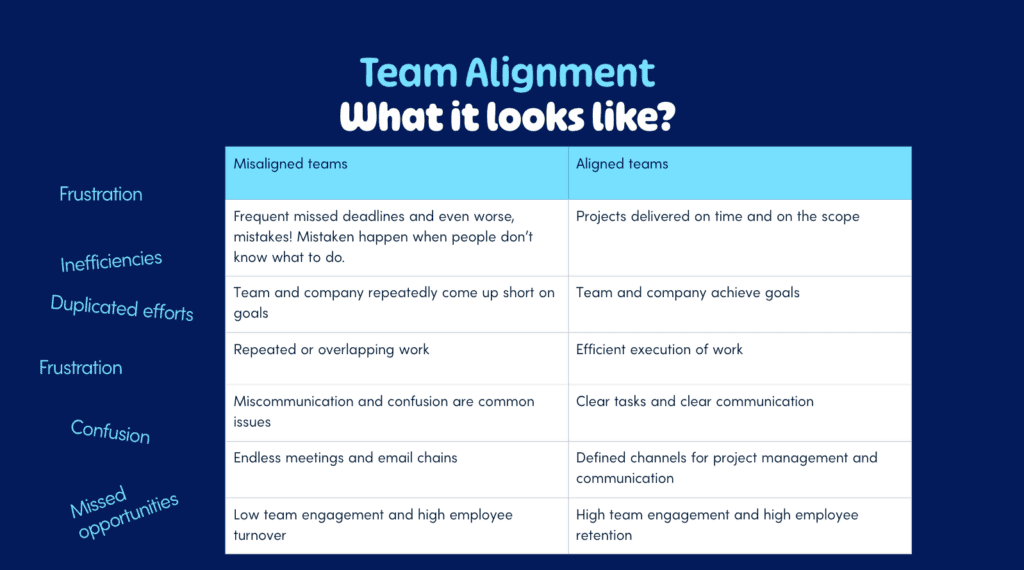
An aligned team is a group of individuals who work collaboratively toward a shared vision with clear goals, defined roles, and mutual accountability. Alignment will ensure that every team member understands the mission, vision, values, and objectives of the team and organization. They will have a greater appreciation for how individual contributions lead to the group’s success.
Aligned teams share several characteristics in common. They have shared vision and goals. This means that the team has a clear and unified understanding of its purpose. Members are committed to team objectives and will work hard to achieve common outcomes. There is effective communication. This will look like having open, transparent, and consistent communication channels. This will ensure psychological safety for team members so they can express ideas, feedback, and concerns. Defined roles and responsibilities are also an attribute of an aligned team. Each member knows their specific duties, what part they play, and how their work contributes to the team’s success. With this clarity, any overlaps and gaps in work, tasks, or responsibilities are minimized, which reduces confusion.
An aligned team will have high trust and respect for one another. Team members will trust each other’s abilities and intentions. There will be respect and desire for diverse perspectives and diverse skills to enhance a more positive environment. There will be an ease of collaboration and synergy. Team members lean on and leverage each other’s strengths to produce results greater than the sum of their individual efforts. We are better together; mindset and behaviors will be evident. Behaviors of helping, mentoring, and learning from one another will be consistent. When it comes to problem-solving, there will be high adaptability. The team remains agile and is quite willing to pivot strategies as needed to achieve goals. Challenges are approached collectively, with a strong focus on solutions and behaviors that avoid blaming others. This results in higher accountability. Team members hold themselves and each other responsible for meeting commitments. Results are tracked, and performance gaps are addressed in a constructive manner. There will be a sense of ongoing empowerment and autonomy for team members. They are empowered to make decisions within their roles. There is a balance between guidance from leadership and independence in execution. An aligned team functions efficiently, fostering both individual satisfaction and group success while driving toward shared achievements.
Misaligned teams
First, let’s be clear about how it looks and feels when a leadership team is not aligned. You may have had this experience in the past or could be experiencing it currently. It usually doesn’t feel very good, nor is it fun. It also creates great difficulty to get “in the zone” of workflow and may possibly impede health and a good nights sleep! Misalignment on teams often causes frustration, confusion, inefficiencies, missed opportunities, or waste of time and effort. I’m not sure how many people would like to stay in a regular cycle of those experiences. I believe most people want to experience the affects of team alignment but may not be sure how to create it or may think it’s another person’s responsibility to do so. Not so for the optimizing leader. The optimizing leader can quickly recognize misalignment and knows the “optimizing leadership moves” that will swiftly initiate alignment and increase the level of alignment to an optimized level.
A misaligned team is a group of individuals who are working toward different or conflicting goals. This often is a result of a lack of shared vision, communication, or understanding of priorities. This misalignment can show up in various ways, leading to inefficiencies, misunderstandings, and reduced team effectiveness. A misaligned team has conflicting objectives. There is us/them mindset and behaviors where team members or departments prioritize different goals, creating friction and inefficiency. Then poor communication is rampant. Information is siloed, not shared, and unclear or inaccurate. Key decisions or updates fail to get communicated clearly to everyone, which produces redundant and counterproductive efforts. Team members experience a significant lack of role clarity and are unsure about their responsibilities or how they contribute to the overall objective.
High tension and low morale are often strong indicators of misaligned teams. Commonly, team members experience frustration and resentment due to feeling unsupported or that their efforts are undermined by others. This often results in burnout, high turnover, and disengagement.
When there is inefficient decision-making, this results in decisions taking longer or being made inconsistently because there’s no shared framework or alignment. This can create disputes over priorities and can delay progress or create additional rework or unnecessary work. Often deadlines are missed, and there are poor outcomes. Misalignment often results in projects being delayed, over budget, or not meeting expectations. This lack of coordination creates missed opportunities and unnecessary challenges that aren’t addressed promptly.
Essentially, there is a significant lack of trust in misaligned teams. Motives are questioned. Team members competence or commitment may also be questioned due to unclear or inconsistent actions. Trust deteriorates when the team feels like it’s working against itself rather than cohesively.
If you find yourself on a misaligned team, there are several actions you can take to begin to rectify the situation. First clarify mission, vision, values, and goals. Be sure everyone understands and agrees on the team’s overarching objectives. Create environments that will encourage open communication where feedback and collaboration are practiced regularly. Write and define roles and responsibilities. Provide a clear outline of who is responsible for what and how success is measured. Practice regular team and one-on-one check-ins. Hold “alignment meetings” where you can reassess priorities, address roadblocks, and celebrate progress.
The role of leadership support is essential. So goes the leader, so goes the team. A realigned team can achieve synergy, where their collective efforts result in greater success than the sum of their individual contributions.
Measuring Alignment “Temperature”

Photo by Debby Hudson on Unsplash
Along with a survey, conducting alignment workshops can be a great way to gauge where your team alignment temperature or score may be. These alignment workshops can be conducted internally or using a third-party training or consulting group. The purpose of the workshop would be to simply observe interactions and gauge consensus during discussions. Sample activities can include the following: asking the team to define their mission, vision, and values; using prioritization exercises to identify shared goals; and discussing any disconnects or misalignments openly. Be sure to observe how well team members interact and communicate during these workshop conversations.
Another vital practice to gauge alignment temperature is consistent one-on-one check-ins. Leaders may think, “I talk with my team every day to see how they are doing and what they are working on. Do I need to do one-on-one check-ins as well?” Yes. One-on-one check-ins are different than daily communication about tasks or getting the job done. These check-ins often have a “step back and look at the bigger picture alignment” approach, and the optimizing leader will typically hold a coaching and learning stance. The purpose will be to explore individual alignment that may reveal unknown misalignments. Key topics to explore are their understanding of team goals and their role in achieving them; perceptions of the team’s effectiveness and direction; and asking for any suggestions for improving alignment.
Additional ways to gauge alignment would be to measure KPIs (Key Performance Indicators).
Use KPI data to determine if the team is effectively working together toward shared goals. What are their goal completion rates? Consider collaboration metrics such as task dependencies and frequency of communication. Customer satisfaction scores can be another KPI that sheds light on team alignment. Be sure to analyze team results to see if efforts are producing the desired outcomes. Using alignment diagnostic tools can also be helpful. Team alignment surveys, such as using OKR-specific tools like Perdoo or 7Geese, are great resources. Use of collaboration and feedback platforms like Slack analytics or Trello activity logs will also work well.
Fostering an environment of feedback and open communication is essential to accurately gauge team alignment. Having regular feedback loops such as retrospectives and team reviews is one way to do this. Also, encourage open conversations about any misalignments. Try using anonymous feedback forms to surface issues without fear of reprisal. Always be observing team dynamics. You can do this by evaluating behaviors in meetings and collaboration sessions. Is there an equal contribution from all team members? Do team conversations reflect a shared understanding? Where do you see signs of confusion or disagreement? Is there an opportunity for greater clarity? Mapping team objectives can be one way to increase clarity. Using a visual framework such as strategy maps or OKR diagrams can align individual roles with team and organizational goals. Periodically check if team members can articulate the mapping framework.
Taking time to create and use alignment scores will also help you evaluate and measure your team’s alignment. You can do this by calculating an “alignment score” using several resources. Combine survey responses, KPI achievements, and observational data. Use a simple scoring system on a scale of 1 to 10 (1 being low alignment and 10 being high alignment). This can help track team alignment over time. You can also conduct a retrospective analysis. This can be done after completing a project or when hitting a significant milestone. Simply review what went well and what didn’t. Have a conversation about whether goals were met and how effectively the team worked together. Identify and document gaps in understanding or execution.
When you are consistently measuring team alignment through these methods, you will identify and address gaps. This will lead to improved collaboration and performance and greater team alignment.
Rally the team

Photo by Smartworks Coworking on Unsplash
When mistakes happen or deadlines are missed, the optimizing leader recognizes this as a sign or opportunity for increasing alignment. Rather than shame, guilt, or punishment, the optimizing leader will rally the team around the MVV and analyze how the team behaviors are aligned or misaligned with the MVV. Then they will open a conversation about what is needed to be successful in fulfilling their MVV and what might be getting in the way. This critical thinking inclusive conversation allows for full team engagement and positive actions to provide solutions.
If goals are missed or their is confusion about how to measure and achieve goals, the optimizing leader will incorporate key words or phrases from their MVV that inspire clear action, and it creates the desire to accomplish goals together as a team. There is a spirit of celebration rather than criticism that results. This becomes positively contagious and begets further goal-setting, accomplishment, and celebration. It creates a winning culture.
Critical thinking conversations

Photo by Annie Spratt on Unsplash
What is a critical thinking conversation, and how do you facilitate one?
A critical thinking conversation is where there will be evaluation of data sources, facts, and other research to make a reasonable conclusion by “connecting the dots.” Critical thinking in the workplace means sorting among useful and arbitrary details to come up with a big-picture perspective that leads to an impactful decision or solution to a problem. It will take into consideration many data points and seek to align data with objectives and goals. It will be a place to ask, “Anything else?” or “Is there something we’re not seeing here?”
Having a “critical thinking conversation” while providing an opportunity for team members to actively analyze information, question assumptions, consider different perspectives, and evaluate evidence to reach a well-informed conclusion on a topic or problem. This is different than simply accepting information at face value. It will involve actively engaging with ideas, asking probing questions, and seeking out diverse viewpoints to make sound decisions. This also can be referred to as shared intelligence.
This type of team conversation will have a variety of elements or ground rules. Assumptions will be questioned Questioning assumptions is a very important part of a critical thinking conversation. Challenging underlying beliefs and asking “why” to understand the rationale behind ideas will increase clarity and alignment. Any data or evidence available will be evaluated. This will be done by assessing the credibility and reliability of information sources. Different and varying perspectives will be desired and sought. Exploring various viewpoints on an issue is a way to gain a comprehensive understanding. There will be a high priority placed on logical reasoning. Applying logic and reasoning to analyze information and draw valid conclusions. Many good and open-ended questions will be asked. Asking the kind of good questions that encourage detailed explanations and deeper analysis rather than simple yes/no answers.
This type of critical thinking conversation can be useful in many scenarios: when brainstorming solutions to a problem; reviewing a new project proposal; analyzing the budget proposal; considering a proposed change; discussing potential impacts on different stakeholders; and when suggesting modifications based on critical analysis.
Contagious celebration

Photo by Jeffrey F Lin on Unsplash
Optimizing leaders realize that alignment celebration is contagious and increase momentum towards further alignment. Celebration is an important experience for teamwork and optimized teams that are producing high results.
Celebrating achievements provides enormous value because it boosts employee morale, increases job satisfaction, fosters a sense of community, and motivates individuals to perform at their very best. This is done by showing that their hard work is recognized and appreciated. This ultimately leads to improved productivity and increased retention rates within the company.
Let’s consider a few important benefits of the team alignment celebration. It produces a positive company culture and a positive work environment. Team cohesion will increase, and team bonds will deepen. Employee engagement and commitment will rise. Stress will be reduced and burnout will be rare. Top talent will be attracted due to the contagious and positive nature of a celebrative team culture. “Players will want to play for you.” Creativity and innovation will be endless. Celebrating successes can encourage employees to take risks and think outside the box, leading to new ideas and improvements. These and many other positive outcomes are key results of celebrating alignment.

Case Study: Rapidly growing tech startup reduces communication gaps to boost performance.
“InnoTech” was a rapidly growing tech startup. Their newly expanded marketing team experienced significant communication gaps and conflicting priorities. This led to decreased productivity and missed deadlines. To address this, the leadership team implemented a strategic alignment initiative involving facilitated workshops, clear goal setting, and open communication channels. By taking these actions, the results were improved collaboration, increased team cohesion, and a more streamlined approach to project execution. With this positive momentum, it ultimately boosted the company’s marketing performance.
Photo by Desola Lanre-Ologun on Unsplash
Their initial problem was that the marketing team at InnoTech was experiencing a lack of alignment. This was due to rapid growth, leading to confusion about roles, responsibilities, and key priorities, causing inefficiencies and missed targets. The symptoms of their misalignment problem showed up as: frequent arguements and disagreements during team meetings; duplication of efforts across team members; a significant difficulty in decision-making resulting in delays and confusion; an acute lack of clarity on overall marketing strategy; and very poor communication between marketing sub-teams.

Photo by Desola Lanre-Ologun on Unsplash
The leadership took alignment action by facilitating a company-wide retreat to discuss the company vision, mission, and strategic goals. This allowed all team members to understand the bigger picture and how their roles contribute. Then they focused on clear goal setting and OKR development. Next, they opened communication channels by implementing regular team check-ins, one-on-ones, transparent reporting, and utilizing project management tools (like Asana) to foster open communication and collaboration. They placed a higher priority on written role clarification. By defining roles and responsibilities within the team, they addressed potential overlaps and clarified accountability. They invested time and resources in training and team-building activities.
The results? An aligned team: improved team cohesion; enhanced productivity; clear decision-making; improved communication and shared understanding; increased employee engagement; and higher employee satisfaction.

Exercise
1. What is the importance of leadership commitment when it comes to team alignment?
2. What role does continuous improvement play in maintaining alignment?
3. How do aligned teams adapt to change?

Course Manual 7: Alignment Pitfalls
Alignment pitfalls: identifying common mistakes, pitfalls, and derailers for MVV alignment and how to avoid them or overcome them. When optimizing leaders are seeking to increase and maintain leadership team alignment, it will be critical for them to identify common mistakes, pitfalls, and derailers for MVV alignment and how to avoid them or overcome them. In this chapter, we will explore some of the most common alignment pitfalls, how to identify them, how to avoid them, and what to do if you find you or your team stuck in one or more of them.

Photo by Dominic Kurniawan Suryaputra on Unsplash
Assumption
One of the most common pitfalls is a simple one and frankly easy to overlook. Assumption and unconscious bias can create significant limitations or pitfall impacts to leadership team alignment. What is an assumption, and how does it create this pitfall impact? Assumptions are simply unchallenged or unclarified thoughts or beliefs. A common definition of an assumption is “a thing that is accepted as true or as certain to happen, without proof.” Without the “proof” or clarification of understanding, the thought or idea simply stays unchallenged or unclear. The results of assumptions can lead to frustration, moving in the wrong direction, or misalignment. One simple way to identify assumptions is to simply ask, “What assumptions might we be making here?” “What proof or challenge can be provided to clarify the thought, idea, or action?” These simple questions can serve as guardrails to keep your team out of the assumption pitfall. These same questions can be used to increase clarity or alignment if you sense you may be in an assumption pitfall.
You may be familiar with the phrase “making assumptions makes an a** out of you and me.” While that certainly may be true, there are several other adverse impacts that result from assumption-making. Let’s explore a few. Miscommunication or a breakdown in communication. When one assumes someone else understands their perspective or intentions, this can lead to misunderstandings and misalignment. This also can produce incomplete information sharing. Assuming that others have all the information can result in important details being missed.
Poor decision-making and inaccurate conclusions can also be an averse impact of assumptions. Decisions based on incorrect assumptions will lack sound reasoning.
Assuming has left the door wide open for conflict and relationship strain. When people assume motives or intentions, this can lead to unfair accusations and mistrust. This will place unnecessary tension on the working relationship. Acting on assumptions can adversely impact relationships if they turn out to be incorrect. When assumptions are high, so is the risk of missed opportunities. This will be because there are limited perspectives. Assumptions can blind you to new ideas, alternatives, or opportunities.
There is also a tendency for stereotyping and unconscious bias. Assumptions about individuals or groups can lead to discrimination. This will result in a lack of inclusivity and reduce the sense of belonging for everyone involved. When there are assumptions, there is an erosion of trust. Without trust, there is no team. There will be a strongly negative emotional impact and often inefficiencies that result in wasted resources. Time and effort mismanagement will create unnecessary reworks that are costly and time-consuming.
If you find yourself in a work culture setting where assumptions seem high, you can try these actions to mitigate adverse affects. Ask clarifying questions rather than assuming. Base decisions and judgments on facts and evidence, not assumptions. Stay open-minded so you can consider alternative viewpoints and possibilities. Work to communicate clearly and effectively. Be sure to share information and verify understanding. Practice regular reflection, both individually and as a group. Be honest when you notice that assumptions have led you astray and learn from the experience for future improvements. Addressing assumptions reflectively can help avoid these pitfalls. It will result in better relationships, decisions, and outcomes.
Guardrail questions

Photo by Bournes senruoB on Unsplash
First, consider your MVV. How closely does this action or decision align with our MVV? Make the case as if someone was not aware of your MVV at all. Next, take a look at goal and task alignment. Is this action or decision consistent with our stated goals or objectives, or is clarification needed? Are we sharing information that is relevant, accurate, and actionable?
What is our level of transparency and clarity? Is there an opportunity to increase clarity? Can we explain the reasoning behind this action or decision clearly to someone it impacts? Do we see ambiguity in the action that might lead to misinterpretation or confusion? Should we disclose any limitations in knowledge or the reasoning process? Is there more information needed?
Consider bias levels and fairness factors. Does our action or behavior perpetuate any stereotypes or biases? Have we sought out multiple perspectives when presenting this information? Could this action or decision disproportionately affect certain groups? If so, what adjustments can we make? Also think through ethical and safety alignment. Are our actions or outcomes creating a potential to cause harm (physical, emotional, social) to others? Do our actions and decisions adhere to ethical guidelines and laws? Is there potential that this information could be misused to harm individuals or communities?
Be sure to gauge your level of perceived trustworthiness and accuracy. You can do this by looking first at your level of confidence in the accuracy of this decision or action. Is the decision based on credible sources or evidence? Will it be wise or necessary to include a disclaimer about any uncertainty or potential errors? Also consider your commitment to adaptability and feedback. Have we created ample opportunity for feedback to improve alignment?
Do we see room for others to clarify or refine? Have we appropriately handled any conflicting or ambiguous information to increase clarity and confidence? By including such questions into your thought process and MVV alignment processing system, you will reduce the risks of misalignment.
Cynical Criticism

Photo by Adi Goldstein on Unsplash
Another alignment pitfall can be cynical criticism. This is very different than a critical thinking open conversation. In fact, inviting team members to engage in a critical thinking open conversation is one way to avoid or work beyond the cynical criticism pitfall. So what is cynical criticism, and how does it create a pitfall impact? Cynical criticism comes from someone who believes people are only motivated by self-interest and that they only do things that benefit themselves. The term “cynic” comes from the ancient Greek Cynics. The Cynics rejected conventional goals of wealth, power, and honor. They believed that virtue was the only good and that self-control and independence were its essence. This creates a mindset or behavior of being deeply distrustful. To be cynical implies that one has a strong disbelief in sincerity or integrity. To move beyond this pitfall, optimizing leaders will challenge that disbelief by engaging in critical thinking conversations and not allow one or two individuals to sour the team’s alignment.
“Of course, you messed it up again. Why am I not surprised? What’s wrong with you?” This is clearly a poor way of communicating and gives a clear picture of cynical criticism and why it is ineffective. Cynical criticism and constructive criticism differ in their intent, tone, and impact.
Cynical criticism will often have a negative or dismissive intent. It will lack belief in improvement or in goodwill. It often comes from a place of superiority or bitterness.
There will be a harsh tone, often sounding sarcastic or mocking. It creates the feeling of being demoralized, uncared for, and unhelpful. Cynical criticism will focus on pointing out flaws, often without offering solutions or encouragement. The adverse impact of cynical criticism creates a feeling of discouragement, alienation, or harm to the recipient. It will not lead to lasting positive change and will damage relationships.
“This part of the presentation could be clearer. Would you consider adding a visual example? This might get the point across better and more powerfully.” This example of delivering constructive criticism is designed to help improve or guide. There is positive intention and a strong belief in the potential for growth. The tone will be respectful, empathetic, and solution-oriented. When people feel this, they will experience strong motivation to improve and will want to work harder and stronger for the good of the team and company. Constructive criticism will kindly address specific issues (often only one at a time) with suggestions for improvement. It will balance criticism by acknowledging strengths and other positive outcomes.
When people receive constructive criticism, it results in encouragement, improvement, trust, learning, and collaboration.
Cynical criticism tears down people and teams. It erodes trust, and no one wins. Constructive criticism builds people and teams up. Results, relationships, and processes improve. Constructive criticism is actionable and rooted in a deep desire to help others, and the team improves. Cynical criticism often only serves the deliverer to vent frustration or undermine confidence in others and produce low trust and poor results. Optimizing leaders choose constructive criticism every time and practice repair attempts when there is cynical criticism.
Inattention to details

Photo by Julian Hochgesang on Unsplash
Inattention to details can have significant impacts across various contexts. It will cause you to miss the mark, or miss the “bullseye.” This impact can have an adverse effect on your personal life, workplace settings, and larger-scale projects. The consequences can range from minor inconveniences to serious repercussions. When there are significant errors in work output, such as missed deadlines, financial loss, or reputation damage. This is missing the bullseye. When there is an interpersonal or team relationship negative impact, this also misses the mark. If health or safety is at risk, people are limited in their ability to align with MVV. Again, a miss. Project failures, legal or compliance issues, and customer dissatisfaction can all be signs that MVV alignment is not at its best. When there is increased stress, low confidence, or high frustration. Perhaps this is a time to realign on your MVV.
There are several proactive steps you can take when you sense you and your team may be missing the MVV alignment bullseye. Develop simple systems to remind you and your team to stay focused and organized with your MVV. Practice mindfulness by focusing on one task at a time rather than multitasking. Review your work as it pertains to your objectives and your MVV. Prioritize training to increase skills and attention through practice and forming strong habits and behaviors. Fostering a detail-oriented mindset can significantly improve MVV outcomes and strengthen relationships in both personal and professional contexts.
Derailers

Photo by Ben on Unsplash
Team alignment can be disrupted by many factors. Is there a lack of clear goals and vision? Derailer. If team members don’t have a shared understanding of goals or how their work contributes to the broader vision, this will derail your success. Do priorities often shift? Derailer. When there are constant changes to goals or expectations without proper communication, this creates derailment. Where poor communication exists, so exist derailing from your MVV. When there are siloes or feedback gaps. This creates derailment from MVV due to misinformation, misunderstanding, and ineffective feedback, producing poor results.
Would you say there is role ambiguity? This too is a derailer. If responsibilities are not clearly defined or there are overlapping roles, this creates enormous confusion, resulting in duplicate efforts and missing critical tasks. With a lack of trust or unhealthy conflict, team members will feel unable to speak up or contribute ideas without the fear of judgment or reprisal. A lot of good ideas will be missed, resulting in low innovation. This is a derailer.
When there is ineffective leadership or inconsistent messaging from leadership, this also has a derailer impact. When leaders micromanage by overly controlling decision processes, this will stifle team autonomy and creativity. If there is favoritism or a failure to address issues fairly, this also derails alignment. A lack of clear direction from leadership is another alignment derailer.
If there are unnecessary constraints on resources and a lack of tools or support, this too can create alignment derailing. Especially when there are time pressures, team members can feel they are in an impossible situation, doomed to fail. When there is an overemphasis on individual success rather than team wins, this too creates an alignment derailment. If motivation is down and team members are disengaged, watch the MVV alignment continue to plummet. Proactively addressing these derailers requires communication, strong leadership, a clear vision, and a commitment to fostering trust and collaboration within the team.
Lack of regular reconnection with MVV

Photo by Peperon cino on Unsplash
A lack of regular connection with your team’s mission can have many negative effects. It will result in decreased motivation and engagement. Remember, your MVV has the power to inspire movement, action, cohesion, and results. Why would you not want to regularly engage with something so powerful? Without regular connection with your MVV, you run the risk of reduced alignment. Individual or team goals may drift off course from the team’s core objectives. This can create wasted time and effort on actions that don’t contribute to the mission. You will begin to see lower productivity. Or if you are already seeing this, perhaps its time to reevaluate the regularity of your connection with your MVV. Teams with unclear direction struggle to prioritize effectively, and this results in inefficiency. It creates an unclear picture of what success looks like.
Without regular connection with your MVV, you will begin to notice that your team is lacking strong cohesion. Something will feel “off.” The team will experience fragmentation, siloes, or “us vs. them” behaviors. Shared values and a collective purpose are key to increasing healthy and effective collaboration. Decisions will begin to be more difficult. There will be competing interests. With MVV missing in your regular connection, practice decisions can become inconsistent or arbitrary without a clear mission to guide them. They will be “one-off” decisions rather than building toward a bigger picture. Teams will focus on short-term gains rather than long-term strategic outcomes.
Experiencing intense burnout or high turnover? Check your MVV pulse and vitals. Team members who don’t have clarity on the importance of their contributions are more likely to experience burnout. Disconnection from the MVV leads to dissatisfaction. This results in high staff turnover. Missing key opportunities? Teams that are not aligned with their MVV will fail to seize opportunities that align with their goals and values.
Address this lack of regular connection with your MVV by taking the following action steps. Prioritize frequent communication. Remind the team of the MVV in meetings and updates.
Share success stories of your MVV in action and how the team’s work aligns with the mission.
Embed the MVV into everyday activities, decisions, and rewards. Model MVV behaviors to inspire others. Maintaining a strong connection to your MVV ensures everyone is working toward a shared purpose. This produces high employee engagement, productivity, and success.

Case Study: Cross-Functional Project at Tech Company
NovaTech, a leading technology company, launched a vital cross-functional project. The purpose of this project was to develop a new cloud-based software platform, bringing together teams from engineering, design, marketing, and sales. Unfortunately, the project quickly encountered significant roadblocks. There were missed deadlines, poor communication, and a lack of clarity on roles and responsibilities. It was clear that there was a major misalignment issue.
Photo by Marvin Meyer on Unsplash
There were conflicting priorities. Naturally, the engineering team focused heavily on technical features. The marketing team prioritized user experience. This led to disagreements during design discussions and feature prioritization. A pattern of poor communication led to a lack of regular updates between departments. This resulted in critical information being missed, causing delays and rework. Roles and responsibilities were unclear. Team members were unsure of who was accountable for specific tasks. This created a duplication of effort and gaps in project execution. There was not a shared vision. The overall project goal was defined; however, there was a lack of alignment on the desired outcomes and key performance indicators. This created significant confusion and misdirected efforts. Also, an “us vs. them” mentality emerged between teams. This created pitfalls for collaboration and roadblocks for problem-solving. Costs began to rise. Morale plummeted. The product launch was in jeopardy.

Photo by Marvin Meyer on Unsplash
The leadership intervened. They asigned a strong, experienced project manager with strong cross-functional leadership skills to facilitate communication and resolve conflicts. They established a clear communication plan with regular team meetings. The role definition was written clearly along with a responsibility matrix. This increases cross-functional collaboration. The goals and vision were shared, outlining key objectives, success metrics, and desired outcomes for all teams. Performance was monitored, and the project plan was adjusted based on feedback and data analysis.
The outcome? By addressing the underlying issues of misalignment, NovaTech successfully turned around the project, achieved a timely launch, and improved team collaboration. This alignment experience highlighted the importance of proactive leadership, clear communication, and integration to prevent future misalignment problems.

Exercise (in pairs)
● Discuss the case study.
● Identify 3 actions the leadership team could take to address the issue.
● Write 3 outcomes you would expect resulting from the leadership alignment actions.

Course Manual 8: Realignment
At times, organizations, teams, or individuals may get “off course” or need a refresh. MVV realignment is crucial in these moments. Identifying realignment actions and outcomes will be an important initial step.
This simple graph illustrates realignment process steps that can be utilized as a guide for realignment. Starting with a strategic pause and rotating counterclockwise, you will move through the crucial steps of a realignment process.

Strategic Pause

Photo by Tachina Lee on Unsplash
Intention
Intention, simply put, is what you want. What outcomes do you desire? What change in action or behavior do you want to see take place? Intention also has to do with an aim, direction, or plan. In the medical field, intention is the healing process of a wound. One could say that the “wound” is misalignment that is causing the “infection” of frustration, demotivation, derailment, etc. The healing process is the realignment process. So what can be done to initiate a simple realignment process?
Mission Moments

Photo by Alex Alvarez on Unsplash
What is a mission moment? These are meaningful moments that happen throughout the day or week. They are serendipitous and often unplanned. They are special and have a quality of energy that feels unique. If an optimizing leader has a “mission moment mindset,” they will recognize them with ease and capitalize on the mission moment naturally. It won’t feel forced or manipulated. So what does a mission moment look like? How do you know if one is happening? A simple practice to identify mission moments is to memorize the key words of your mission statement. For example, if part of your mission statement states “customer satisfaction,” you could celebrate a mission moment any time someone experiences the emotion of satisfaction. You also could congratulate team members any time they interact with a customer because you are confident the customer had a wonderful experience with them, and certainly that will increase their sense of satisfaction. Challenge yourself today to find 10 mission moments and be intentional to “call them out” as a mission moment. It literally only takes a moment or two, and with a little bit of mindfulness and intention, you’re sure to have celebration mission moments daily in now time.
Mission Check-ins
There are several activities that can be implemented to create realignment. One habit or action can be to have a simple 15-minute conversation with your team about your MVV. This could be a stand-alone or stand-up meeting, or it could be at the beginning or end of another meeting. If you want it to stand out and feel significant, then I recommend having it as a stand-alone “stand-up” meeting. The optimizing leader can call the meeting with a simple agenda of a 15-minute conversation about the teams MVV. Start by saying that during your strategic pause this week you have noticed an opportunity and need to realign with the MVV. Clarify that the purpose of this meeting is not to solve problems or create action plans. It is simply to reconnect with and realign with your MVV. Then ask if others have sensed a need or opportunity for this. If yes, ask about what. If no, simply pick one of the statements (mission, vision, or values) to look at together, read all or a portion out loud, and then ask, What are some specific examples of how you saw this in action this week? Conclude the meeting on time. If there is a clear need for further conversation, let the team know you will be scheduling a deeper dive conversation about ____ (where you see the most need for more conversation). Identify that the purpose of this meeting will be a MVV critical thinking open conversation. Invite all to attend. Clarify if this meeting will be opt-in or mandatory.
An additional aspect of mission check-ins is to include it regularly in your 1:1’s. Perhaps once per month you could open the conversation by asking, “What aspect of our mission statement are you feeling the most energized by right now in your work?” Then simply listen. Let them tell you some stories. Follow up only by asking clarifying questions that are supportive of them being successful in their role. If they reply, “I don’t know” or “I’m not feeling energized by our mission right now” or “It feels unclear to me,” this is a great coaching moment to offer support, listen for what might be hindering energy or success, and perhaps offer an example of how you see their effort and skill aligning with the mission statement. With positive support, team members will begin to notice this more often on their own and will help other team members experience the value of MVV alignment as well.
Mission Meetings
It will be essential for MVV alignment or realignment to facilitate MVV alignment meetings. I recommend twice a year at a minimum. To clarify, this is not the only time you discuss your MVV. There will be daily opportunities with mission moments and weekly opportunities with 15-minute MVV check-ins. The MVV meeting typically will last 30-90 minutes and have an action or behavior alignment focus. The following agenda provides a sample outline of how to conduct an MVV meeting. Communicate this is a mandatory meeting and thank people for making it a top priority. Explain why it is mandatory and a priority. Be sure to walk away with specific action items and clarity about who is responsible to execute those actions and when it is expected to report results.

Agenda
1. Welcome and Opening (5 minutes)
● Facilitator introduction
● Purpose of the meeting
● Review of the agenda
2. Icebreaker Activity: Shared Values (10 minutes)
● Each participant shares one value they believe represents the organization.
● Brief discussion on how it connects to the team’s goals.
3. Review of Existing Mission, Vision, and Values (15 minutes)
● Presentation of current statements (if applicable).
● Facilitator-led discussion:
○ What resonates with the team?
○ What feels outdated or misaligned?
4. Brainstorming Session (20 minutes)
● Mission: What is our core purpose? Why do we exist?
● Vision: What is our aspirational goal? What do we want to achieve?
● Values: What principles guide our actions and decision-making?
Tools: whiteboard, sticky notes, or virtual collaboration tools (e.g., Miro, Jamboard).
5. Prioritization and Refinement (10 minutes)
● Identify recurring themes from brainstorming.
● Draft preliminary updates to the mission, vision, and values.
● Group discussion to refine language and ensure alignment.
6. Implementation Discussion (15 minutes)
● How can we integrate this into our daily work? Name one example.
● Assigning responsibilities for communication and training.
7. Next Steps and Action Items (10 minutes)
● Recap of agreed updates.
● Assign follow-up tasks (e.g., creating a final draft, presenting to leadership).
● Set date for the next review or check-in meeting.
8. Wrap up (5 minutes)
● Facilitator summary of key points.
● Participants share 1 feeling word they experienced during the meeting (use The Feelings Wheel)
● Adjournment.
Critical Thinking Conversation
When you have an MVV critical thinking open conversation, there will be a need to identify the purpose/outcome of the meeting and establish some ground rules. Typically, this meeting is not intended to “rewrite” a document (that can have a different process at a different time if necessary). An opening question can be, “If you could change 1 thing about the MVV, what would it be?” Facilitate a flowing conversation with all participants practicing active listening and write down key words, thoughts, or phrases. Limiting this meeting to one hour will be best, unless this is part of a team retreat. A second question could be, “What word or phrase in the MVV do you feel most energized by? Most confused by?” These questions can also initiate a lively conversation for sure, which will increase enthusiasm from the team for the MVV and increase realignment as well.
Clarifying Outcomes

Photo by No Revisions on Unsplash
What are the outcomes you are seeking by initiating an MVV realignment process? Are they written down and clearly defined? Did you seek collaboration and input from other team members to determine your desired outcomes? What measurement process will you use to see if the results you are seeking will be produced? You may identify an outcome as, “We need to be on the same page.” Great! How will you know when that is accomplished? Define “the page” and what measurements you will use to gauge how many people are on the page. How do they get on the page? What this means to one may have an entirely different meaning to another. This is why specificity and clarity are essential when defining outcomes. It is better to have two or three outcomes that are very specific and very clear than ten or fifteen that are vague and difficult to measure. They may sound good, but they do not create a clear picture of realignment. Do the 30-day test. In 30 days, we will see this different behavior. Be very specific. Mark it on your outcomes calendar and test your result. Did it produce the desired outcome or change? Any adjustments that need to be made? Do you need to re-up your commitment to that outcome for the next 30-day period to ensure you achieve the result you are seeking?
If you could change one thing about your MVV, what would it be?
The value and intent of this question is to unleash innovation and creativity. It also provides insight into which parts of your MVV are your team members engaging with and which parts may need additional clarity of meaning. The purpose of this question is not to rewrite your MVV, but simply to engage thoughtful thinking and really listen well to one another. I recommend a practice of asking this question two times annually and engaging in meaningful conversation.

Case study: Solar Tech Company Realigns Mission and Vision to Respond to Market Needs.
“GreenTech Solutions” (a solar panel manufacturer) went through a mission and vision realignment process. Their business model focused solely on residential installations, but they decided to expand into the commercial market as well. This created a necessary shift in their mission and vision to reflect this new direction. It required an increase of internal communication, employee training, and strategic partnerships to align their operations with the updated goals.
GreenTech Solutions’ mission and vision were focused on providing clean energy solutions for homeowners. This did not include an expansion into large-scale commercial projects. They saw the potential confusion this could create among stakeholders and how it may have hindered their ability to effectively target new markets.
They initiated a realignment process. They performed an internal analysis utilizing employee surveys, market research, and stakeholder interviews. This helps them to better understand the current perception of the company’s mission and vision. They were able to identify gaps between stated goals and actual practices. With this insight and information, they crafted a new vision statement that emphasized GreenTech’s ambition to become a leading provider of sustainable energy solutions for both residential and commercial clients. They had an increase in focus on scalability and impact. They also refined their mission statement to highlight a commitment to innovation and responsible energy practices across all market segments. They also formed a communication strategy about the mission and vision realignment and refinement.
Although they faced initial implementation challenges, such as resistance to change, operational adjustments, and market misperceptions, they were able to achieve positive outcomes. Their market reach and revenue increased. Their employee engagement increased, and their brand reputation was enhanced. Leadership played a critical role in the realignment process to produce successful outcomes. They strengthened their ability to communicate the revised vision effectively and championed change throughout the organization. They were more involved with key stakeholders, thus strengthening those strategic relationships. They also developed more clear metrics for success.

Exercise: If you could change one thing about your MVV
● Which of these steps in the MVV realignment process do you feel you need to do right now?
● What is one action you can take today or tomorrow to initiate or complete this step?
● What do you hope to produce by taking this action step?

Course Manual 9: Gaining Traction
In this section, we will be exploring learning the optimizing leadership skills, leadership moves, and actions to take in order to gain traction once you have created MVV alignment. So what is traction? It is the action of drawing or pulling something or the grip of something on another surface. In this case, the surface is alignment culture. Once you gain momentum, it will be critical to keep clearly identifying and acting on alignment behaviors. Often these behaviors will be displayed by alignment champions on your team. An alignment champion is simply a team member who “gets it” and sees how the alignment and cohesion are working and producing the desired results. These individuals will quickly create momentum to keep and protect the alignment that has already been created. This positive movement forward will spread to others as well.

Photo by Wesley Tingey on Unsplash
What is traction in the leadership alignment process, and why does it matter?
In change management, “traction” refers to the progress, momentum, or acceptance of a change initiative within an organization. It shows that the change effort is taking hold and is starting to yield visible or measurable results. Traction indicates that key stakeholders are engaging with the change, processes are being adopted, and the organization is moving closer to achieving its desired outcomes.
Traction matters in leadership alignment during change management because it shows that the change initiative is not just a theoretical concept but that it is being implemented effectively in workflow and practice. When key stakeholders see early wins or signs of progress, they are more likely to buy into the change effort, which will reduce resistance. This visible success energizes employees and teams. It will encourage them to maintain or increase their effort toward implementing the change. This will strengthen your leadership alignment. When monitoring traction, leaders can identify areas where the initiative may be hitting roadblocks and can prioritize corrective actions before larger issues or concerns arise.
Traction demonstrates value. When there is clear evidence of traction, the progress will validate the change effort’s value to key stakeholders, such as senior leaders, employees, and customers. This will result in sustained momentum. At first, the effort may be arduous; however, with traction, the effort will begin to ease. Gaining and maintaining traction is essential to ensuring that a change effort doesn’t lose steam or become deprioritized.
How to Gain Traction in Leadership Alignment
First, be sure to set clear goals. Do this by defining specific, measurable, and achievable milestones for the change. These should be written down, understood by the team, with an opportunity to express commitment to achieving the clear goals. This increases buy-in and guarantees better results, improved communication, and stronger alignment. When seeking to gain momentum, it will be essential to communicate effectively. Be sure stakeholders understand the purpose and benefits of the change. Utilize feedback loops so you or they are not caught off guard by any significant misunderstanding. Actively involving employees and leaders in the alignment process will increase commitment and accountability. Highlight early wins and successes. The reason for this is to build trust and enthusiasm. Consider what support will be needed to maintain ongoing success. Offer training, resources, and tools to enable stakeholders to adopt the change. Continuously monitor the alignment and traction progress and adjust to address any challenges. When you actively prioritize traction in change management, you will ensure smoother transitions, better adoption rates, and greater overall success in achieving your objectives.
Alignment Champions

Photo by Christina @ wocintechchat.com on Unsplash
When you are building alignment and seeking to gain traction, you will want to identify and recruit several “alignment champions.” You won’t need many. Three or four will do initially. An alignment champion is a leader on your team (or perhaps another part of the organization) who advocates for, supports, and drives the alignment forward. These champions will serve as connectors between leadership and employees. Their role is helping to ease transition pain points by communicating the benefits of the change, addressing concerns, and fostering a culture of adaptability. They often play a critical role in ensuring that the alignment outcomes are understood, accepted, and implemented effectively.
So, how does one go about identifying an alignment champion? First, consider people on your team or in your organization that have influence and credibility. Others listen to them and often respect what they have to say. They are respected by their peers and others in leadership. It will be important that they have informal influence within the organization and not just title or positional authority. Others look to them as a role model for organizational values. They will have strong communication skills. With ease, they effectively convey messages to diverse audiences. They have effective actively listening habits and address concerns with empathy.
An alignment champion is someone who is very proactive and displays adaptability (often with lightheartedness). They display a willingness to embrace and lead change and are comfortable with ambiguity. They will have strong problem-solving skills and work well with others in engagement and with enthusiasm. They will have a collaborative spirit and also have a strong knowledge of the organization.
To identify an alignment champion, consider the characteristics above and take these steps. Look for employees who naturally take initiative and inspire colleagues. Allow teams to suggest individuals they feel can lead and advocate for the change. Identify individuals who consistently demonstrate a positive attitude, problem-solving skills, and reliability. Gather input from managers and peers about who they trust and respect in times of change. Test potential champions by involving them in early stages of the change process to evaluate their effectiveness and commitment.
Once you have identified an alignment champion, be sure to communicate this with them. Ask them if they would consider serving in this champion role for a defined period of time. Be very clear to delegate roles and responsibilities of what you expect from them as an alignment champion. You will want them to advocate for change by promoting the change initiative and explaining its benefits to team members. You want them to be clear communicators. They will need to provide clear, consistent updates on the progress of the change. They will need to seek feedback by listening to an act as a conduit between employees and management. They will need to problem solve by helping to address challenges or any resistance to change. Ask them to be a role model and embody the behaviors and mindset the organization seeks to instill. They will also ensure team members have the resources needed to successfully adopt and adapt to the change. By thoughtfully selecting and empowering leadership alignment champions, teams, and organizations, we can significantly increase the successful implementation of change initiatives.
The value of traction in creating culture
This gives insight into the value of traction in creating culture. In organizations, team culture is the shared values, beliefs, and behaviors that define a group of people working together toward a common goal. It’s often influenced by the team’s history, leadership, and members. Team culture greatly impacts how the team works together, communicates, and approaches challenges. When their is a strong team culture, it can increase trust, creativity, and resilience. There are often higher levels of employee engagement, motivation, and commitment. This also can produce greater customer satisfaction and retention. On the other hand, when there is a weak or toxic team culture, it can create unnecessary conflict and high levels of turnover. Team members often experience apathy. A weak culture can create a work environment where employees feel undervalued, overly stressed, and have very low motivation. How would you define the current state of your team culture? How do you know? What actions can you take to strengthen your team culture and increase team alignment?
The value of traction in creating critical mass
Another traction factor to consider when working on your team alignment is creating what is called critical mass. One aspect of critical mass is defined as a point at which the rate of change of alignment or the gradient of the alignment curve changes upward in volume and direction, which leads to an exponential increase in the adoption of a change or greater alignment by team members.
This rudimentary chart visually illustrates the basic principles of critical mass. The X-axis (horizontal) represents time or effort/input. The Y-axis (vertical) represents the percentage of adoption, reaction/impact, or output (e.g., number of people involved in a movement, energy released, etc.). The left portion of the curve (subcritical) is slow growth, a flat line with minimal change, representing little reaction or influence. The middle portion (critical mass) is where the curve starts to steepen as the input begins to create significant reactions. This is the point of critical mass, where the system’s reaction becomes self-sustaining. The right portion (supercritical) is where the curve levels off again, showing a plateau as the reaction reaches its maximum potential or stabilizes after a large chain reaction. Typically in organizations
“Critical mass” is considered to be reached when around 20–30% of a group actively supports or participates in a change or initiative. This is the point where momentum builds and wider adoption becomes more likely.
Traction habits

Photo by Christina @ wocintechchat.com on Unsplash
In order to accomplish critical mass for leadership and team alignment, it will be important to establish “traction habits.” These are daily or weekly actions or tasks that a leader can take to increase critical mass traction and decrease the amount of time it takes to get there. What are your traction habits? A few to consider are: recruiting alignment champions; sending daily or weekly emails to the group with updates on alignment; having intentional alignment conversations; and setting alignment goals or deadlines. An additional traction consideration is creating alignment feedback loops. These are checkpoints that you can create to ensure your alignment message is being communicated through proper channels. These can also be clear opportunities for team members to ask questions and engage in alignment conversations.
Traction feedback loops

Photo by Mapbox on Unsplash
What are “feedback loops?” A feedback loop is a system where outputs or outcomes of a process are fed back into the system as inputs, allowing for adjustments and improvements. Feedback loops are commonly used in systems theory, business, and organizational management to monitor performance, identify issues, and foster continuous improvement. There are two common types of feedback loops: positive and negative. A positive feedback loop will highlight changes or reinforce a trend (e.g., success breeds further success). A negative feedback loop will seek balance by reducing deviations from a set point. It will promote stability (e.g., identifying errors and correcting them).
Feedback loops are essential in leadership alignment because they promote adaptability. By continuously providing information about what is working and what isn’t working, feedback loops help teams adapt to new real-time updates in circumstances. Feedback loops also increase stakeholder engagement and identify any patterns of resistance early in the alignment process. This will drive continuous improvement and build trust by strengthening communication.
Feedback loops provide measurable data that can be used to track progress, assess the effectiveness of change initiatives, and demonstrate the return on investment to stakeholders.
Consider this example of a feedback loop in change management. A company is implementing a new software system. By creating a feedback loop, they will gather feedback from employees about their experiences with the new system. They can then analyze the feedback to identify common challenges, such as a lack of training. Based on the feedback and analysis, they can adjust the implementation by offering additional training sessions. The result? Employees will adapt more effectively, and the change initiative is more likely to succeed. Feedback loops enable organizations to stay flexible, responsive, and aligned with their goals. This is critical during times of change, stress, or challenge, making them an essential tool in the leadership alignment process.
Traction Leadership moves
Effective skills in leadership alignment involve making strategic leadership moves that guide individuals, teams, and organizations through the alignment process. Here are several critical leadership moves that can drive successful outcomes. First, be sure to articulate the “why” we are doing this alignment process. Why does it matter? What are we trying to achieve? How will it help us? Next, establish a clear vision and steps on how we will get there. Leaders must articulate a compelling vision for the future that motivates and aligns all stakeholders. This vision should have clear, actionable steps for achieving the change. Do not do this alignment work alone. Optimizing leaders engage and empower employees throughout the process. Involvement and buy-in of those who will be impacted by the change are essential ingredients for success. Have a steady habit of communicating consistently and with appropriate transparency. Clear, honest, and frequent communication builds trust, reduces anxiety, and keeps everyone informed. Lack of communication can create confusion, frustration, uncertainty, and resistance. Lead by example and stay resilient. Provide support and training through the process. Utilizing these leadership moves can create a highly successful alignment process, reducing resistance, achieving desired outcomes, and developing your optimizing leadership skills.
Evaluating Traction

Photo by Jakub Żerdzicki on Unsplash
When you are in the midst of a leadership alignment process, it will be important to evaluate traction by measuring how well your team or organization is adopting and implementing the alignment objectives. Traction will simply reflect the progress, engagement, and effectiveness of the alignment process. Consider utilizing the following methods to evaluate and measure your alignment traction. Do you have clearly defined objectives and KPIs? Without these metrics, you may find it challenging to know if you are gaining traction in the process. Write down what success looks like. Define specific outcomes for the process. Establish measurable indicators aligned with these outcomes or objectives. This could be the adoption rates of new processes, systems, or tools. Employee engagement and feedback scores can be a KPI. Other KPIs could include compliance with new policies or procedures or perhaps some operational metrics (e.g., productivity, error rates, or cost savings).
You will want to gather feedback through surveys or polls. Focus groups and interviews can also be effective. Other indicators of traction will be observable behavioral changes. Assess shifts in employee behaviors and habits. Do you have access to usage data? If the change involves new technology or processes, track how often they are used and by whom. If there is training, what is the training completion rate or percentage? Measure how many employees have completed training sessions related to the alignment process. Be sure to assess key stakeholder engagement. What is the level of support from leadership? What is the level of team involvement? You can determine this by measuring how well teams are integrating alignment-related activities into their daily workflows.
Another KPI that will help you to evaluate alignment traction will be to measure impact. This can be accomplished through the use of performance metrics. Compare before, during, and after results metrics. What are operational outcomes that have tangible results to evaluate, such as efficiency improvements, cost reductions, or increased output? What has been the impact on customer feedback? Be sure to measure how external stakeholders perceive the impact of the alignment. What difference is it making for the customer or employee quality of experience? Use change readiness and sustainability assessments. Conduct assessments to evaluate the team’s or organization’s readiness to sustain the alignment long-term. Evaluate the integration of the alignment process into everyday processes, procedures, meetings, and culture.
It will be important to also monitor and track resistance or any challenges that may arise during the alignment process. To do this, start by identifying and monitoring resistance patterns or areas where traction is low. Analyze the root causes of resistance. Could it be caused by a lack of communication, insufficient training, or cultural misalignment? What is the leadership role in this cause, and what can be done by leadership to rectify this? Be sure to make adjustments based on feedback and analysis. If you gain valuable insights or input but do not respond appropriately or proactively, this could cause a derailment impact on your alignment process.
Consider using tools or techniques to support the traction evaluation of your alignment process.
Perhaps a change management dashboard would be helpful. Having visual KPIs and trends in adoption and impact can create at-a-glance ah-has. Keep a balanced scorecard. Align financial, customer, process, and learning metrics to the change goals. Use benchmarking. This can be accomplished by comparing against similar organizations or past initiatives for context. Through regularly evaluating these traction aspects, you can gauge progress effectively and make necessary adjustments to drive forward success.
Gear slipping—Traction misses
Traction slipping in the alignment process occurs when progress towards implementing change slows down, stalls, or regresses. This can result in the failure of change initiatives if not addressed promptly. Optimizing leaders are aware of the risks of traction missis and consider what might be done to resolve them during their leadership alignment process. To regain traction, organizations should focus on re-engaging stakeholders, improving communication, addressing root causes of resistance, and reinforcing leadership commitment.
Lack of stakeholder buy-in: Key leaders or influential employees resist the change, publicly or subtly, causing hesitation among others. Employees feel disconnected from the vision of the change and do not actively participate in its implementation. Lack of visible wins: Early wins or milestones are not achieved or celebrated, causing momentum to wane and employees to doubt the initiative. Progress is happening but not communicated effectively, leaving the impression that nothing is changing. Communication breakdowns: Confusing or inconsistent messages about the change lead to misunderstandings and reduced enthusiasm. Feedback loops are missing, leaving employees’ concerns or questions unanswered.
Poor planning: Lack of clear timelines, responsibilities, or deliverables results in disorganization and missed deadlines. Key risks are not considered, leading to unplanned disruptions. Resource misalignment: Insufficient allocation of resources (e.g., budget, tools, time) causes delays in executing critical change tasks. Teams are overburdened with their regular responsibilities and cannot prioritize change activities. Over-reliance on tools or procedures: This is when there is an excessive focus on systems and frameworks without addressing the human side of change, which causes disengagement. Overly rigid processes do not adapt to evolving needs or challenges. Metrics and monitoring failures: Progress is not tracked effectively, making it difficult to identify and correct course deviations. Metrics used to gauge success are irrelevant or do not resonate with stakeholders.
Inconsistent Leadership Support: Leaders lose focus on the change initiative due to competing priorities and fail to model the desired behaviors or adapt to the new ways of working. This results in severely undermining credibility. Insufficient Training or Support: Employees are not adequately trained for new roles, systems, or processes, leading to frustration and low adoption rates. Change-related tools or resources are difficult to access or poorly designed. Failure to address concerns: Concerns about job security, workload, or unclear roles are ignored, leading to fear and disengagement. Leaders fail to address or mitigate legitimate issues raised during the transition. Employee resistance: Employees openly or covertly resist the change, slowing down implementation. Negative rumors or misinformation spread, creating fear and reducing willingness to participate. Cultural misalignment: The change initiative clashes with the organization’s existing culture or values, creating friction and resistance. Employees will feel the change threatens their established identity, norms, or ways of working.

Case Study: Gaining Traction in Leadership Alignment & Change Management
“Acme Manufacturing” successfully implemented a new production system by prioritizing open communication, employee engagement, and leadership buy-in. The leadership team was able to overcome initial resistance and achieve significant efficiency gains through a structured leadership alignment change management process.
Photo by Riccardo Annandale on Unsplash
Acme Manufacturing had been struggling with outdated production methods, leading to delays, high costs, and low employee morale. A new, more efficient system was needed, but past attempts at change had been met with resistance. The CEO and senior management actively championed the change, clearly communicating the need for transformation and providing visible support. A multi-channel communication plan was implemented, including town hall meetings, regular updates, and targeted messaging to address concerns and build understanding. Teams were actively involved in the design and implementation process through focus groups, training sessions, and feedback mechanisms. Comprehensive training programs were provided to equip employees with the necessary skills to operate the new system.

Photo by Riccardo Annandale on Unsplash
Performance-based rewards were implemented to incentivize adoption of the new processes.
They used a phased implementation process. Pilot Phase: A small team was selected to test the new system and provide feedback before full rollout. Phased Rollout: The change was gradually implemented across different departments to allow for adaptation and ongoing support. Continuous Improvement: Regular feedback loops were established to identify issues and make adjustments as needed.
The results were quite positive. Production times significantly decreased, leading to increased output and cost savings. Defect rates reduced due to better process control. Employee engagement and morale improved with increased ownership of the change. The company’s ability to successfully implement change enhanced its market image.

Exercise (Groups of 3 or 4)
● Discuss the case study.
● Identify 3 ways the leadership team gained traction during a change management process.
● Share 1 way you are gaining traction with your team about MVV alignment.

Course Manual 10: MVV Stamping
Stamping is one of my favorite leadership skills to illustrate. Stamping is a necessary leadership skill for optimizing leaders. So what exactly is stamping? When actions, words, or situations illustrate MVV, optimizing leaders “stamp” those moments to increase clarity, momentum, and motivation. The leaders will say, “Yes, that’s exactly it” or, “I’d like to stamp what you just said or did—it is a great example of MVV alignment, here’s why.” The reason this is important and highly valuable is because it accomplishes several things at once. First, the leader notices the stamping moment as a valuable moment for team alignment. Second, the leader decides to act in a positive manner, which highlights the MVV alignment. Third, the person who says or displays the MVV alignment behavior receives affirmation and recognition. Fourth, the team can easily take note of specific examples of words or behaviors that they too can emulate. Also, if there are individuals on the team who are not yet aligned, this stamping moment is another opportunity to draw them in and create alignment traction and alignment critical mass.

Photo by Lil Mayer on Unsplash
Stamping defined
Statement stamping is a communication technique used in meetings, particularly in team settings, to ensure clarity, agreement, and alignment on key points discussed. It’s a way of summarizing or emphasizing important points, decisions, or commitments during a conversation or discussion. The term “stamping” refers to making a statement that serves as a clear, definitive mark of agreement or acknowledgment. This is often done during the meeting, simply by saying, “I want to ‘stamp’ what you just said (or I said) because it’s powerful or important or connects with our alignment priorities.” Then repeat the short phrase that you want to stamp. Then, at the end of the meeting, before you wrap up, restate the stamping statements for emphasis of priority.
In a team meeting, you can use stamping to clarify key points. After a team member explains a complex idea or makes a significant point, the leader or another team member can “stamp” it by restating the point more clearly or highlighting the importance of that point. This ensures clarity of understanding and priority. Stamping can also confirm agreement or alignment. Statement stamping can be used to verify if the team is in agreement on a particular decision, action item, or outcome. It’s a verbal tool to close discussions or emphasize an important decision. When there is a need to emphasize accountability, stamping can ensure that key actions or next steps are clearly communicated and understood by the team, with a focus on responsibility. Stamping is also a way to document decisions. In hybrid or virtual meetings, stamping can also help in ensuring that decisions or important points are recorded clearly in meeting notes.

Photo by melanfolia меланфолія on Unsplash
Value of stamping
Once the optimizing leadership habit catches on within your team, it will be difficult to stop. Don’t worry, you don’t want it to stop; its a great habit. An additional optimizing leadership habit can be to begin documenting “stamping” moments. It’s one thing to say it and acknowledge it; its an added layer of “stickiness” to write it down in meeting notes or even record it if you are able to. These stamping moments can be highly valuable when you evaluate your MVV alignment culture, are training or onboarding new team members, or are reporting up in the organization.
Stamping opportunities
What stamping opportunities have you taken advantage of this week? Are there any that you may have missed? That’s ok, because when we notice we may have missed, that puts an optimized leader on high alert to stamp other MVV alignment behavior moments. And it’s important to not hoard all the stamping moments to yourself. Optimizing leaders invite others into the habit of stamping, especially their alignment champions. A simple way to do this would be to ask the team, Are there any MVV alignment moments you noticed in the meeting or conversation that you would like to stamp? This simple question can be a wonderful way to help others recognize stamping moments. If they see one, invite them to simply say, I want to “stamp” what just happened or what so-and-so just said. That really was a powerful MVV alignment moment.
There are a few key ways to effectively implement stamping in team meetings. You won’t want to overuse it, or it may lose it’s power and effectiveness. First, be clear and direct. When you “stamp” a point, use clear and concise language to confirm or restate the most important elements of what was stated. It can be helpful to seek agreement. Asking “Is that correct?” or “Are we all aligned on this?” can engage the team and make sure there’s consensus. As a way to summarize, stamping can bring clarity and cohesion. After a long discussion with a lot of valuable points made, it can feel a bit overwhelming at times if there is not clarity of what was decided or action steps that were agreed upon. Stamping can recap the core points to create a clear takeaway or decision. Be sure to use stamping at critical moments. Apply it when you need clarity, when a decision is being made, or when confirming next steps. Also use stamping when there are alignment moments or culture-reinforcing moments. Simply, stamping is about ensuring clarity, reinforcing decisions, and maintaining alignment as a team.
How to help others stamp

Photo by jose aljovin on Unsplash
Stamping documentation
Stamping documentation is essential for ensuring that code, statements, and functions are clear, understandable, and maintainable. Proper documentation helps others (and your future self) understand the purpose and usage of the stamping. When documenting stamping, be sure to use clarity and brevity. Write words that are easy to read and understand. Avoid unnecessary complexity. Be specific and provide exact details about what a stamping statement means, why it’s necessary, and how it impacts leadership alignment.
Focus on the “why” more than the “what.” Explain why a stamping statement exists. Focus on the reasoning behind a stamping statement. Avoid redundant comments or self-explanatory words. Keep it current and up-to-date. Consider who was “in the room” when the statement was stamped and who wasn’t; that may require context to maximize understanding. Do last year’s stamped statements still apply? Is there a need to update or refresh? Avoid abbreviations. Abbreviations or overly generic names can confuse others and require more explanation.
Name assumptions. Mention any assumptions the stamping statement makes. Use consistent formatting. Consistently format your stamping statements and comments with proper indentation and spacing to make them simple to follow. Provide examples of how they should be used, what kind of context it applies to, and the expected outcomes. Avoid over-commenting. Too many comments can make stamping statements harder to maintain. Only document where it’s necessary to add clarity or explanation.

Case Study: Tech Company Realizes Value of Statement Stamping.
A mid-sized manufacturing company, “TechFab,” experienced internal audit concerns regarding the accuracy and consistency of their financial statements due to poor documentation practices. Their statement stamping documentation quality and process of documenting financial statements within a company led to significant issues. They analyzed the root causes of the problems and took steps to improve documentation practices. This resulted in positive outcomes, highlighting the importance of clear and comprehensive financial statement documentation for accurate reporting and compliance.
They had a lack of detailed supporting documentation for key financial statement items, leading to difficulty in reconciling accounts and explaining complex transactions. There was inconsistent formatting and terminology across different departments, creating confusion during financial statement preparation. There was also inadequate documentation of assumptions used in estimations. This increased the risk of material misstatements.
After interviews and data analysis, the leadership team stamped the following statements to ensure greater team alignment.
● Improve accuracy by significantly reducing errors
● Improve documentation practices
● Enhance audit efficiency to ensure a smooth audit process
● Increasing transparency increases understanding of financial performance

Exercise: Practice Stamping (in pairs)
1. To initiate the stamping process, write a powerful statement: this could be a quote, something you’ve said or heard recently, or something you would like to communicate to your team.
2. Read your powerful statement out loud to your partner.
3. Partner will listen and repeat back only the powerful words (3 or 4 max).
4. Partner will say, I want to stamp what you just said and restate the powerful words as a brief statement
5. Sharer will write down the “stamped words” and say them out loud.
6. Stamping process complete.

Course Manual 11: Positive Reinforcement
Have you used positive reinforcement by identifying a “reward system” when actions and words are shown by others (and yourself) that optimize MVV alignment? This can be very powerful to maintain momentum in a leadership alignment and MVV alignment process.

Photo by Brock Wegner on Unsplash
A response like this does a number of things. First, for the optimizing leader, you increase your optimizing leadership skill and strength. Second, for the team, you align and focus their attention in a positive way on MVV alignment and the value of it when making daily decisions (for instance, how much time is spent in a meeting on an item). Third, for the individual who asked the question, you make them feel heard, valued, and understood in a very positive way. You are actually naming the MVV alignment strength they just displayed and inviting them to think critically to build strength on strength. These can be very powerful MVV alignment moments to optimize.
What gets talked about & rewarded gets done in organizations

Photo by AllGo – An App For Plus Size People on Unsplash
It’s been said that what gets talked about and rewarded gets done in organizations. What do you and your team talk about? How much percentage of time per day or per week do you spend on MVV alignment? What alignment results are you seeing? Do they match what you want? Your team and organizational system are perfectly designed to get the results you are getting. If you want different MVV alignment results, then you will need to understand, analyze, and adapt your system to increase your MVV alignment efficiencies.
Reinforcement Success Patterns
Start by identifying 3 key MVV behaviors for 30 days, then the next 3/30, + 3/30 = 9/90, etc.
There are many positive reinforcement habits you can cultivate. For instance, try identifying three key MVV behaviors for thirty days that you will highlight, name, expect, and celebrate. These could be a simple poster on your team meeting wall, a daily reminder on your team calendar, at the top of each team meeting agenda, or notes. Perhaps give a fun and simple reward to the person you saw display each of these MVV alignment behaviors the most this month. This can create a fun and positive success pattern that you can repeat with three new MVV alignment behaviors for the next thirty days. Try it; it could be fun!
Positive Reinforcement Benefits
There are many positive reinforcement actions in the workplace that offer numerous benefits, both for individuals and the organization. It will increase motivation. When employees are rewarded for good behavior or performance, it boosts their motivation to continue performing well. Positive reinforcement helps reinforce desired behaviors, making it more likely that employees will repeat them. Job satisfaction scores will skyrocket. Recognizing and rewarding employees for their hard work creates a sense of appreciation and validation. They will want to work harder for the team. This will lead to higher job satisfaction and a positive work environment. Reinforcing positive behaviors helps to build trust and good relationships between managers and employees. It promotes open communication and cooperation, creating a more harmonious workplace. When employees know that positive behavior will lead to rewards, they are more likely to maintain high standards and increase performance. Positive reinforcement helps align individual and team performance with the organization’s goals.
Along with these benefits, you will see an increase in retention rates and employee engagement. Employees who feel recognized and appreciated are more likely to stay with an organization. Positive reinforcement can help reduce turnover rates and attract top talent. Employees who feel valued are more likely to be engaged in their work. Positive reinforcement encourages employees to invest more energy, effort, and creativity into their roles.
Positive reinforcement enhances a growth mindset. By celebrating progress and achievements, positive reinforcement encourages employees to view challenges as opportunities to grow rather than as obstacles to avoid. This will be contagious and promote a positive culture through the organization. A culture of recognition and rewards contributes to a supportive and inclusive environment, where employees are encouraged to work together and support one another’s success. This positive culture will drastically reduce stress and burnout rates. Positive reinforcement can provide a sense of balance in the workplace by focusing on accomplishments and strengths. It helps reduce negative feelings and stress, which are often associated with a purely corrective or punitive environment. Your team will experience an uptick in innovation and creativity. When employees are positively reinforced for thinking outside the box or taking calculated risks, they are more likely to innovate and contribute new ideas. Incorporating positive reinforcement into workplace culture will create a more productive, loyal, and satisfied workforce, benefiting both employees and employers.
Increasing alignment flow
Two underlying purposes of workplace positive reinforcement are to acknowledge a desired behavior and to encourage a desired behavior. Intentional acknowledgement and encouragement require effective leadership that is both motivating and inspiring. Researchers have described a particular management style termed transformational leadership that promotes motivation by inspiring employees to do their best (Cleavenger & Munyon, 2013).
Pulitzer Prize winner James MacGregor Burns describes the underlying agenda of transformational leadership as “the protection and nourishing of happiness, for extending the opportunity to pursue happiness to all people.” (Burns, 2003, p. 3).
Increasing happiness for people will result in increasing alignment flow, work flow, and “in the zone” flow. There has been much research dedicated to studying elite athletes and many other top performers that are in “flow” or in the zone. Being in the flow, also known as being “in the zone,” is a state of intense focus and immersion in an activity or project. There is complete absorption. One can be so focused on the task that they lose track of time, ignore distractions, and feel like they could keep doing it forever. It provides a sense of enormous energy and control of that energy. It is control over the situation and that their actions and awareness are merging into one. For many, this experience is intrinsically rewarding, or worth doing in and of itself. Mihaly Csikszentmihalyi, a leader in the positive psychology movement, popularized the term “flow.” He described it as a state where people feel like they’re flowing along with a river.
Some tips for getting into a flow state include: caring about the task; finding a balance between your skills and the challenge of the task; enjoying the process of the activity; and avoiding negative thoughts.
Investing in alignment champions
An alignment champion is a leader on your team (or perhaps another part of the organization) who advocates for, supports, and drives the alignment forward. These champions will serve as connectors between leadership and employees. Their role is helping to ease transition pain points by communicating the benefits of the change, addressing concerns, and fostering a culture of adaptability. They often play a critical role in ensuring that the alignment outcomes are understood, accepted, and implemented effectively.
When investing in an alignment champion, be sure to communicate with them often. The will serve a critical role in cultivating alignment flow. Be very clear to delegate roles and responsibilities of what you expect from them as an alignment champion. You will want them to advocate for change by promoting the change initiative and explaining its benefits to team members. You want them to be clear communicators. They will need to provide clear, consistent updates on the progress of the change. They will need to seek feedback by listening to an act as a conduit between employees and management. They will need to problem solve by helping to address challenges or any resistance to change. Ask them to be a role model and embody the behaviors and mindset the organization seeks to instill.

Case Study: Positive Reinforcement in Practice
In 2006, a branch manager of a Sears Department Store in Pennsylvania, USA, was having a difficult time getting his staff to prompt customers to apply for Sears credit cards. Customers had continually said “no” whenever asked, and this negative reinforcement had resulted in the employees no longer trying.
The branch manager decided to try a different approach using positive reinforcement methods to motivate employees. He offered his employees a bonus on their paycheck for every credit card application that was processed. Also, every 90 days, the employee with the most submitted applications would be recognized at work and receive a gift card.
In addition to the positive reinforcement, he also made it clear any employee who did not submit at least five applications a month would be required to complete training to improve their productivity. While his employees were motivated by the positive reinforcements, the training worked to ensure no employee was allowed to slack off. As a result, the Sears store became the number one store for credit card applications in the state.

Exercise: In 2 groups of 5
● Consider a time when a manager or leader motivated you using a positive reinforcement reward system (see case study for example)
● Share your experience and what you learned from it.
● Write down 1 idea you plan to use for positive reinforcement
● Share your idea with the group

Course Manual 12: Strength-Based
One of the best ways to increase your team and organization’s MVV alignment is to build strength on strength. It can be tempting to focus on the negative, the gaps, and where there might not be enough alignment. Don’t start there or fall into that trap early in the process. There will come a time to close those gaps and reduce the negative impact of those MVV alignment weaknesses. Start by focusing on strengths and building on those strengths of MVV alignment. This will create easy and early MVV alignment wins and create positive outcomes. Once this happens (usually within the first two weeks), it will be much easier to recruit MVV alignment champions and start to see when you can expect the 20-30% momentum of critical mass.

Photo by Heather Ford on Unsplash
Next, you can consider and have some team conversation around what positive impact your leadership alignment and MVV alignment have had on your customers, market share, stock increase, and revenue increase. Are there numbers or testimonials you can gather? How can you share those stories and this information well? This will become a “mini-campaign” as you seek to increase your optimizing leadership alignment through your MVV work.
Now that you will have worked through a strong process of building and increasing leadership alignment through MVV alignment, what value have you gained? Looking back, what do you now know that you didn’t know at the start of this process? What would you like to learn in the next phase of this optimizing leadership journey? Who else can you invite into this process of learning with you? Anything else?
Name MVV Alignment Strengths

Photo by x ) on Unsplash
Start by naming three MVV alignment strengths. What can you do to strengthen them? More people, more teams, more analysis, more rewards? What do you do best? Where do you see your team most aligned? This process can be facilitated by you, a team member (think alignment champion or third-party consultant). Start by finding three or more “anchor values.”
Anchor values on teams refer to the core principles, beliefs, or priorities that serve as the foundation for a team’s culture, decision-making, and interactions. These values act as a “compass,” guiding how team members work together, resolve conflicts, and align toward shared goals. What anchor values does your team share as a common strength? Consider how you can “stamp” these examples (or ones that more closely align for your team) in an upcoming meeting or conversation. Do you value strength in stability and consistency? Is there a consistent framework for behavior and performance expectations? Are these some of your commonly shared values that you can leverage as strengths? Trust: encouraging open and honest communication. Accountability: each member takes responsibility for their role and contributions. Collaboration: prioritizing teamwork and collective success over individual achievements. Respect: Fostering a culture where diverse perspectives are valued. Innovation: emphasizing creative problem-solving and continuous improvement.
When you are able to identify and build on commonly shared values as strengths, this will improve team and leadership alignment. Anchor values ensure that team members are working toward a shared purpose. You will have an enhanced decision-making process. Teams use these values as a lens for evaluating actions and solutions. Stronger morale is a result as well. A team grounded in shared values typically experiences higher trust and camaraderie. To establish and identify common core values, be sure to define them together. This increases collaboration by identifying the values most important to the team. Embed them as habits in your daily routines, meetings, conversations, and workflow. Regularly discuss them and reflect on how these values influence daily work. Revisit your common value strengths periodically: Anchor values may evolve as the team grows or changes. Anchor values are not just theoretical; they are actively reflected in how a team operates and interacts.
Quarterly Reflection

Photo by Kazi Mizan on Unsplash
Each quarter, take some time for personal and team reflection. Perhaps write this down and have a team conversation about it. What struggles did we go through as a team or organization? What MVV alignment strengths resulted?
Once you have established your starting strengths, you can create a quarterly reflection habit—what struggles did we go through as a team or organization in the past quarter or six months? What have been some MVV alignment strengths that resulted? What are we learning through this MVV alignment process? What are our next steps to build strength on strength?
Quarterly reflections about team alignment offer several benefits that contribute to improved collaboration, productivity, and overall team success. This habit will improve goal alignment. Teams can revisit organizational and departmental goals to ensure individual and collective efforts align with the broader strategy. Quarterly check-ins help identify misalignments early, preventing wasted effort or missed opportunities. Communication will be enhanced. Reflecting regularly fosters open dialogue, encouraging team members to share insights, challenges, and ideas. It ensures everyone stays informed about priorities, progress, and changes. Problem solving becomes much more proactive. Issues that may hinder alignment, such as unclear roles or conflicting objectives, can be identified and resolved before they escalate.
The regular cadence ensures these problems don’t linger. Accountability is significantly reinforced. Setting time to review progress against team goals reinforces accountability at both individual and team levels. Team members are motivated to stay on track, knowing they’ll discuss outcomes regularly. There will be an increase in adaptability to change. Teams can quickly adjust to shifts in business priorities or market conditions, ensuring their efforts remain relevant and impactful. Reflections offer a chance to course-correct or pivot when necessary. Team cohesion will strengthen. Reflecting together strengthens bonds as members recognize collective achievements and address challenges collaboratively. A regular practice of alignment promotes a sense of shared purpose and trust. This habit highlights the opportunity for continuous improvement. Teams can analyze what worked well and what didn’t, refining processes and practices for the next quarter. Reflecting on lessons learned fosters a growth mindset within the team. Morale and motivation experience a significant uptick. Celebrating successes and progress energizes the team and builds confidence in their ability to achieve goals. A sense of accomplishment fosters motivation and job satisfaction. By establishing a structured quarterly reflection, teams maintain focus and agility, ensuring their efforts stay impactful and cohesive.
Strength-Based Inquiry & Leadership Alignment
Strength-based inquiry is an approach that focuses on identifying and leveraging the strengths, talents, and positive attributes of individuals and teams to achieve desired outcomes. Rather than concentrating on weaknesses or problems, it encourages exploring what is working well and how those strengths can be expanded or applied in new ways.
Consider these key aspects of strength-based inquiry:
1. Focus on Positives: emphasizing what individuals and teams do well rather than their deficiencies.
2. Empowerment: encouraging people to recognize and build on their unique abilities.
3. Collaboration: creating a shared understanding of the strengths within a group and how they can complement one another.
4. Future-Oriented Thinking: imagining what is possible based on current capabilities and successes.
5. Appreciative Inquiry: asking questions that uncover potential and stimulate motivation, such as, “What are our greatest strengths as a team?” or “When have we worked at our best?”
Strength-based inquiry will increase team and leadership alignment through enhanced collaboration. By identifying complementary strengths, team members can align roles and responsibilities to maximize collective performance. It fosters mutual respect and understanding, reducing conflict and competition within the team. It will boost morale by celebrating individual and team successes, creating a positive atmosphere, and increasing enthusiasm and commitment. People feel valued for their contributions, which strengthens team cohesion. It encourages innovation by focusing on strengths, which inspires creative problem-solving as team members feel confident in their abilities to overcome challenges. Teams are more likely to take calculated risks, knowing they have a foundation of capabilities to draw from. Communication will improve through open discussions about strengths and achievements that build trust and transparency. Team members become more willing to support one another and seek help when needed. Resiliency is developed through emphasizing what the team is good at; members are better equipped to navigate setbacks and recover quickly. The focus on strengths reduces burnout and stress, as people feel empowered rather than criticized.
Imagine a project team struggling with a tight deadline. A strength-based approach might involve identifying who is particularly skilled at time management, creative brainstorming, or motivating others. The team could then redistribute tasks to capitalize on these strengths, improving efficiency and morale while reinforcing trust in one another’s abilities.
In this way, strength-based inquiry not only enhances teamwork but also lays a foundation for sustained success.
Positive Impact
What positive impact has your leadership alignment had on your customers, market share, stock increase, or revenue increase? How can you share those stories well?
Here is a graph illustrating the positive impact of team alignment over time. The horizontal axis represents time, while the vertical axis represents the growth of common values and strengths within the team. The curve shows that as time progresses and alignment efforts are sustained, the level of shared values and strengths increases significantly.

Positive Impact Story Telling
Sharing wins and success stories in business has several positive impacts, including boosting team morale. By celebrating achievements, optimizing leaders foster a sense of accomplishment and recognition, motivating employees to continue performing at their best. This reinforces a positive and productive work environment. It also encourages collaboration by highlighting success stories, which often showcase teamwork and collaboration, inspiring others to work together and share best practices. Learning and growth get a promotion! Sharing stories about what worked well in a successful project helps others learn from proven strategies and replicate success in future initiatives. Brand reputation gets a face lift. Publicly sharing wins demonstrates credibility and competence, strengthening your brand’s reputation among clients, customers, and stakeholders. Top talent and industry partners are drawn to you. Success stories can attract top talent and strategic partners who want to associate with a thriving and successful organization. This also strengthens customer relationships by highlighting success stories, especially those involving customer satisfaction or innovative solutions, which reinforces trust and loyalty among your customers. Positive impact story telling inspires innovation. Celebrating unique approaches and innovative solutions can spark creativity and encourage others to think outside the box. It drives team and goal alignment. Sharing wins helps everyone in the organization understand the impact of their work and align their efforts with broader business goals. Momentum builds through success stories that create a sense of forward motion, encouraging individuals and teams to aim for even bigger goals. It also curates a culture of accountability. When wins are shared, it sets a standard for excellence, encouraging individuals and teams to take ownership and strive for measurable results. By regularly celebrating and sharing successes, businesses can foster a culture of positivity, continuous improvement, and shared achievement.

Case Study: “The Comeback of Alex, the Powerlifter” – Strength Plateau Exceeded with Advance Techniques
A professional weightlifter was seeking to “build strength on strength.” They had reached a plateau in their strength training and used advanced techniques such as progressive overload, periodization, and mental training to push past their current limits. By using these advanced strength-on-strength techniques, they achieved significant new strength gains. This demonstrates how established strength can be leveraged to reach even higher levels of performance.
Alex, a 32-year-old competitive powerlifter, had been training for 10 years and had hit a plateau in his squat maximum, unable to break through a 500-lb barrier. His baseline assessment numbers were solid; however, he had hit a few walls in his progress. There was significant stagnation in squat progress. He was experiencing mental fatigue from repeated training at the same level. There was an important need to maintain strength in other lifts while focusing on squat improvement. Using advanced techniques in periodization, progressive overload, technique refinement through video analysis, mental training, and accessory exercises, he was able to break through the barrier and find success.
The results? After just 12 weeks, Alex successfully increased his squat 1RM to 520 lbs, surpassing his previous plateau. He also saw slight improvements in his bench press and deadlift due to the overall training stimulus. Alex reported increased confidence and mental focus during heavy lifting sessions, attributing this to the mental training techniques.
Building on existing strength requires a well-structured alignment program that incorporates advanced skills, technical refinement, and mental training strategies. Addressing mental aspects of strength building can significantly enhance performance, especially when pushing through plateaus.

Exercise (in pairs)
● What are your team’s top 3 strengths?
● How can you build on those strengths?
● What is one strength-building action you can take this week?
Project Studies
Project Study (Part 1) – Customer Service
The Head of this Department is to provide a detailed report relating to the Leadership Alignment process that has been implemented within their department, together with all key stakeholders, as a result of conducting this workshop, incorporating process: planning; development; implementation; management; and review. Your process should feature the following 10 parts:
1. Importance of Alignment
2. Understanding of Mission Alignment
3. Analysis of Mission Alignment
4. Efficiency of Mission Alignment
5. Understanding of Vision Alignment
6. Analysis of Vision Alignment
7. Efficiency of Vision Alignment
8. Understanding of Values Alignment
9. Analysis of Values Alignment
10. Efficiency of Values Alignment
Please include the results of the initial evaluation and assessment.
Project Study (Part 2) – E-Business
The Head of this Department is to provide a detailed report relating to the Leadership Alignment process that has been implemented within their department, together with all key stakeholders, as a result of conducting this workshop, incorporating process: planning; development; implementation; management; and review. Your process should feature the following 10 parts:
1. Importance of Alignment
2. Understanding of Mission Alignment
3. Analysis of Mission Alignment
4. Efficiency of Mission Alignment
5. Understanding of Vision Alignment
6. Analysis of Vision Alignment
7. Efficiency of Vision Alignment
8. Understanding of Values Alignment
9. Analysis of Values Alignment
10. Efficiency of Values Alignment
Please include the results of the initial evaluation and assessment.
Project Study (Part 3) – Finance
The Head of this Department is to provide a detailed report relating to the Leadership Alignment process that has been implemented within their department, together with all key stakeholders, as a result of conducting this workshop, incorporating process: planning; development; implementation; management; and review. Your process should feature the following 10 parts:
1. Importance of Alignment
2. Understanding of Mission Alignment
3. Analysis of Mission Alignment
4. Efficiency of Mission Alignment
5. Understanding of Vision Alignment
6. Analysis of Vision Alignment
7. Efficiency of Vision Alignment
8. Understanding of Values Alignment
9. Analysis of Values Alignment
10. Efficiency of Values Alignment
Please include the results of the initial evaluation and assessment.
Project Study (Part 4) – Globalization
The Head of this Department is to provide a detailed report relating to the Leadership Alignment process that has been implemented within their department, together with all key stakeholders, as a result of conducting this workshop, incorporating process: planning; development; implementation; management; and review. Your process should feature the following 10 parts:
1. Importance of Alignment
2. Understanding of Mission Alignment
3. Analysis of Mission Alignment
4. Efficiency of Mission Alignment
5. Understanding of Vision Alignment
6. Analysis of Vision Alignment
7. Efficiency of Vision Alignment
8. Understanding of Values Alignment
9. Analysis of Values Alignment
10. Efficiency of Values Alignment
Please include the results of the initial evaluation and assessment.
Project Study (Part 5) – Human Resources
The Head of this Department is to provide a detailed report relating to the Leadership Alignment process that has been implemented within their department, together with all key stakeholders, as a result of conducting this workshop, incorporating process: planning; development; implementation; management; and review. Your process should feature the following 10 parts:
1. Importance of Alignment
2. Understanding of Mission Alignment
3. Analysis of Mission Alignment
4. Efficiency of Mission Alignment
5. Understanding of Vision Alignment
6. Analysis of Vision Alignment
7. Efficiency of Vision Alignment
8. Understanding of Values Alignment
9. Analysis of Values Alignment
10. Efficiency of Values Alignment
Please include the results of the initial evaluation and assessment.
Project Study (Part 6) – Information Technology
The Head of this Department is to provide a detailed report relating to the Leadership Alignment process that has been implemented within their department, together with all key stakeholders, as a result of conducting this workshop, incorporating process: planning; development; implementation; management; and review. Your process should feature the following 10 parts:
1. Importance of Alignment
2. Understanding of Mission Alignment
3. Analysis of Mission Alignment
4. Efficiency of Mission Alignment
5. Understanding of Vision Alignment
6. Analysis of Vision Alignment
7. Efficiency of Vision Alignment
8. Understanding of Values Alignment
9. Analysis of Values Alignment
10. Efficiency of Values Alignment
Please include the results of the initial evaluation and assessment.
Project Study (Part 7) – Legal
The Head of this Department is to provide a detailed report relating to the Leadership Alignment process that has been implemented within their department, together with all key stakeholders, as a result of conducting this workshop, incorporating process: planning; development; implementation; management; and review. Your process should feature the following 10 parts:
1. Importance of Alignment
2. Understanding of Mission Alignment
3. Analysis of Mission Alignment
4. Efficiency of Mission Alignment
5. Understanding of Vision Alignment
6. Analysis of Vision Alignment
7. Efficiency of Vision Alignment
8. Understanding of Values Alignment
9. Analysis of Values Alignment
10. Efficiency of Values Alignment
Please include the results of the initial evaluation and assessment.
Project Study (Part 8) – Management
The Head of this Department is to provide a detailed report relating to the Leadership Alignment process that has been implemented within their department, together with all key stakeholders, as a result of conducting this workshop, incorporating process: planning; development; implementation; management; and review. Your process should feature the following 10 parts:
1. Importance of Alignment
2. Understanding of Mission Alignment
3. Analysis of Mission Alignment
4. Efficiency of Mission Alignment
5. Understanding of Vision Alignment
6. Analysis of Vision Alignment
7. Efficiency of Vision Alignment
8. Understanding of Values Alignment
9. Analysis of Values Alignment
10. Efficiency of Values Alignment
Please include the results of the initial evaluation and assessment.

Project Study (Part 9) – Marketing
The Head of this Department is to provide a detailed report relating to the Leadership Alignment process that has been implemented within their department, together with all key stakeholders, as a result of conducting this workshop, incorporating process: planning; development; implementation; management; and review. Your process should feature the following 10 parts:
1. Importance of Alignment
2. Understanding of Mission Alignment
3. Analysis of Mission Alignment
4. Efficiency of Mission Alignment
5. Understanding of Vision Alignment
6. Analysis of Vision Alignment
7. Efficiency of Vision Alignment
8. Understanding of Values Alignment
9. Analysis of Values Alignment
10. Efficiency of Values Alignment
Please include the results of the initial evaluation and assessment.
Project Study (Part 10) – Production
The Head of this Department is to provide a detailed report relating to the Leadership Alignment process that has been implemented within their department, together with all key stakeholders, as a result of conducting this workshop, incorporating process: planning; development; implementation; management; and review. Your process should feature the following 10 parts:
1. Importance of Alignment
2. Understanding of Mission Alignment
3. Analysis of Mission Alignment
4. Efficiency of Mission Alignment
5. Understanding of Vision Alignment
6. Analysis of Vision Alignment
7. Efficiency of Vision Alignment
8. Understanding of Values Alignment
9. Analysis of Values Alignment
10. Efficiency of Values Alignment
Please include the results of the initial evaluation and assessment.
Project Study (Part 11) – Logistics
The Head of this Department is to provide a detailed report relating to the Leadership Alignment process that has been implemented within their department, together with all key stakeholders, as a result of conducting this workshop, incorporating process: planning; development; implementation; management; and review. Your process should feature the following 10 parts:
1. Importance of Alignment
2. Understanding of Mission Alignment
3. Analysis of Mission Alignment
4. Efficiency of Mission Alignment
5. Understanding of Vision Alignment
6. Analysis of Vision Alignment
7. Efficiency of Vision Alignment
8. Understanding of Values Alignment
9. Analysis of Values Alignment
10. Efficiency of Values Alignment
Please include the results of the initial evaluation and assessment.
Project Study (Part 12) – Education
The Head of this Department is to provide a detailed report relating to the Leadership Alignment process that has been implemented within their department, together with all key stakeholders, as a result of conducting this workshop, incorporating process: planning; development; implementation; management; and review. Your process should feature the following 10 parts:
1. Importance of Alignment
2. Understanding of Mission Alignment
3. Analysis of Mission Alignment
4. Efficiency of Mission Alignment
5. Understanding of Vision Alignment
6. Analysis of Vision Alignment
7. Efficiency of Vision Alignment
8. Understanding of Values Alignment
9. Analysis of Values Alignment
10. Efficiency of Values Alignment
Please include the results of the initial evaluation and assessment.
Program Benefits
Management
- Clear communication
- Results measurement
- Feedback tools
- Performance accountability
- Growth mindset
- Agility skills
- Listening skills
- Change management
- Organizational leadership
- Talent identification
Human Resources
- Employee retention
- Positive culture
- Work-life balance
- Performance management
- Professional development
- Inclusive environment
- Transparent communication
- Listening skills
- Hiring effectiveness
- Retention rates
Marketing
- Sales coaching
- Collaborative listening
- Sales planning
- Process mapping
- Market awareness
- Team motivation
- Professional development
- Adaptive processes
- Value creation
- Performance management
Client Telephone Conference (CTC)
If you have any questions or if you would like to arrange a Client Telephone Conference (CTC) to discuss this particular Unique Consulting Service Proposition (UCSP) in more detail, please CLICK HERE.


































